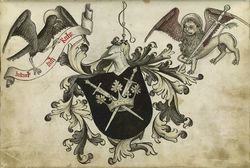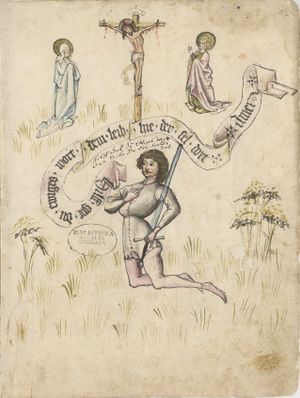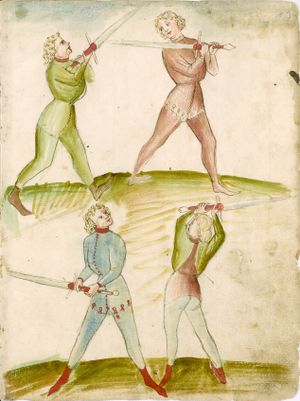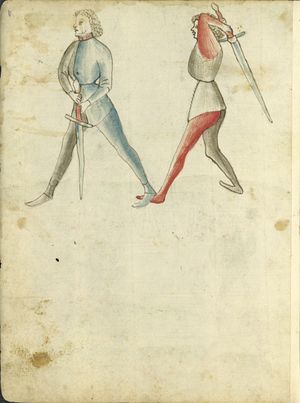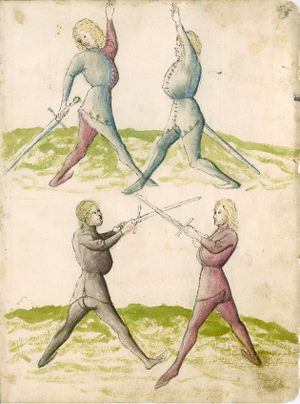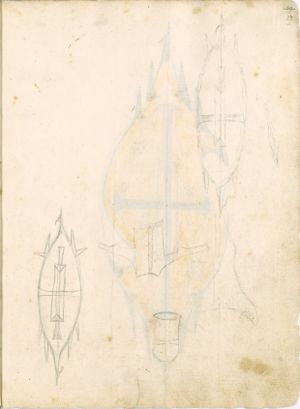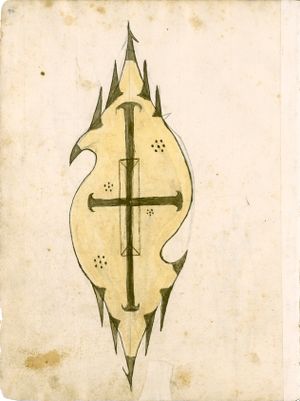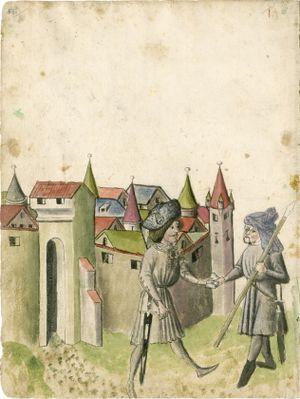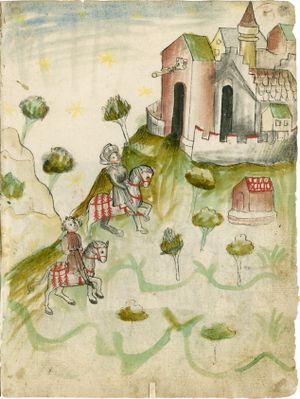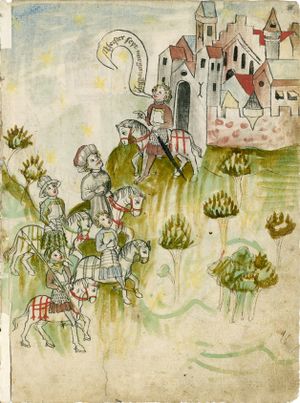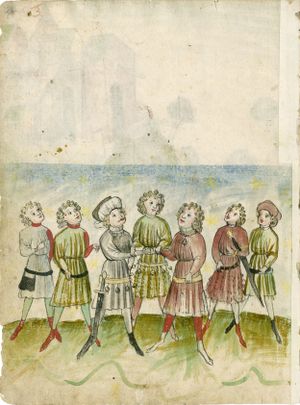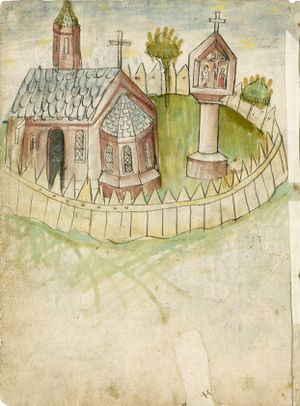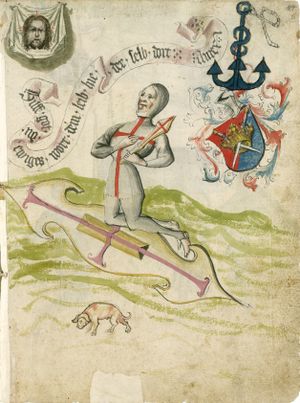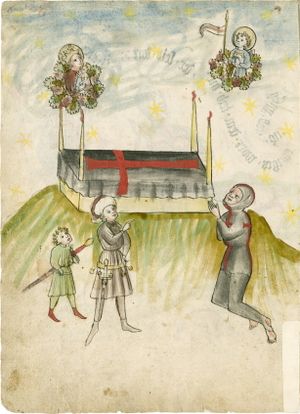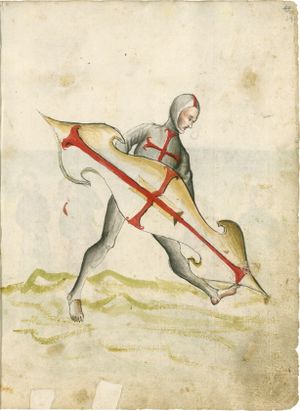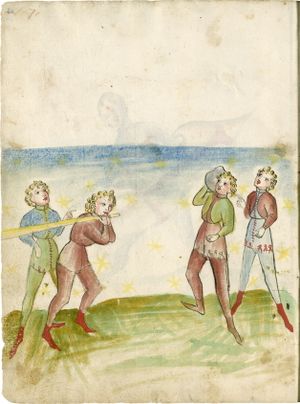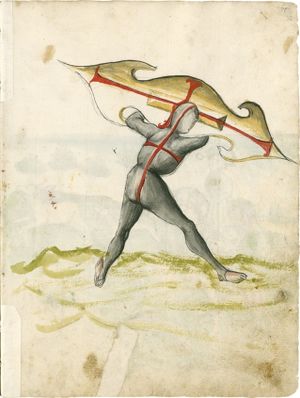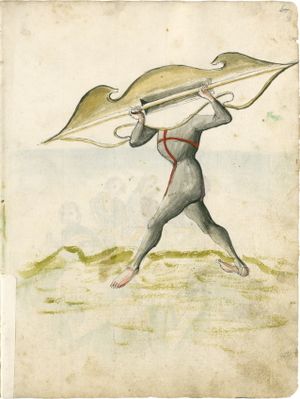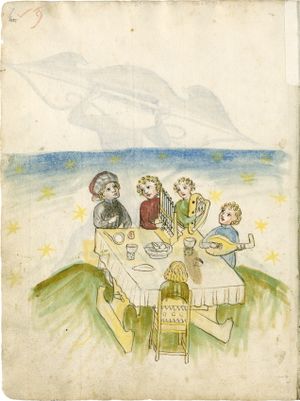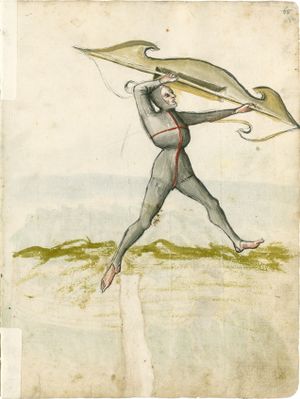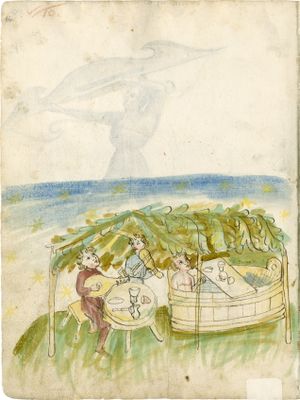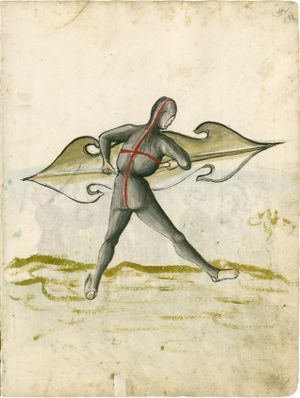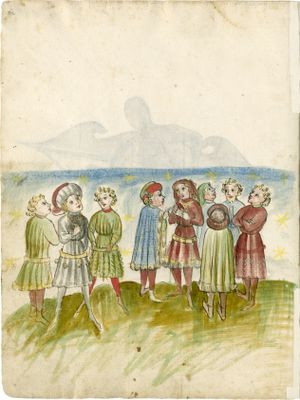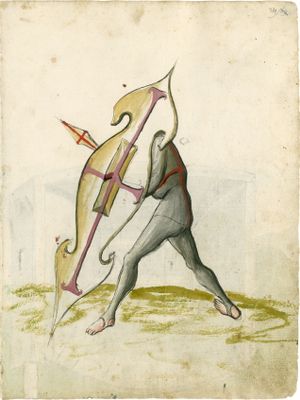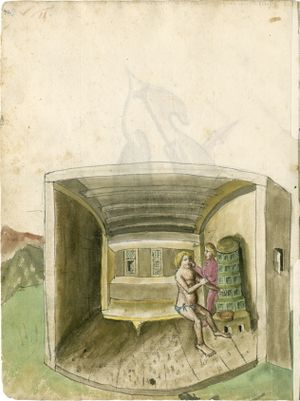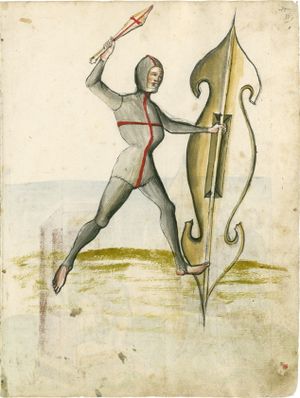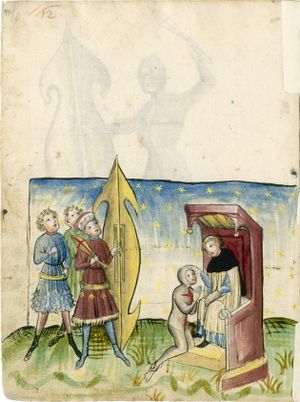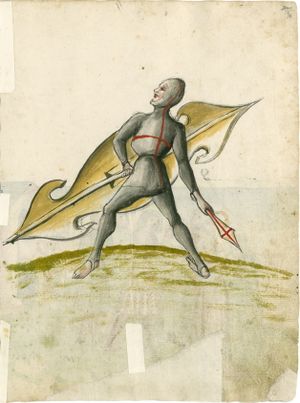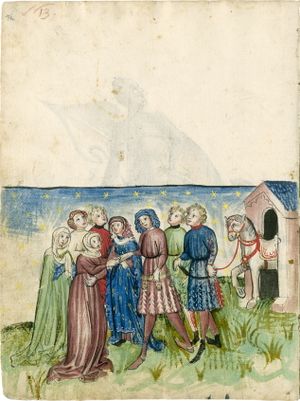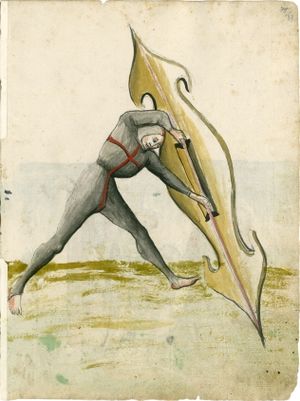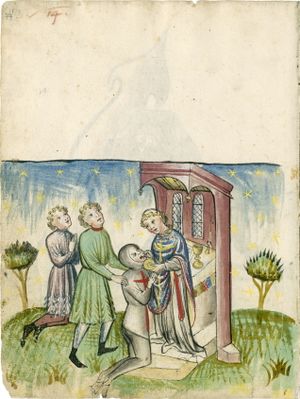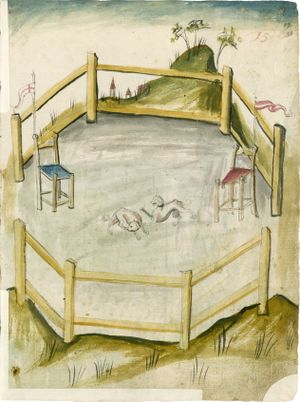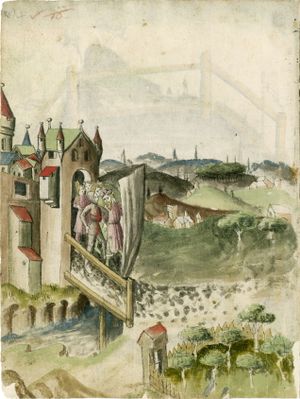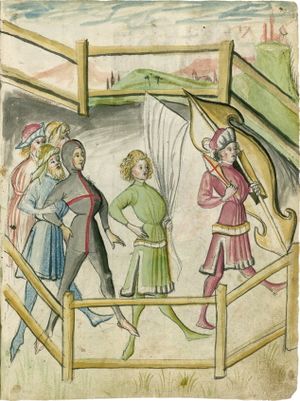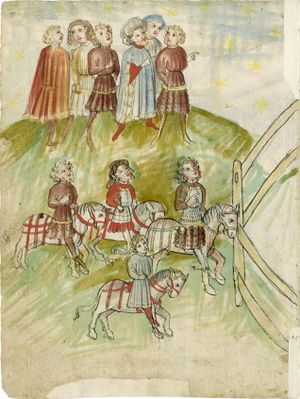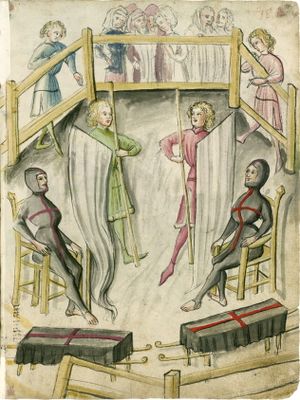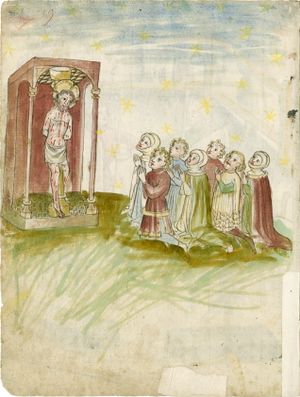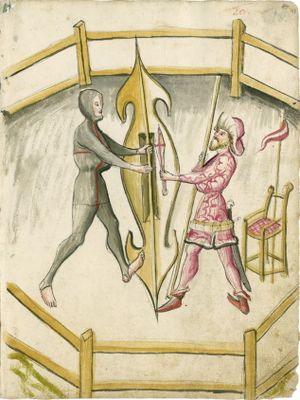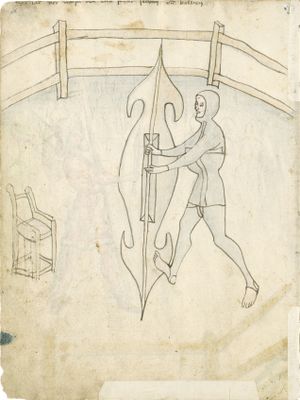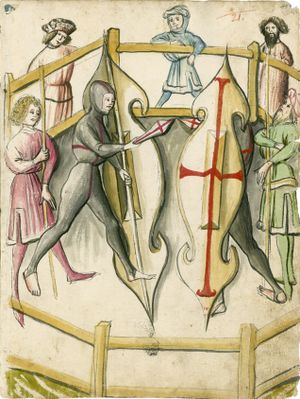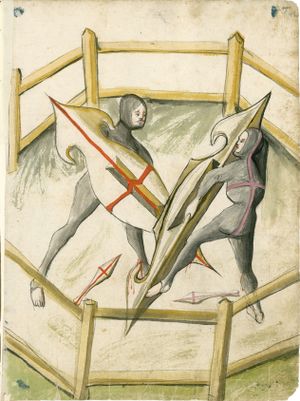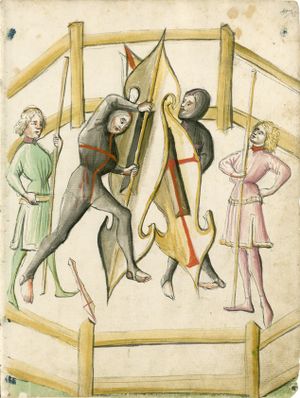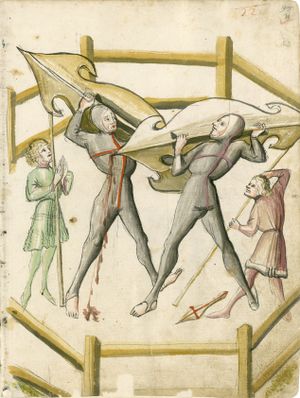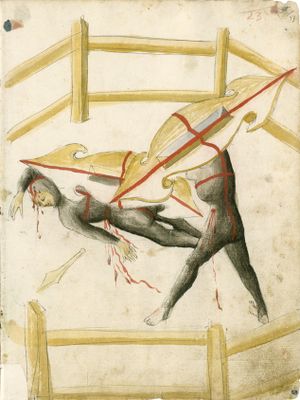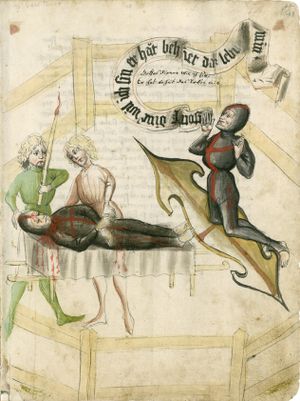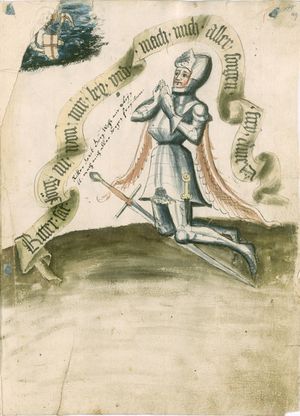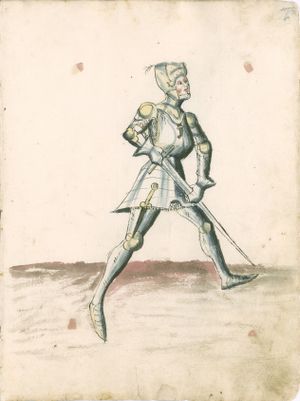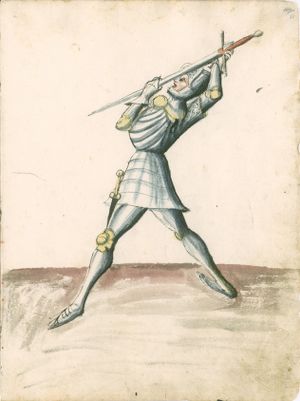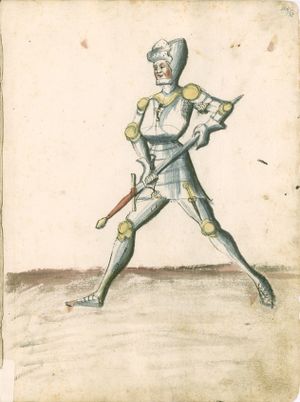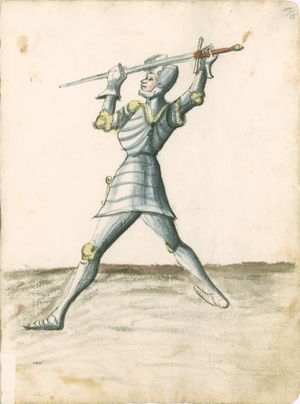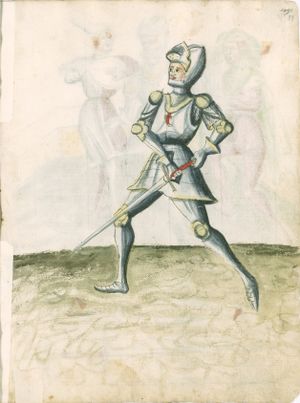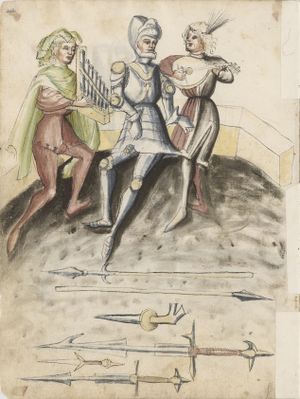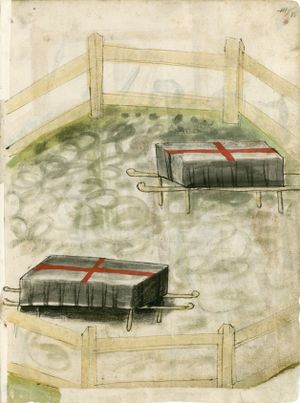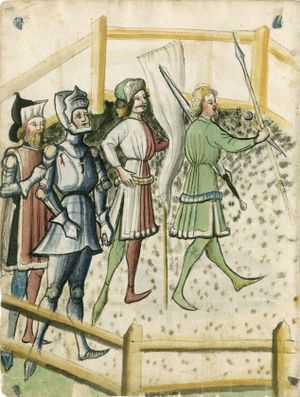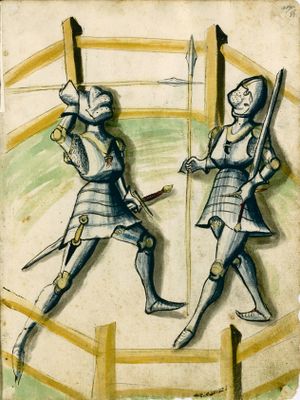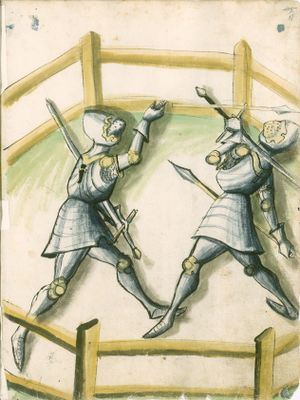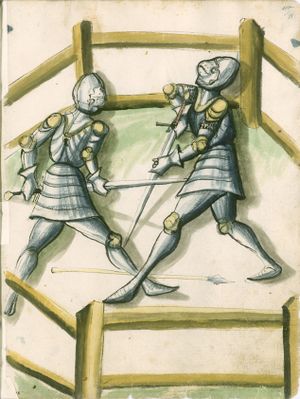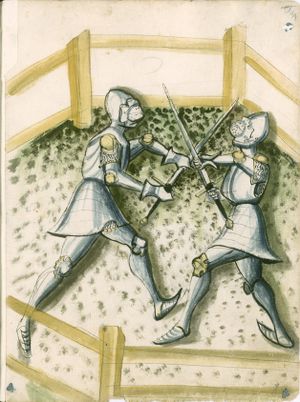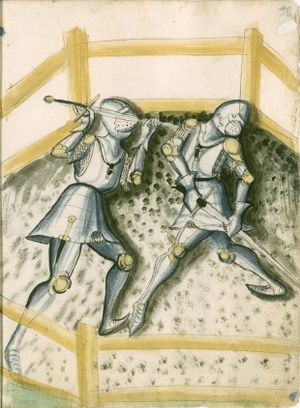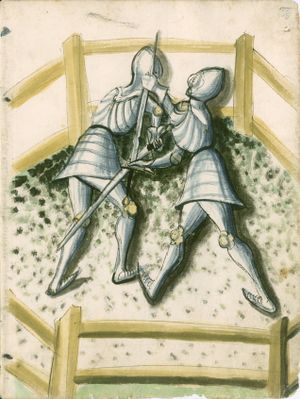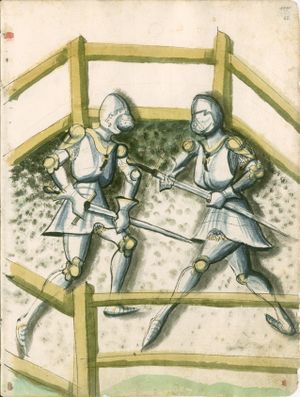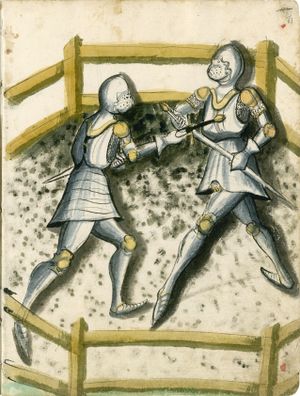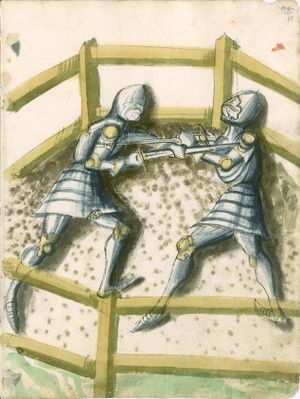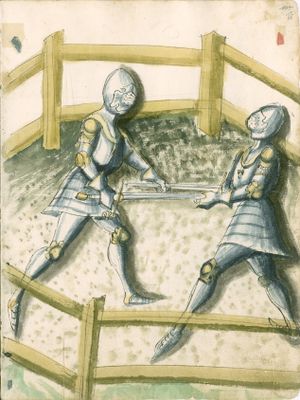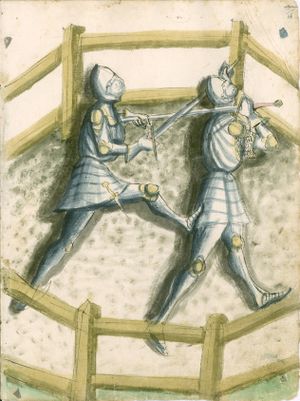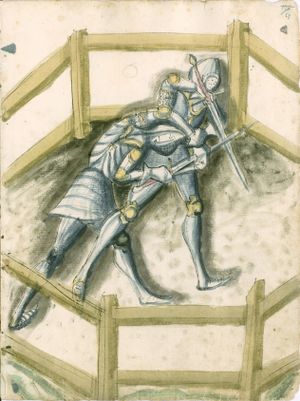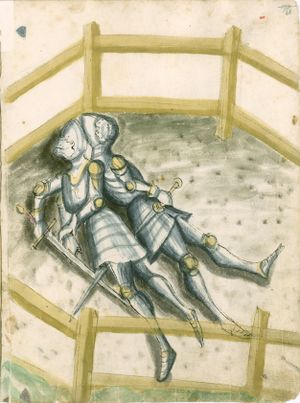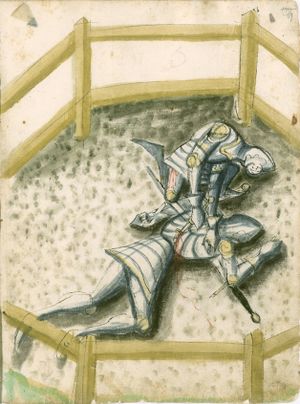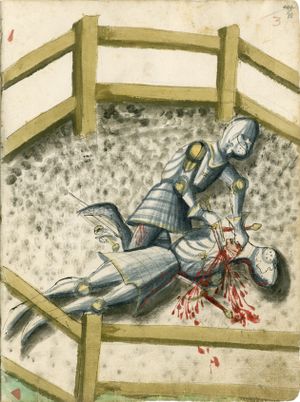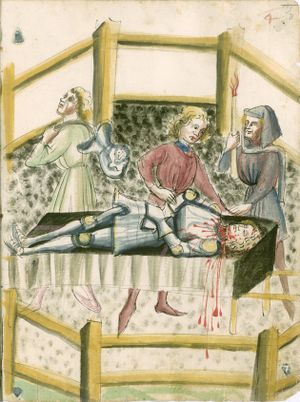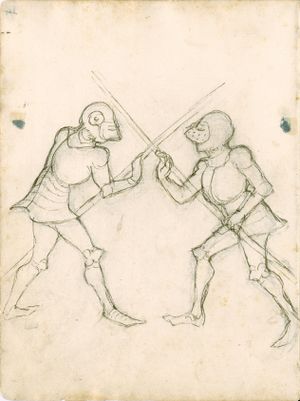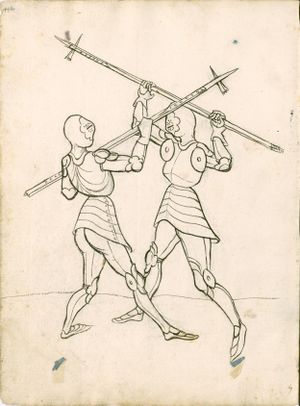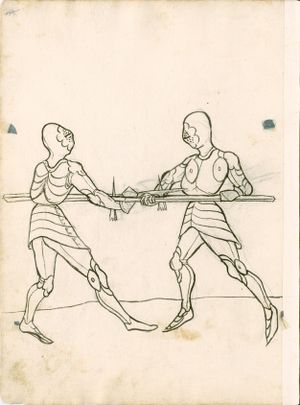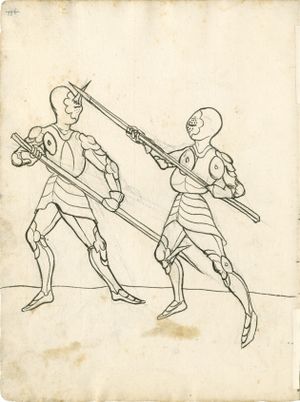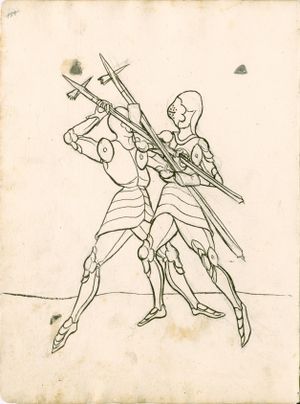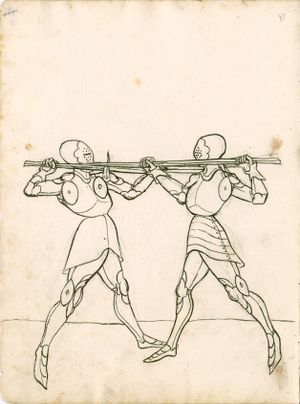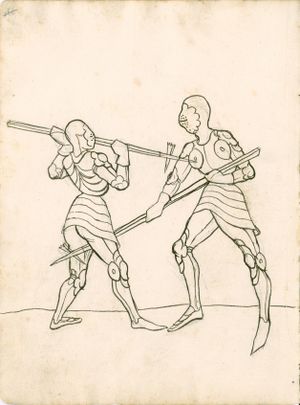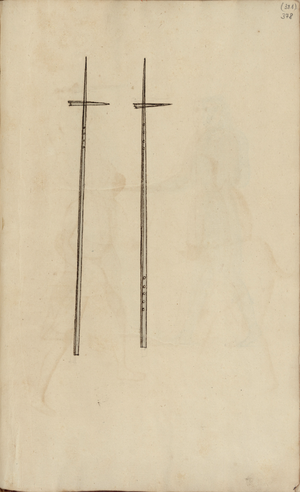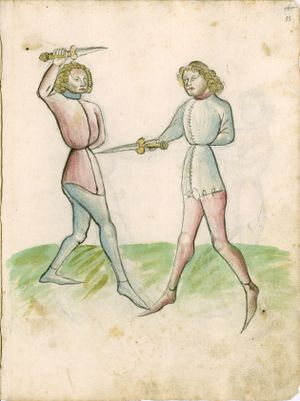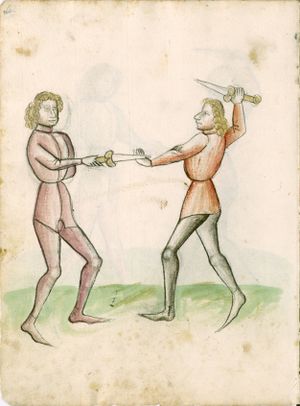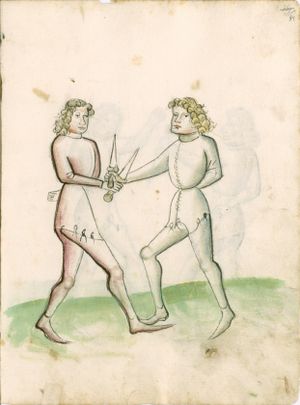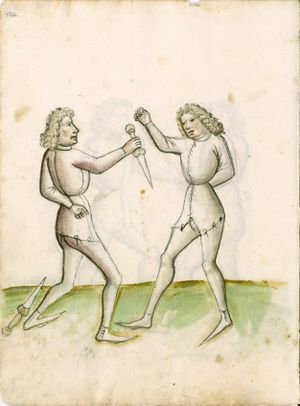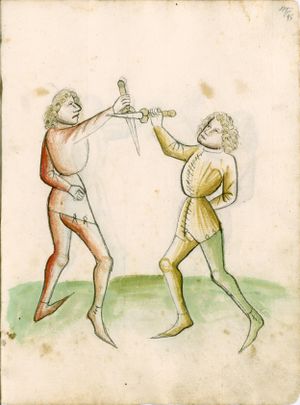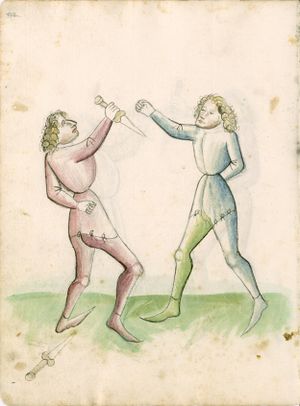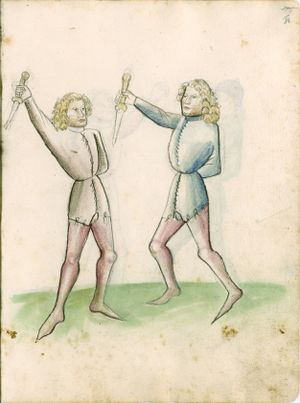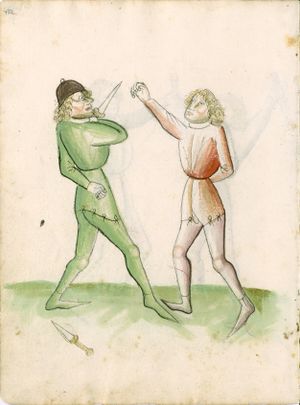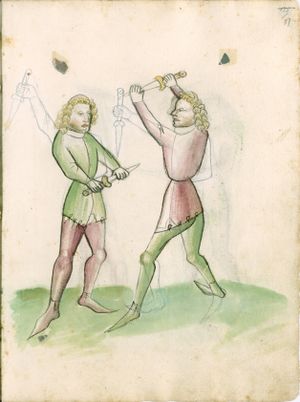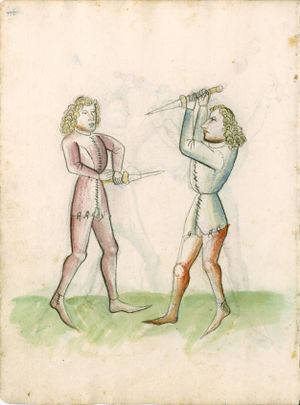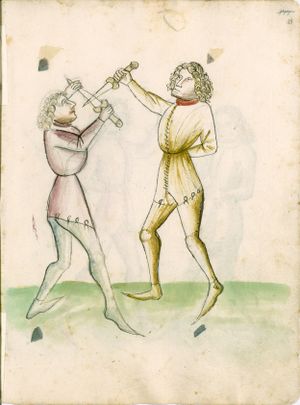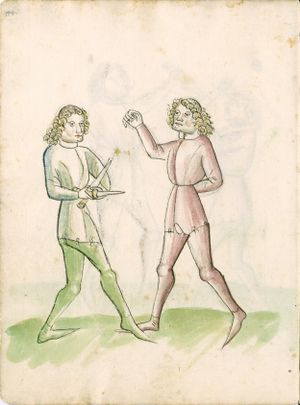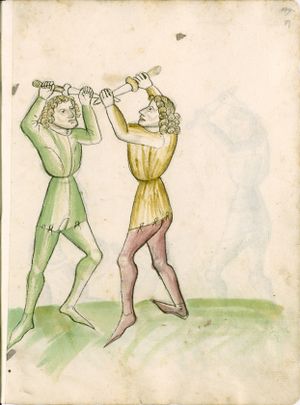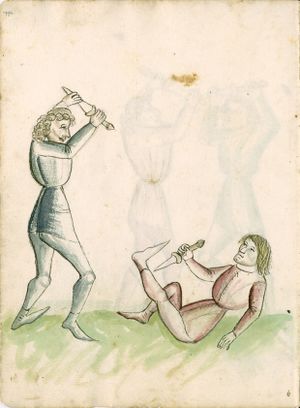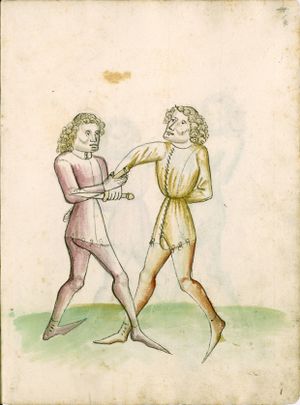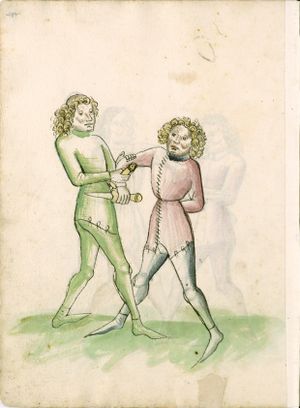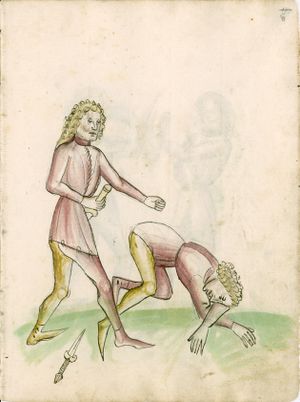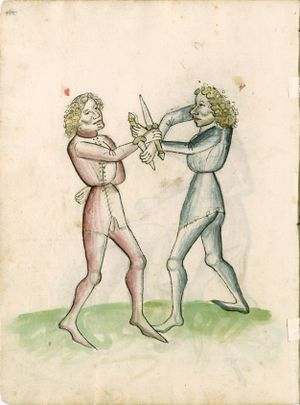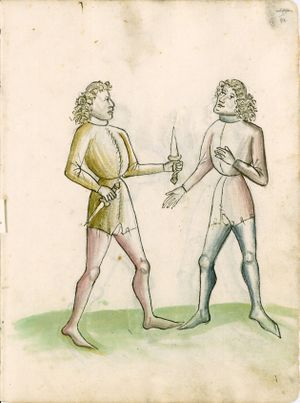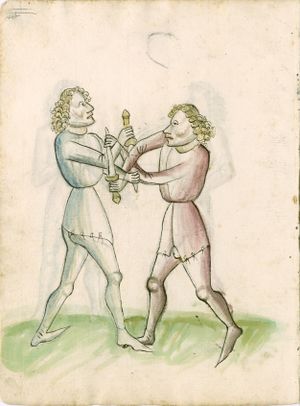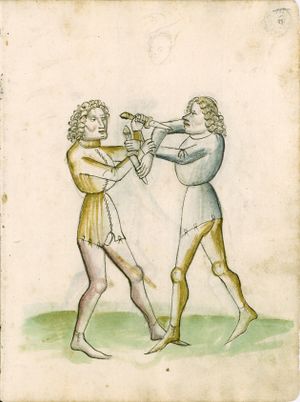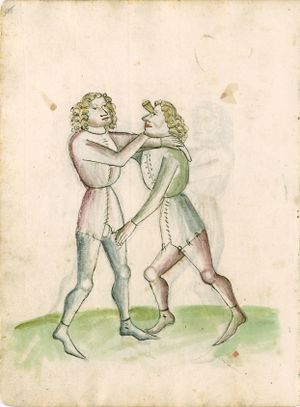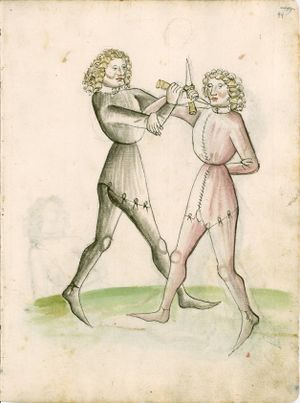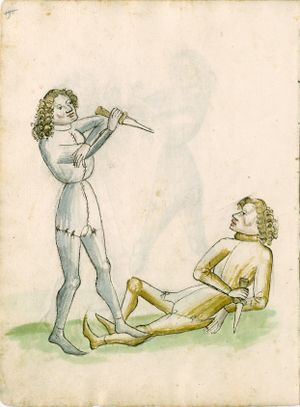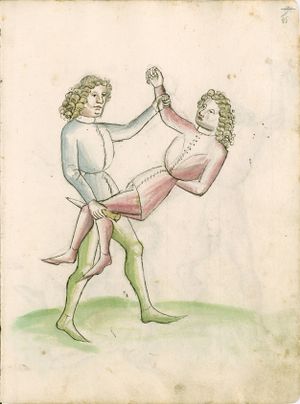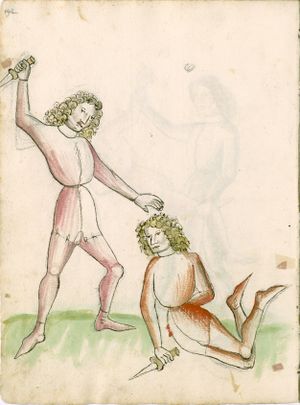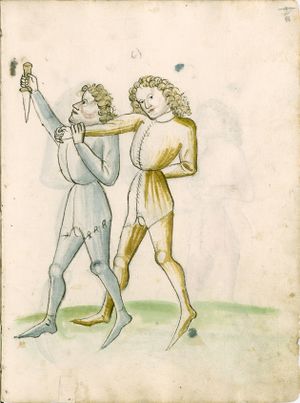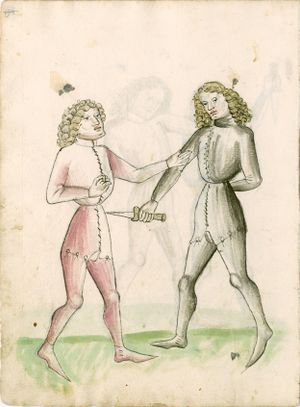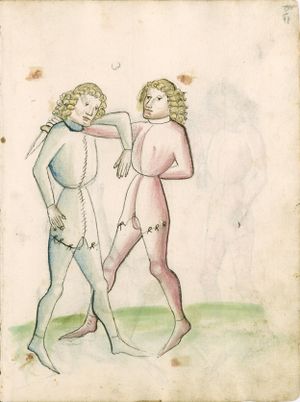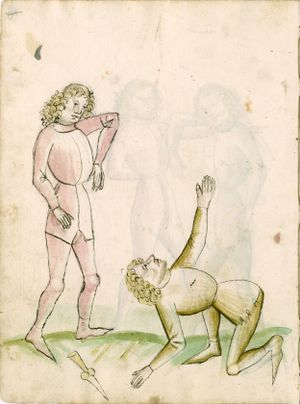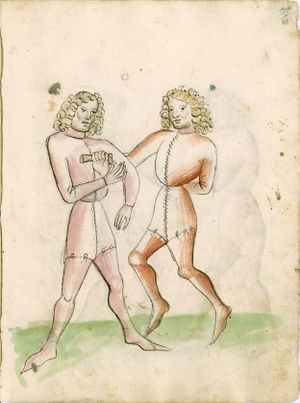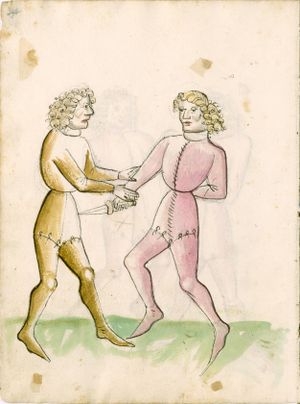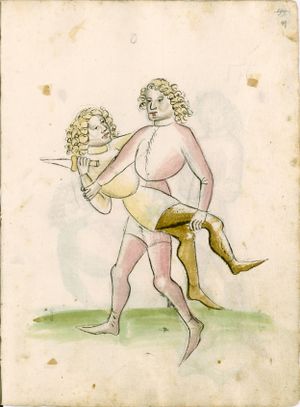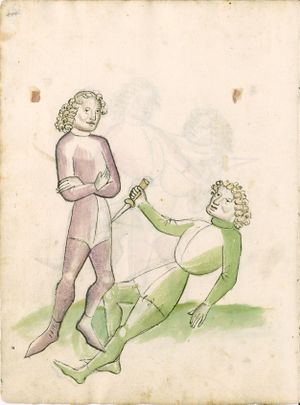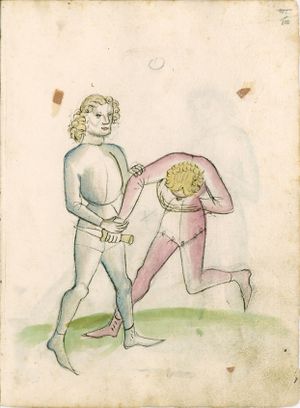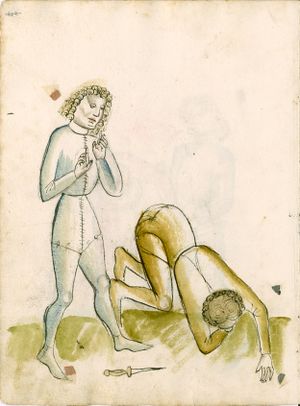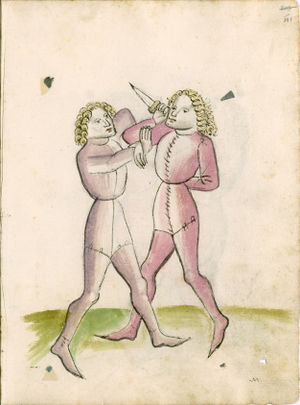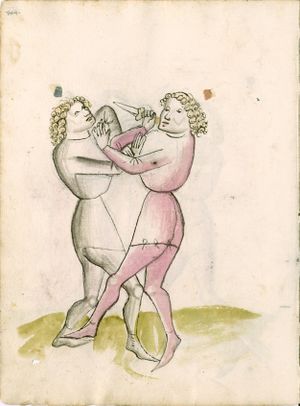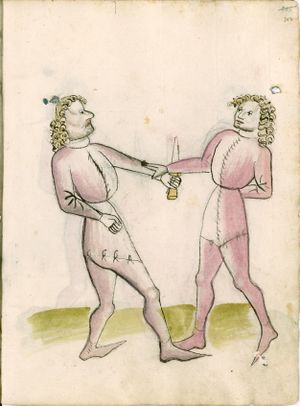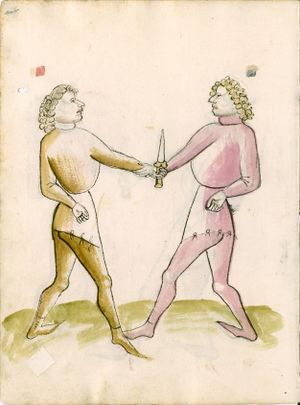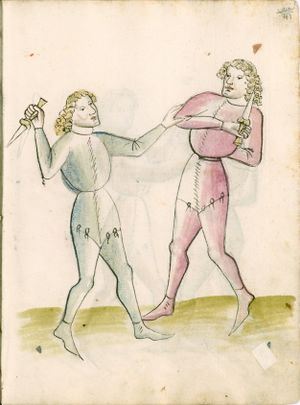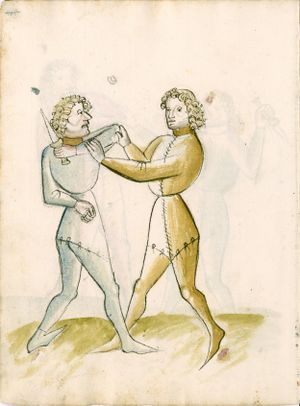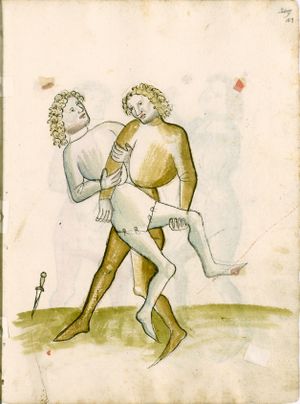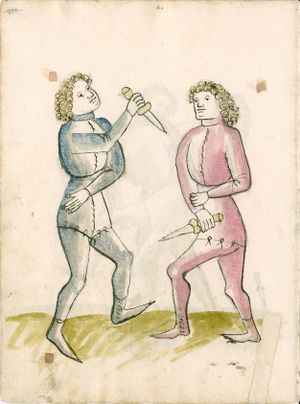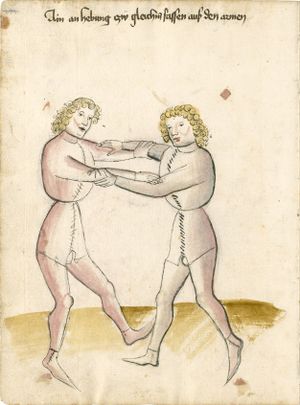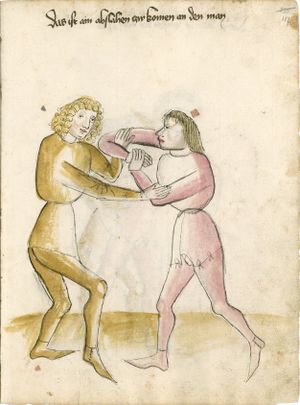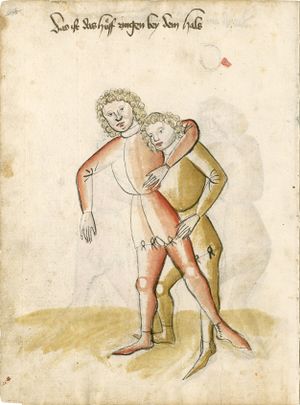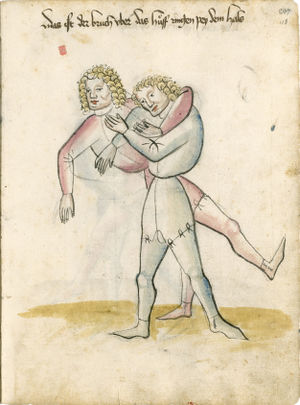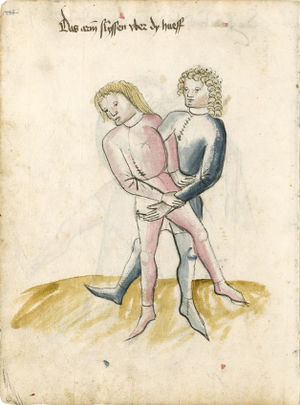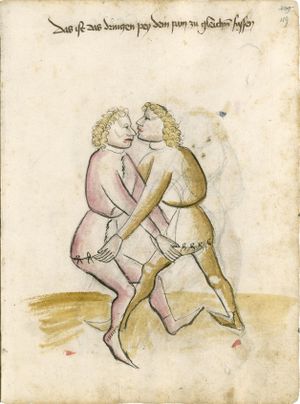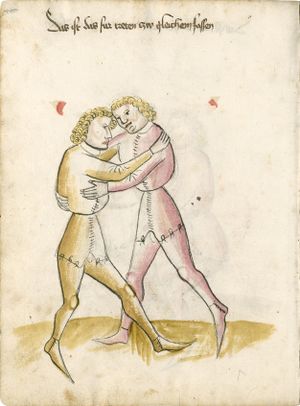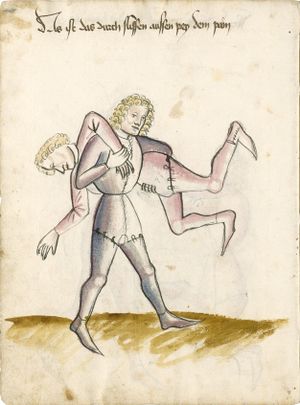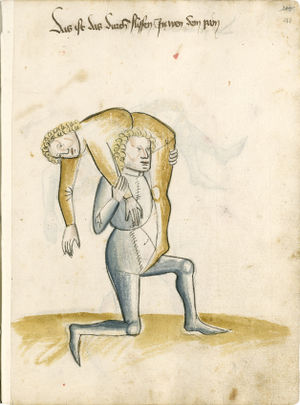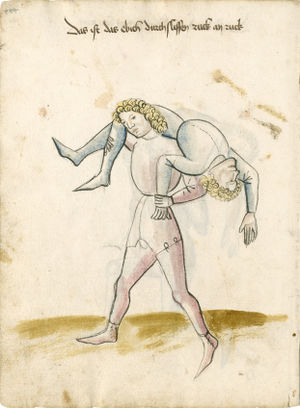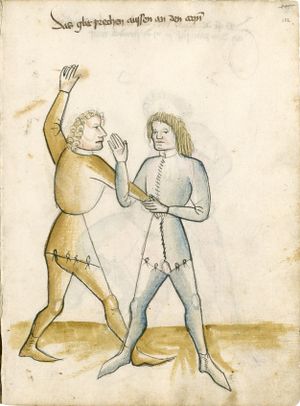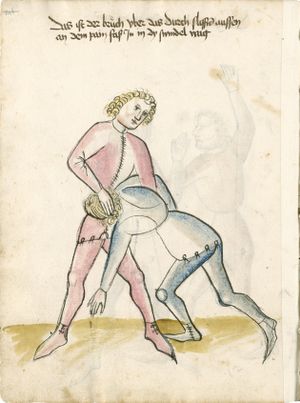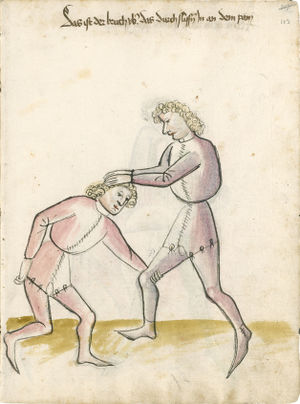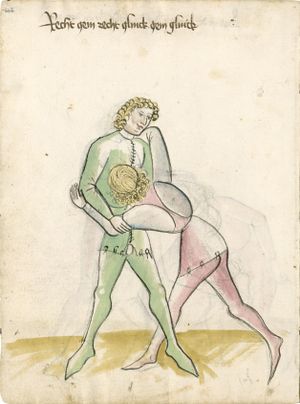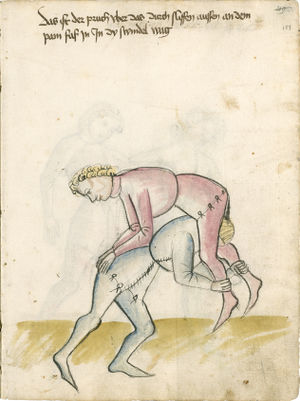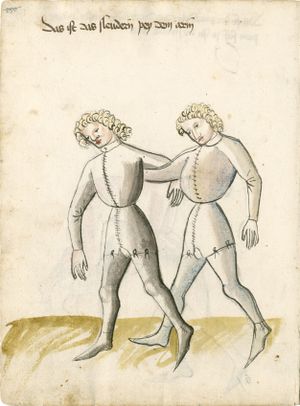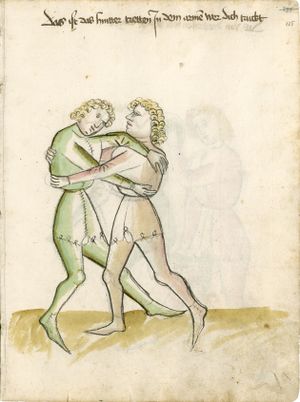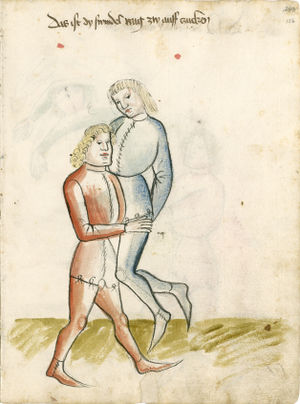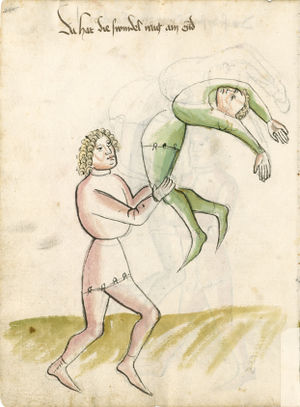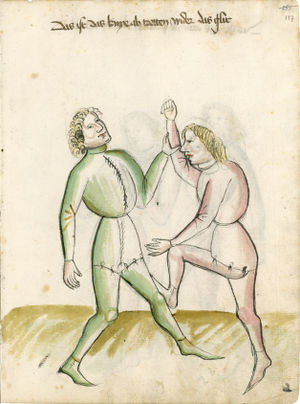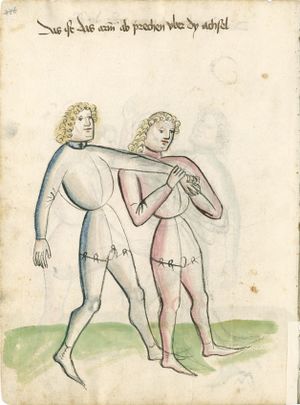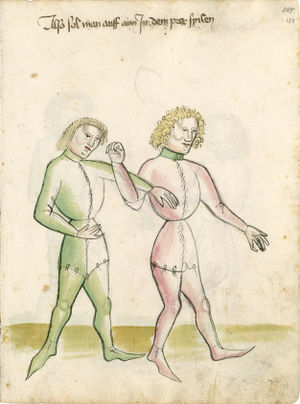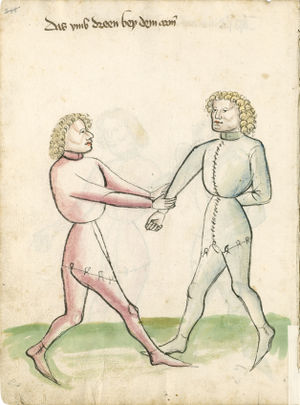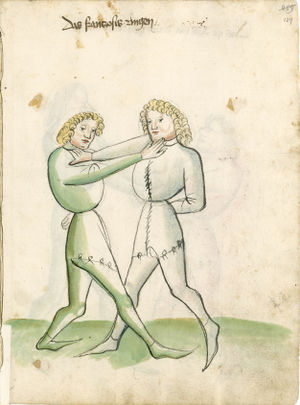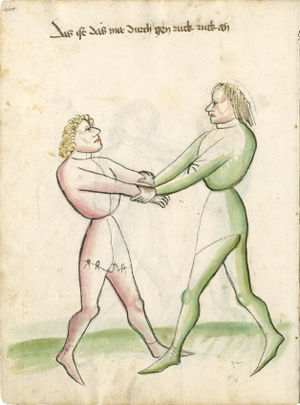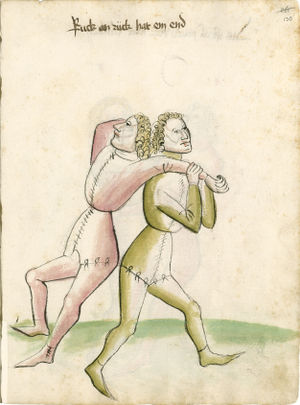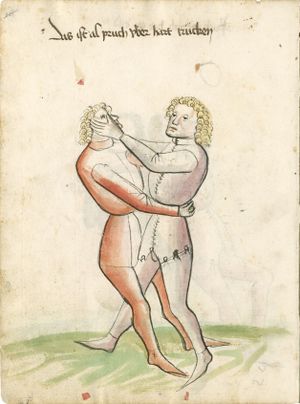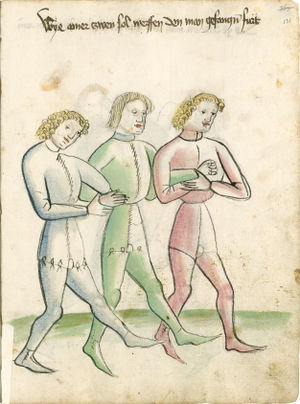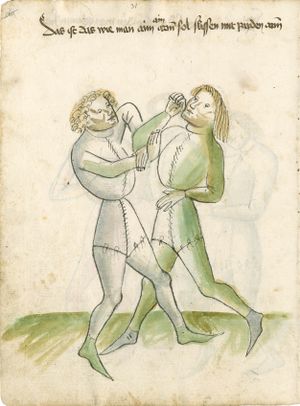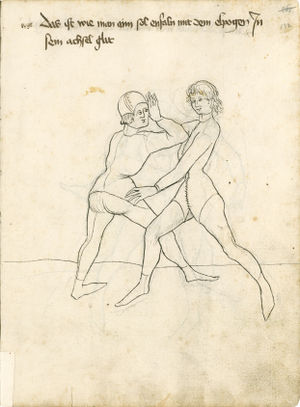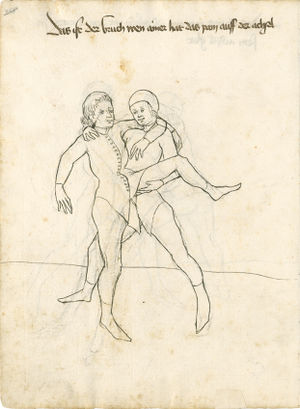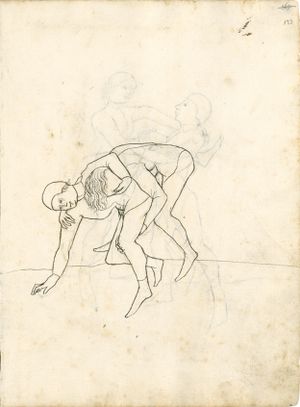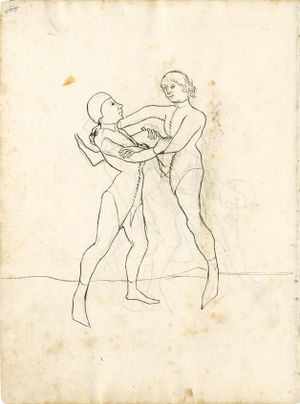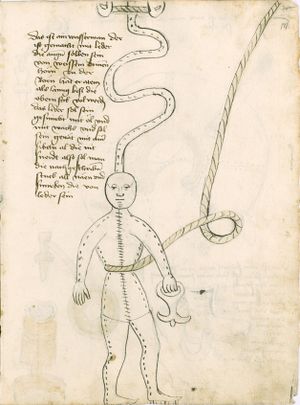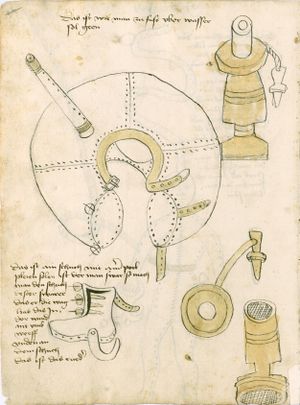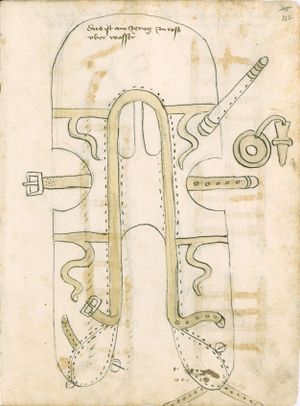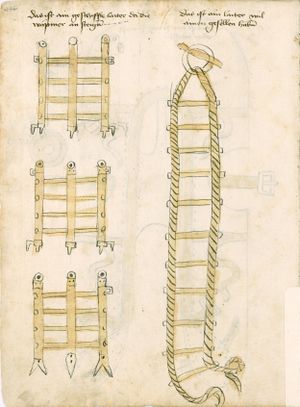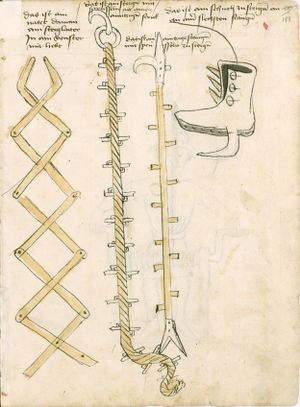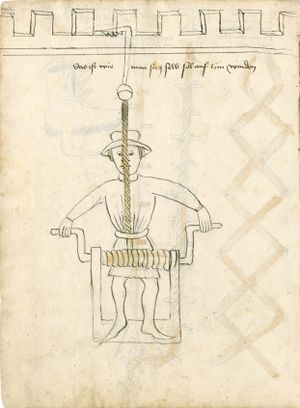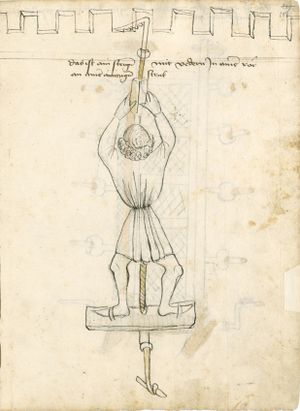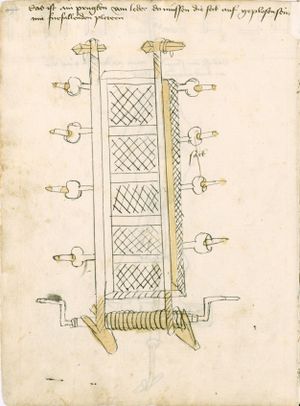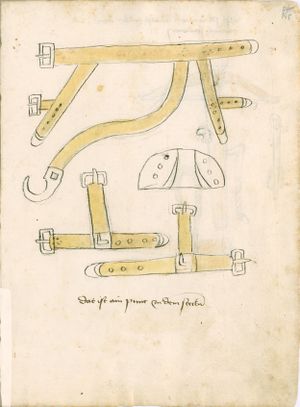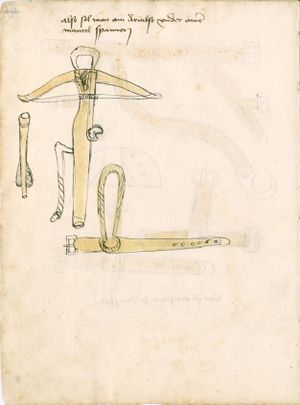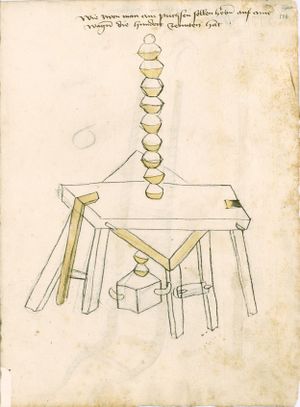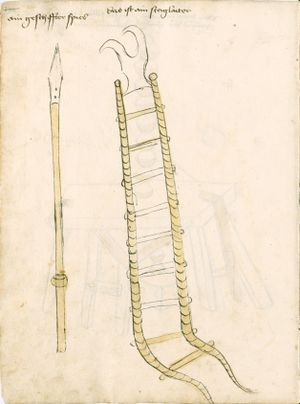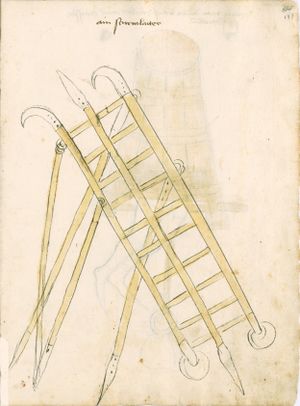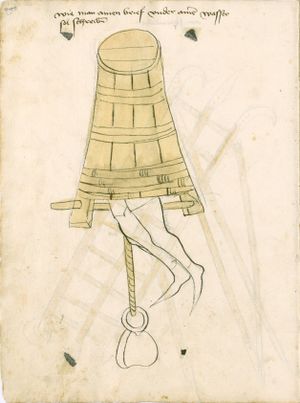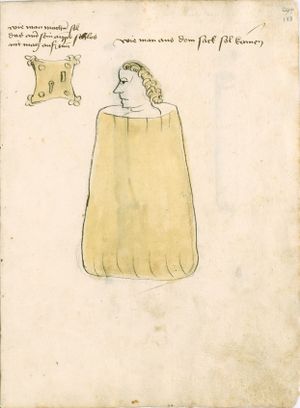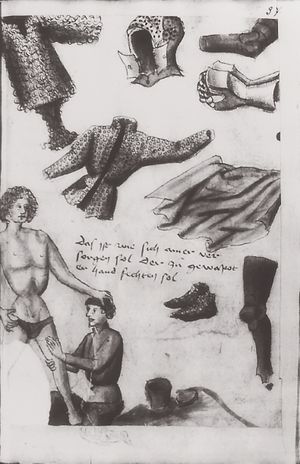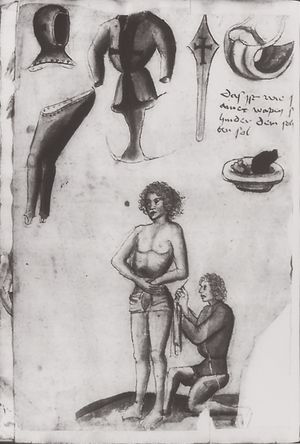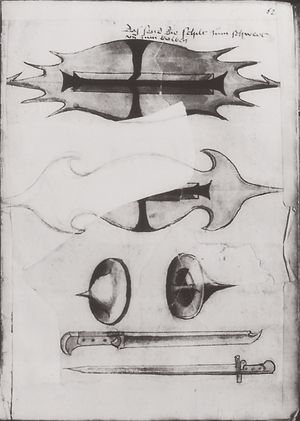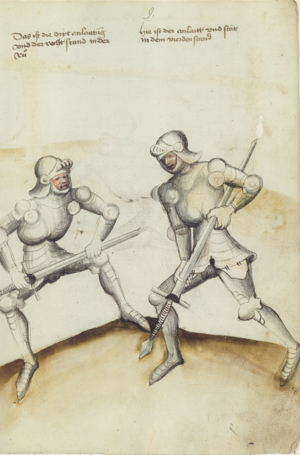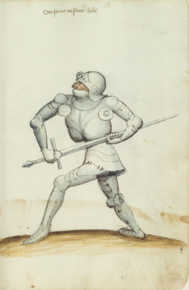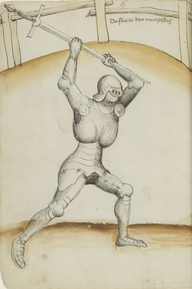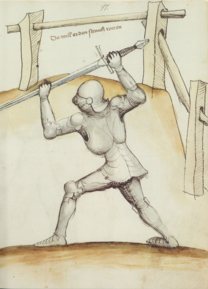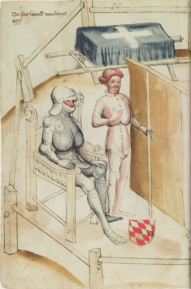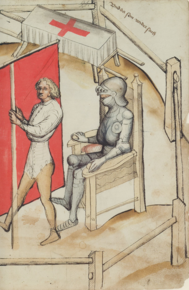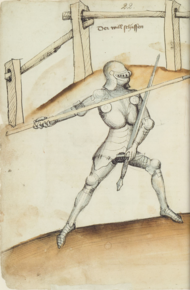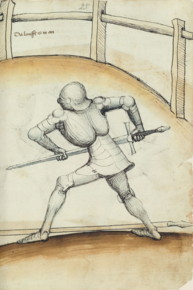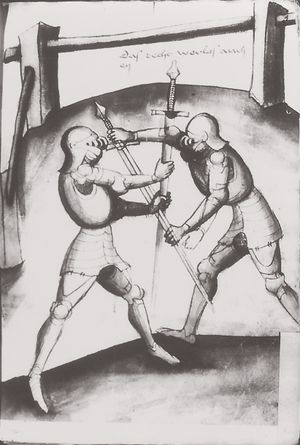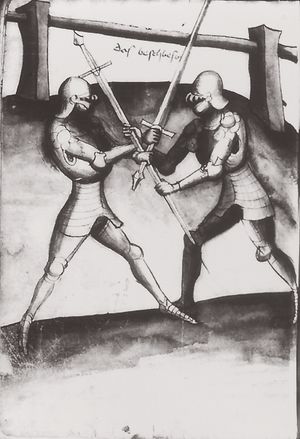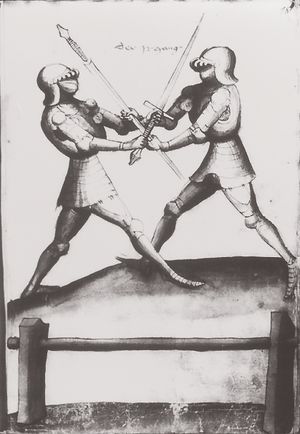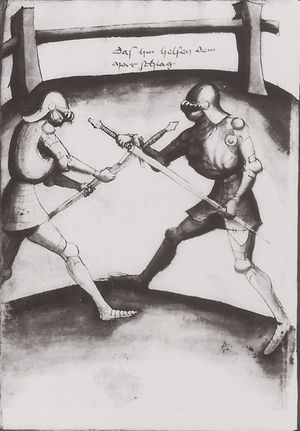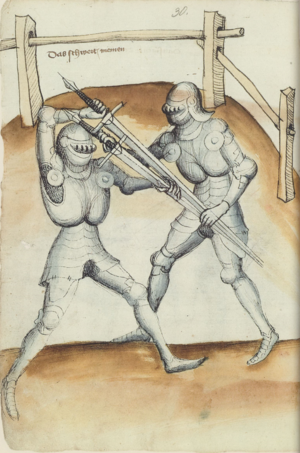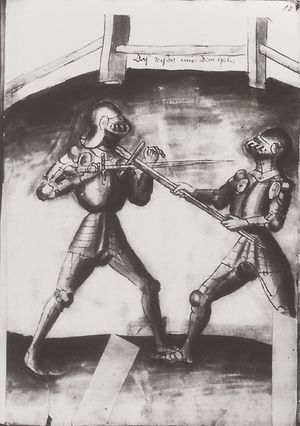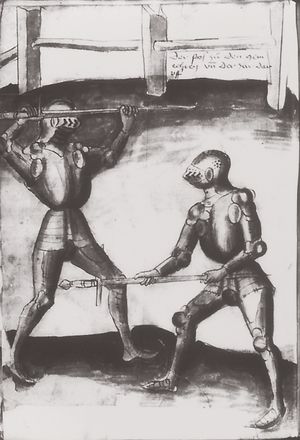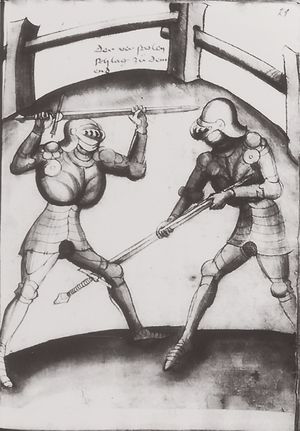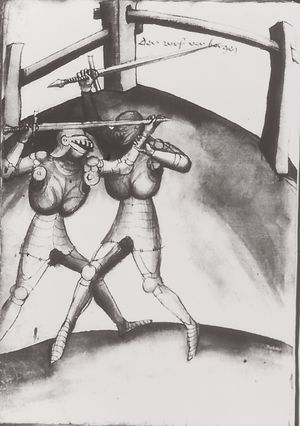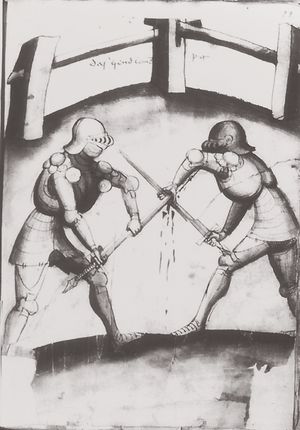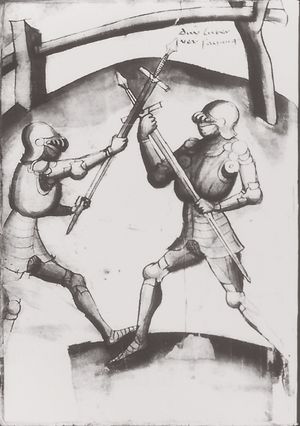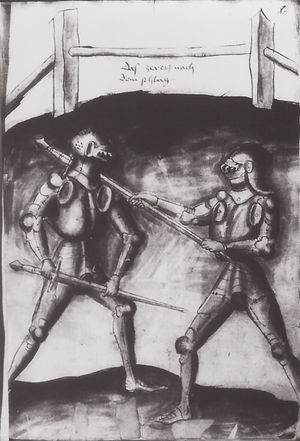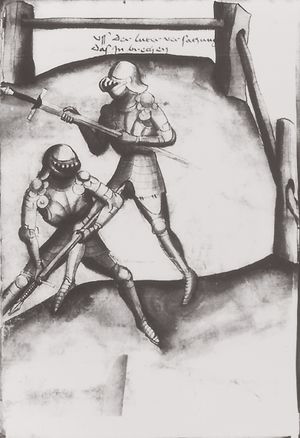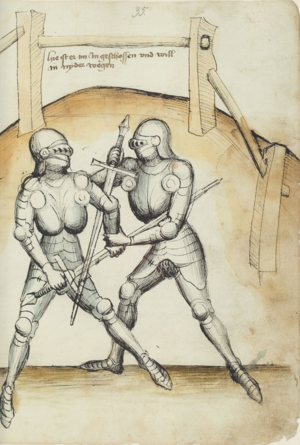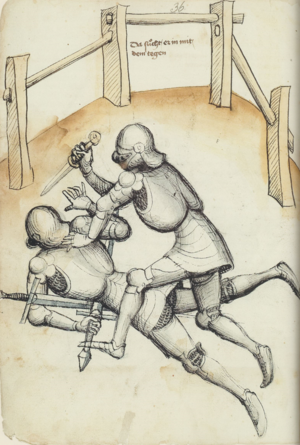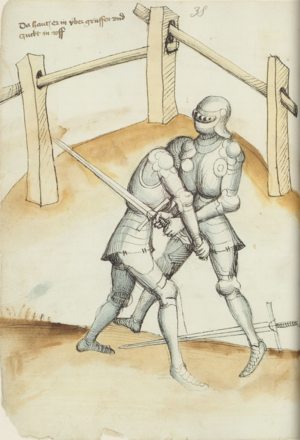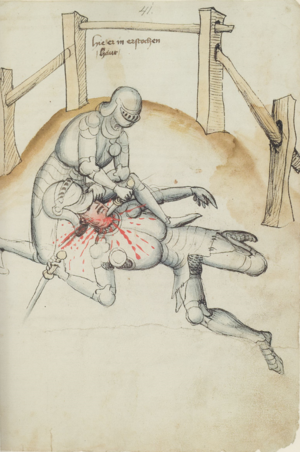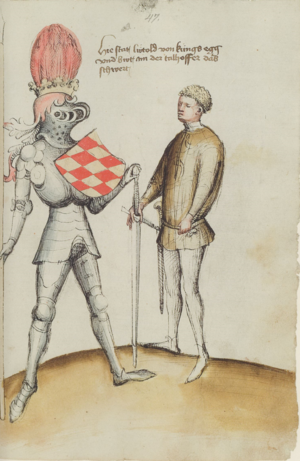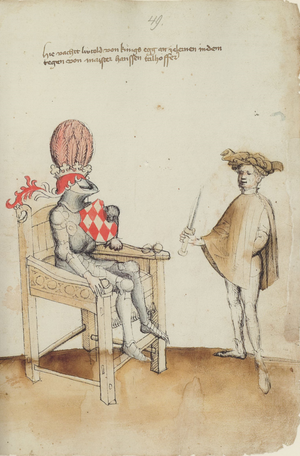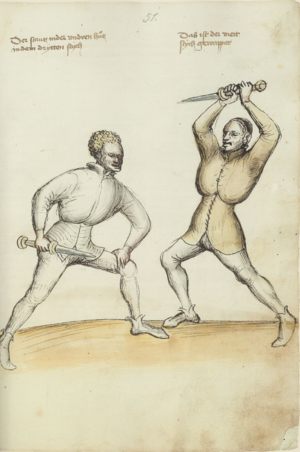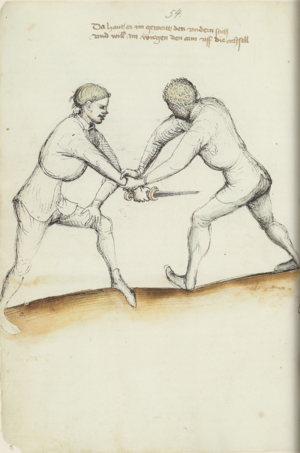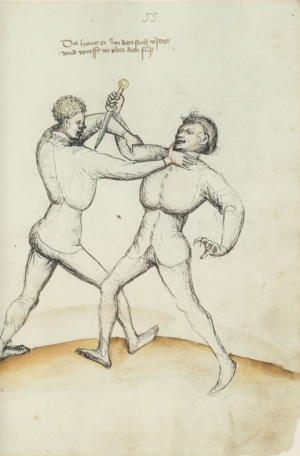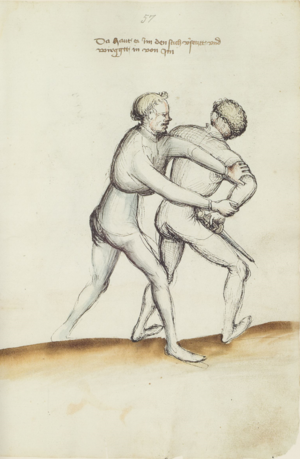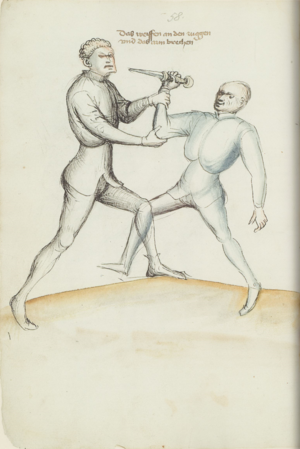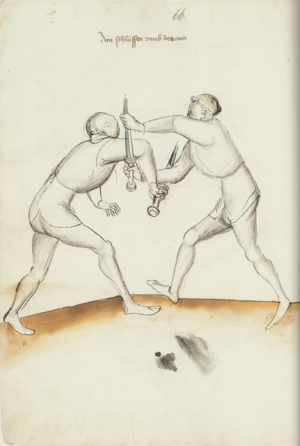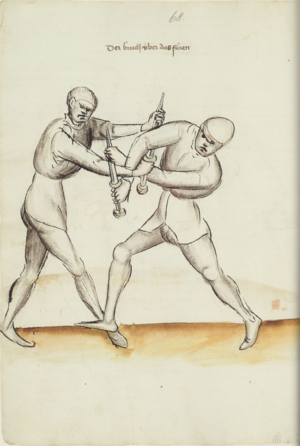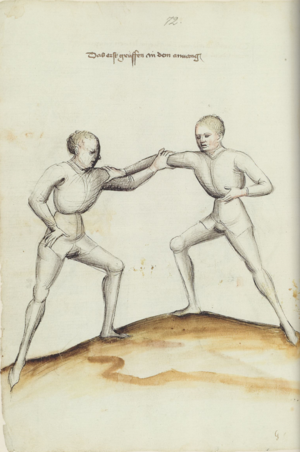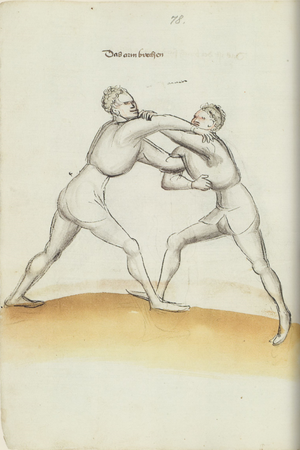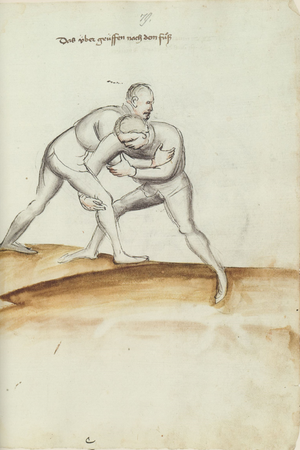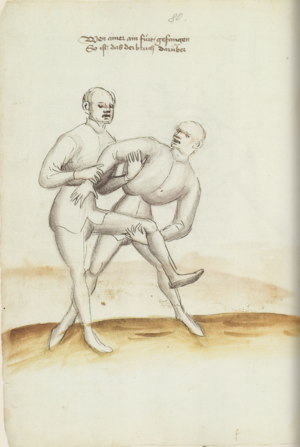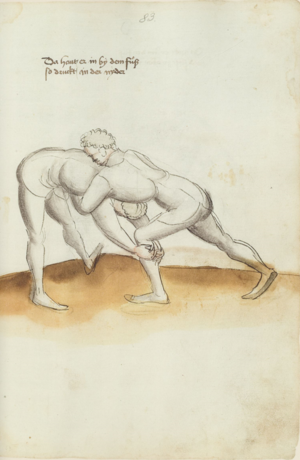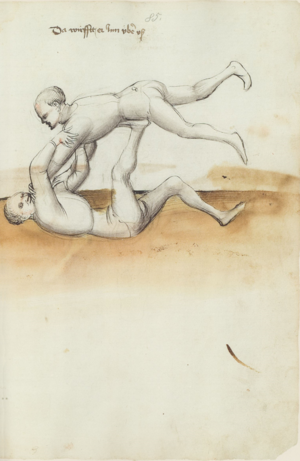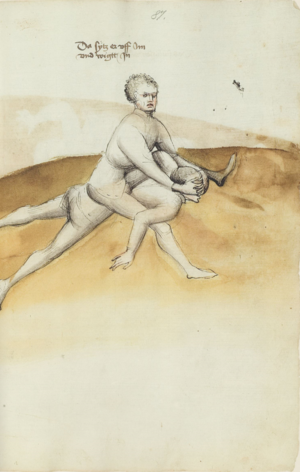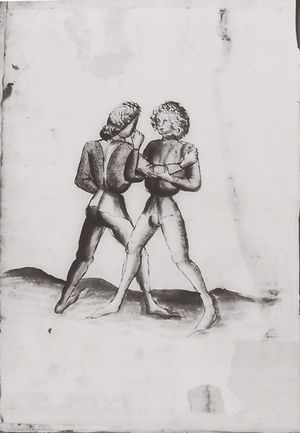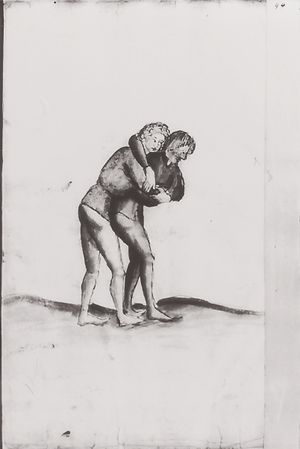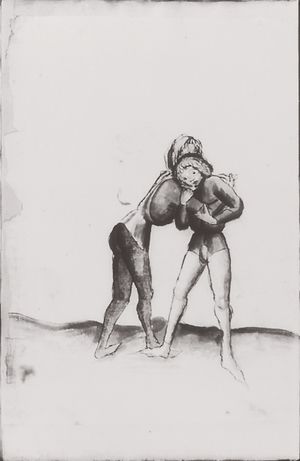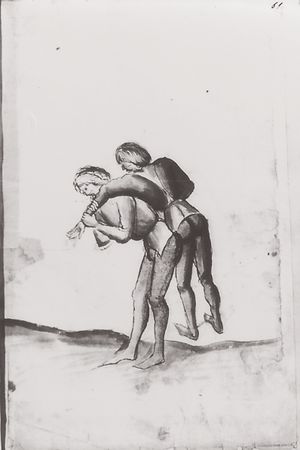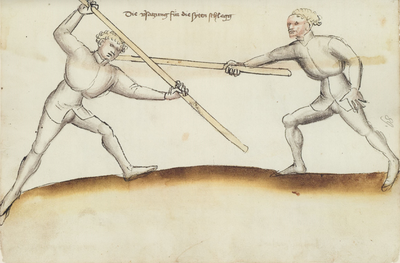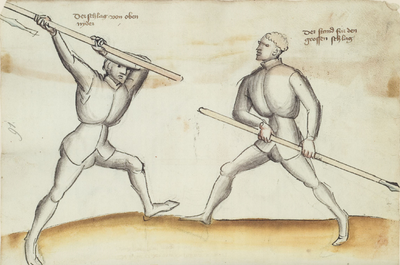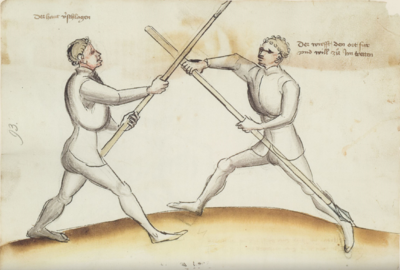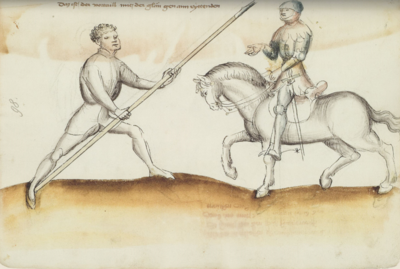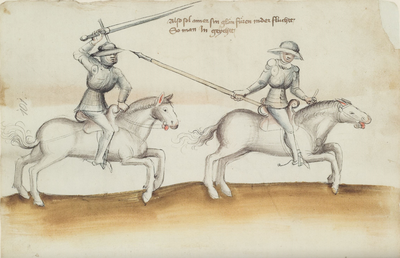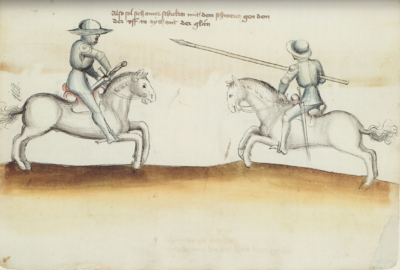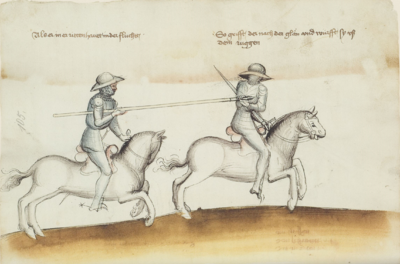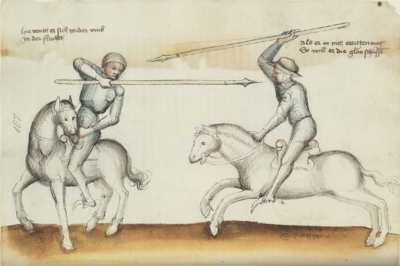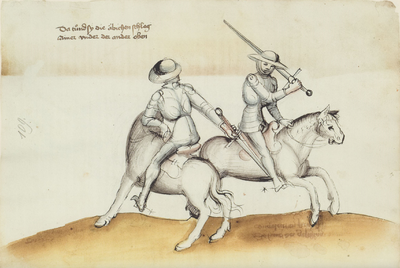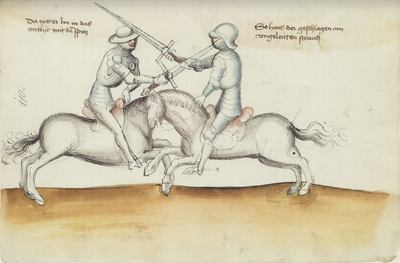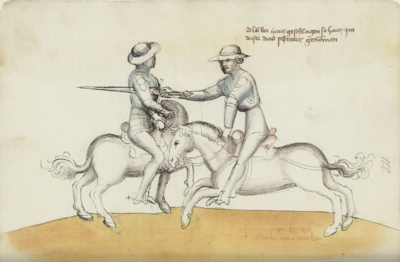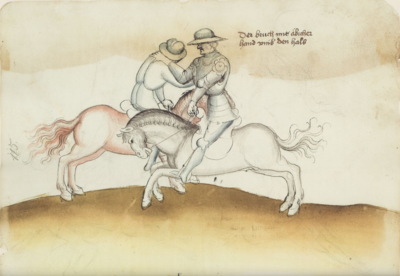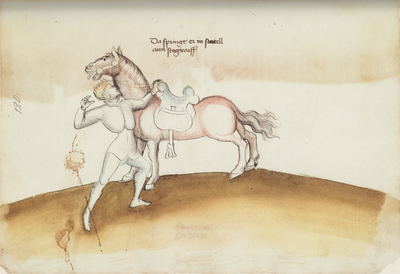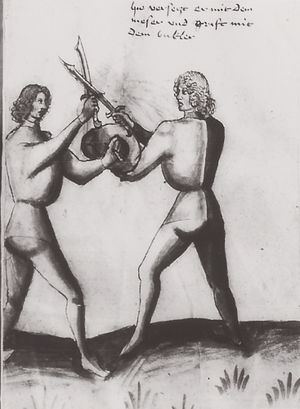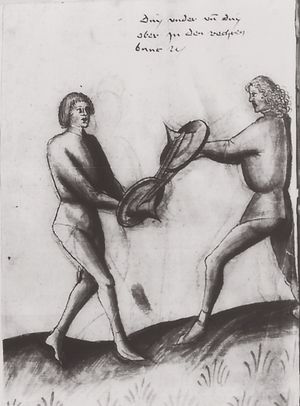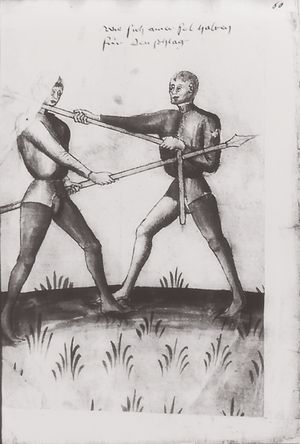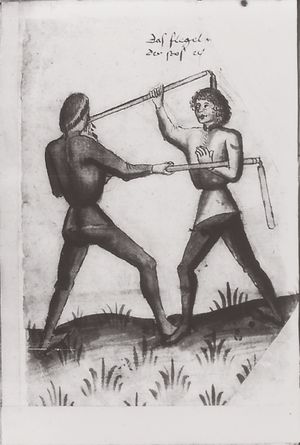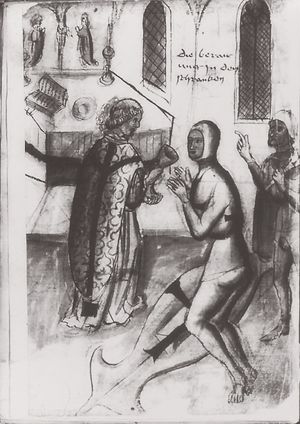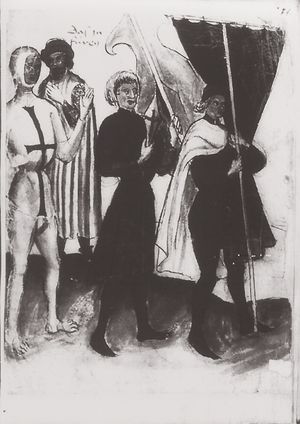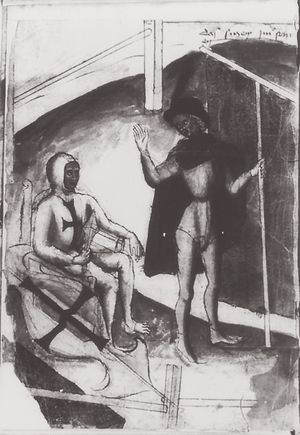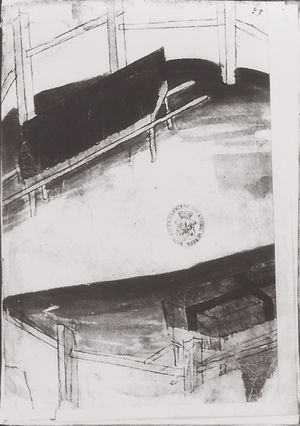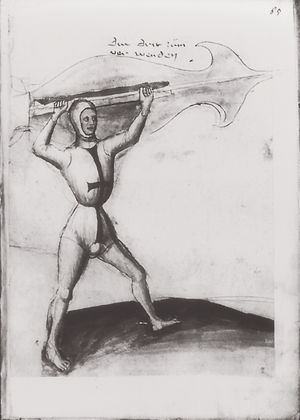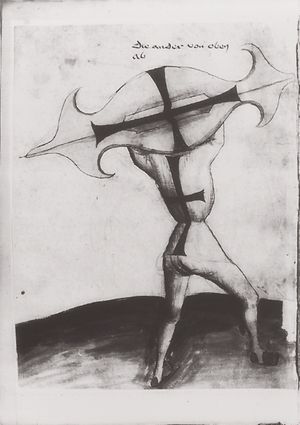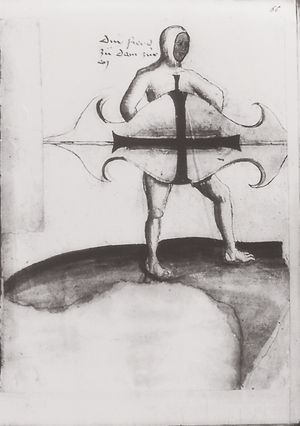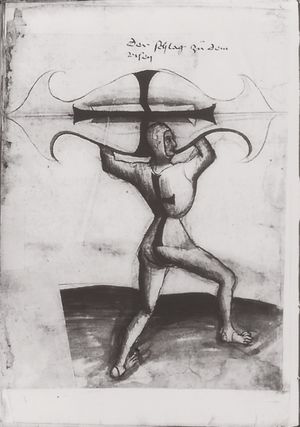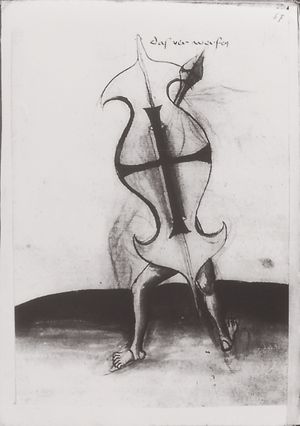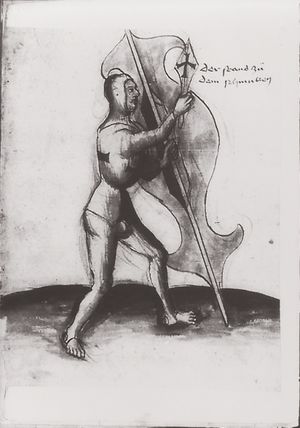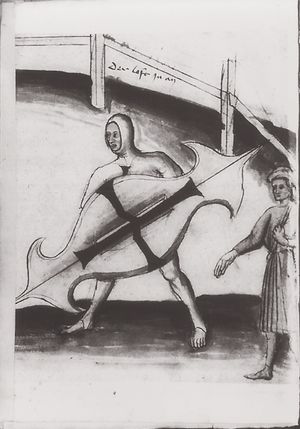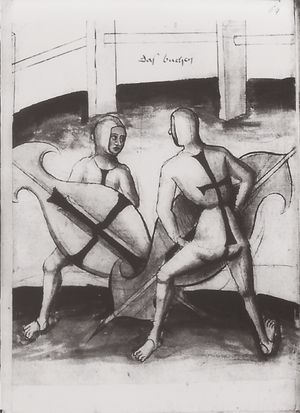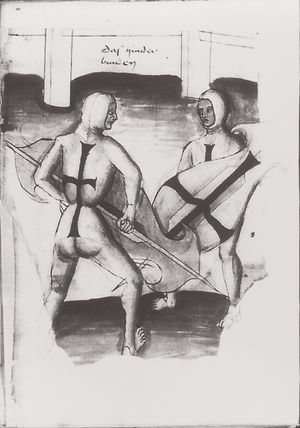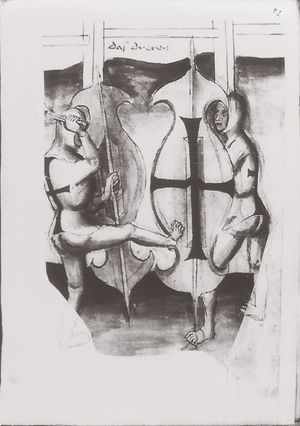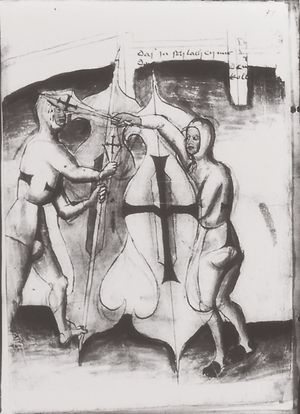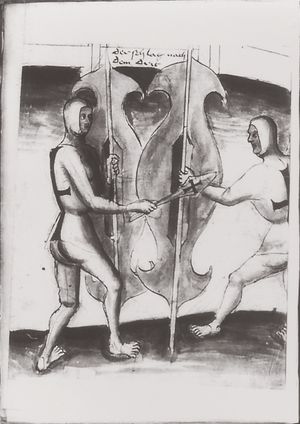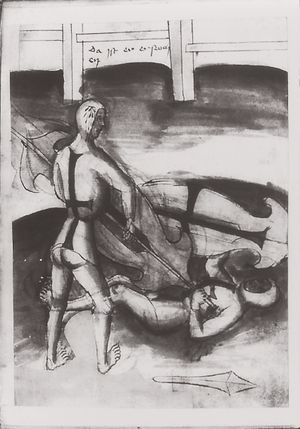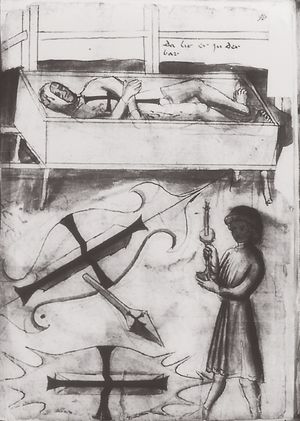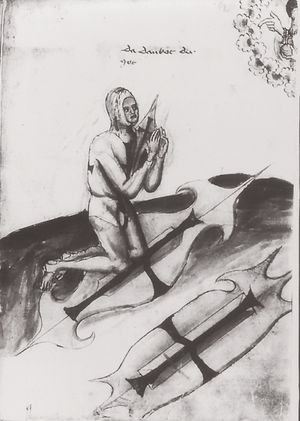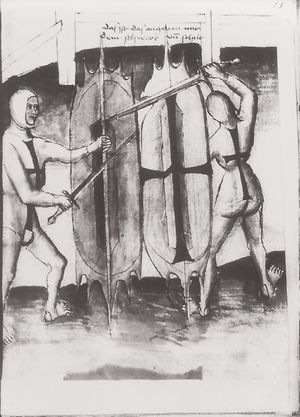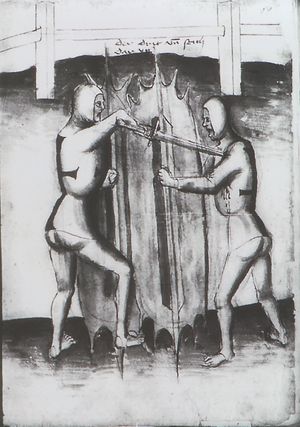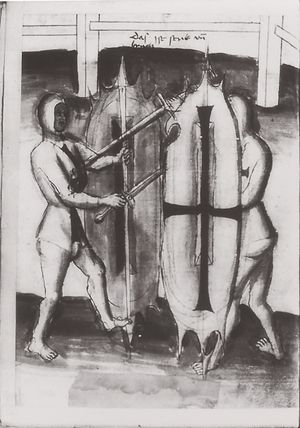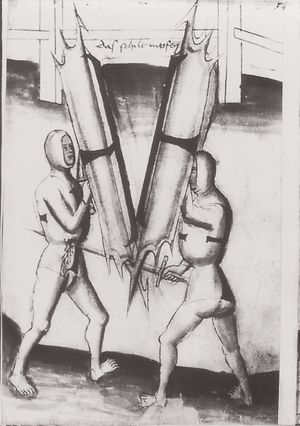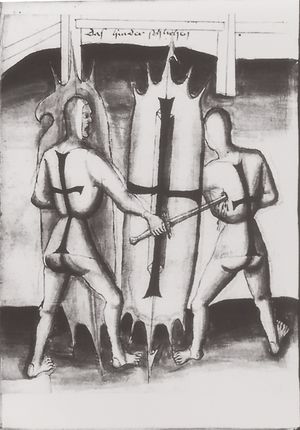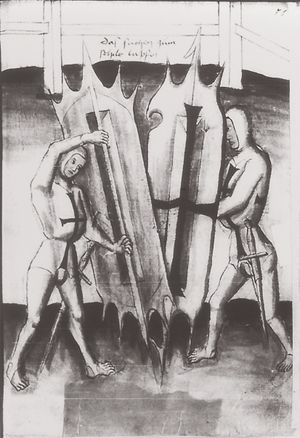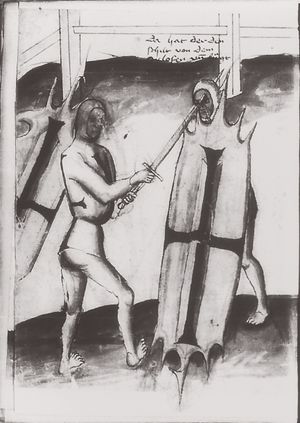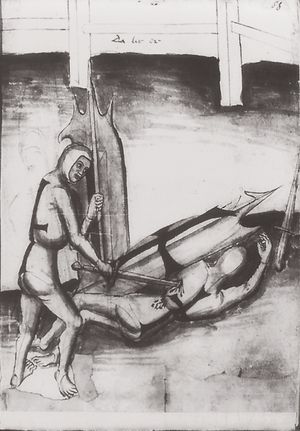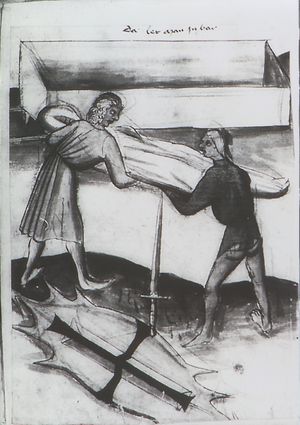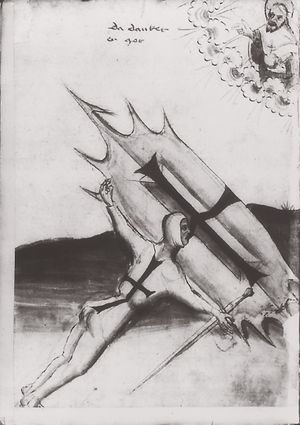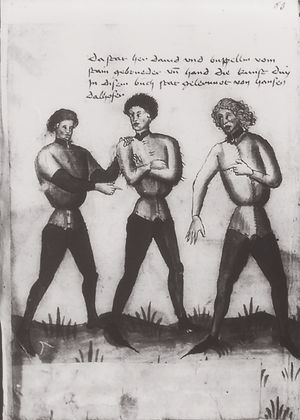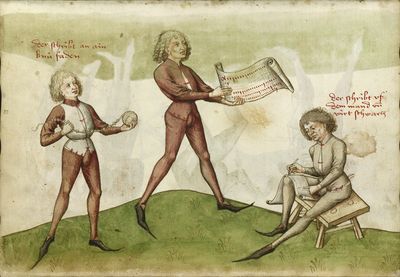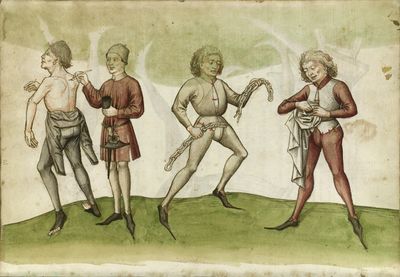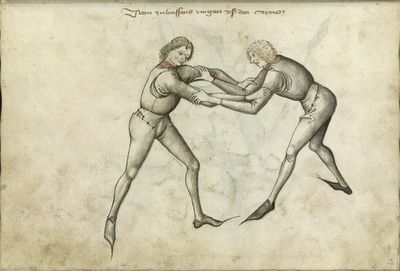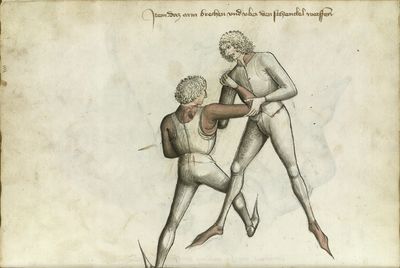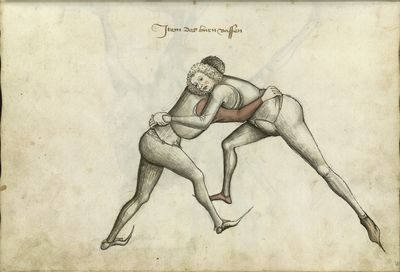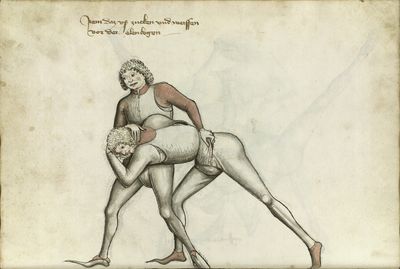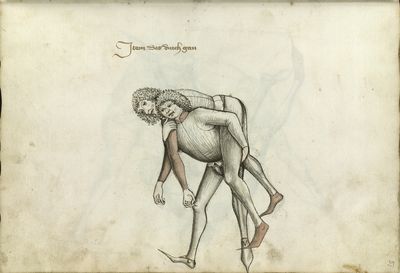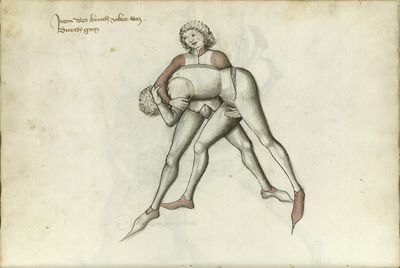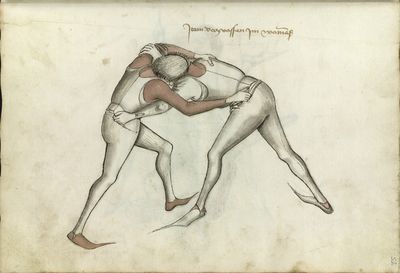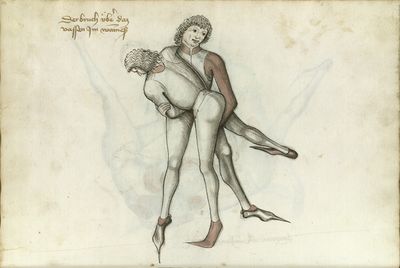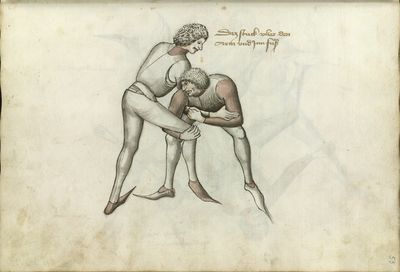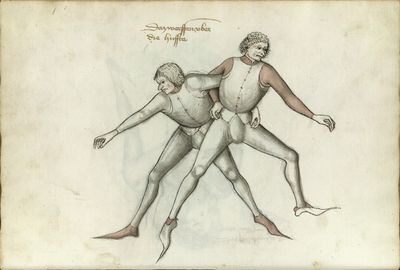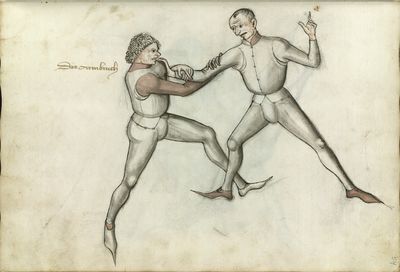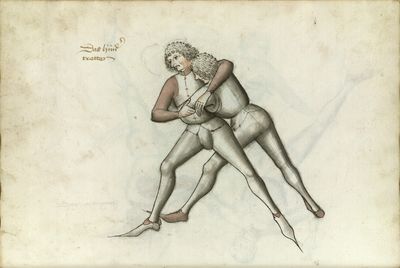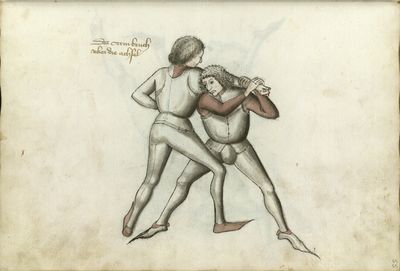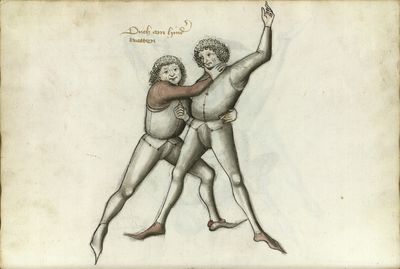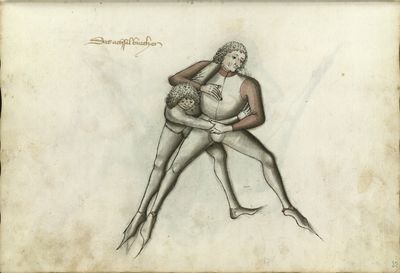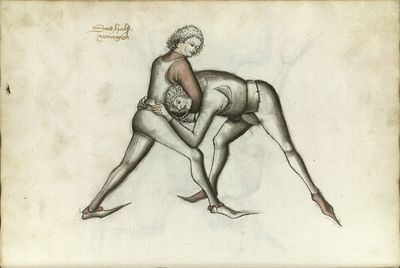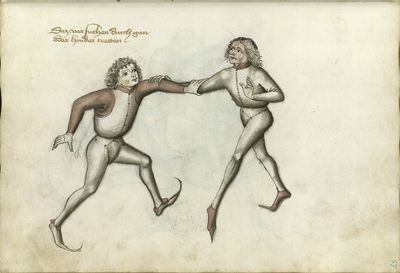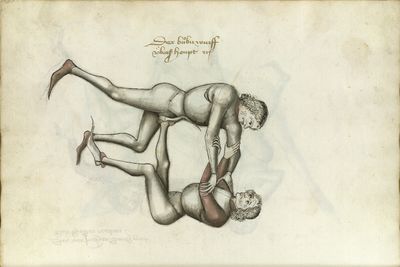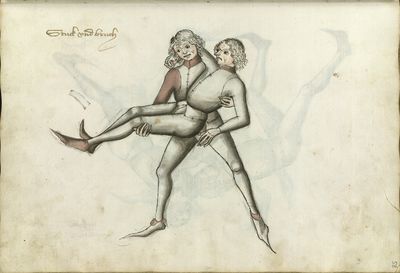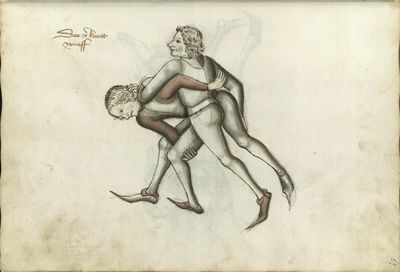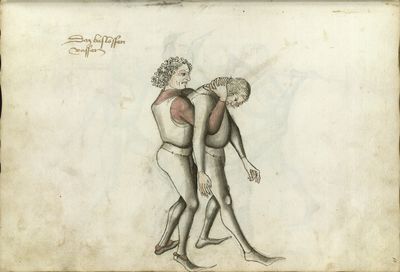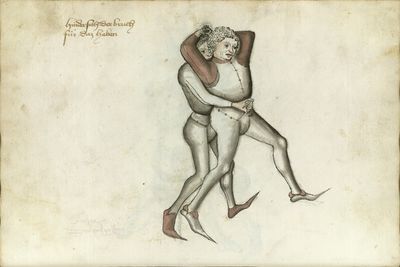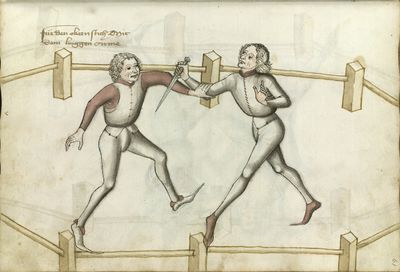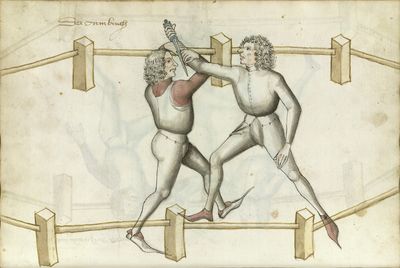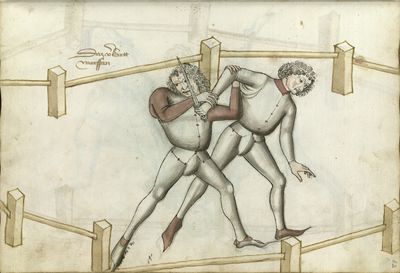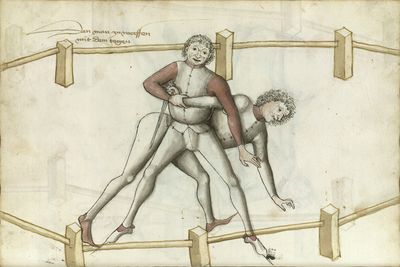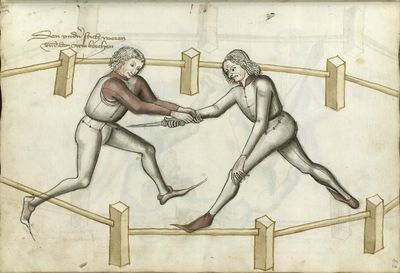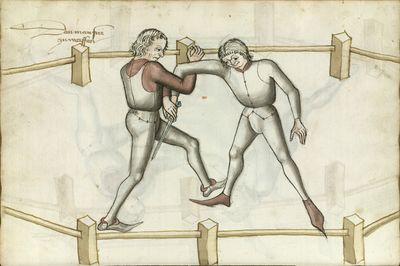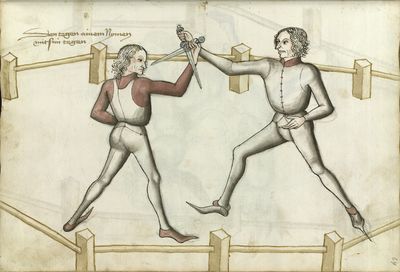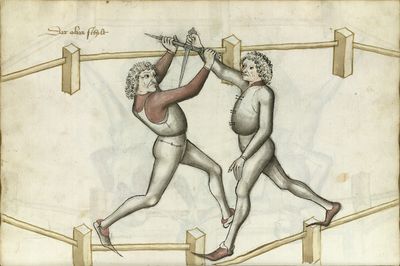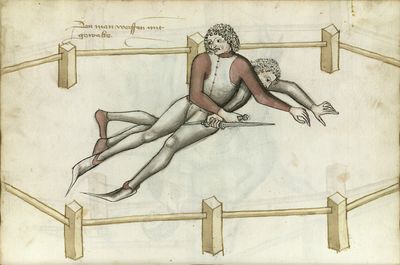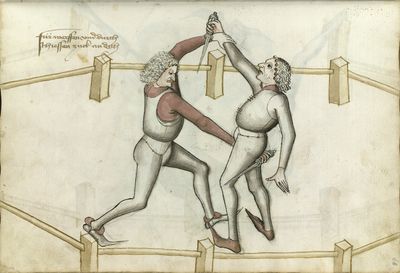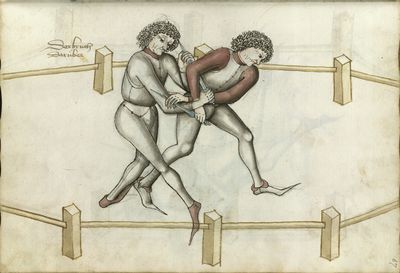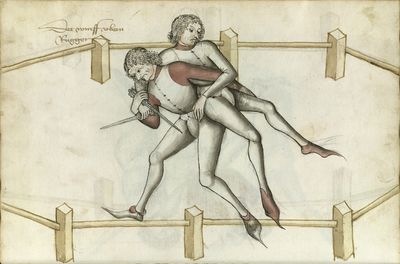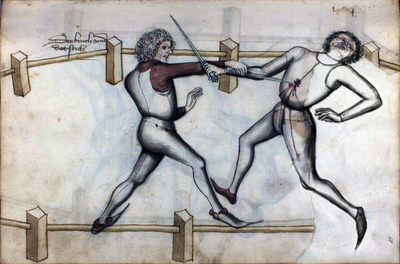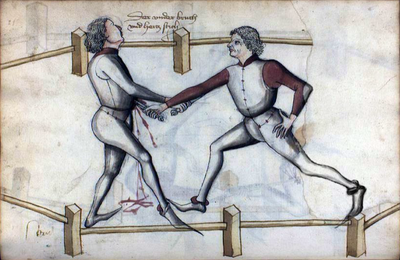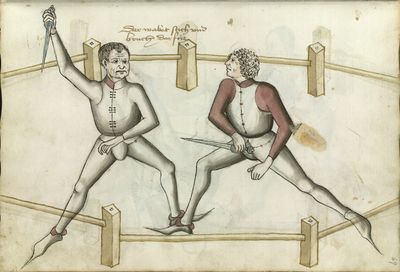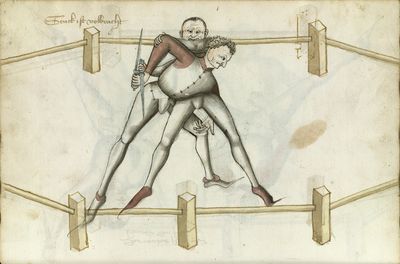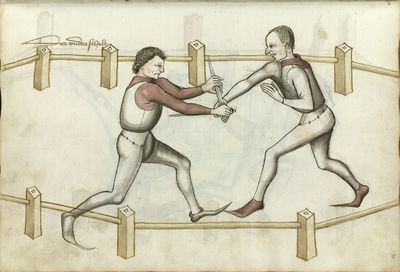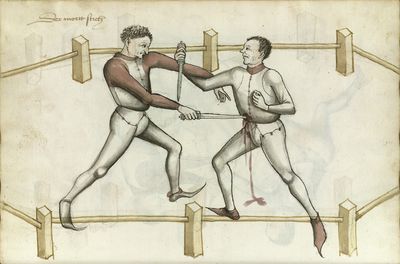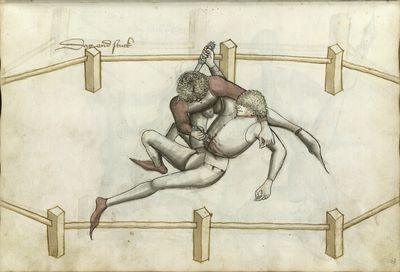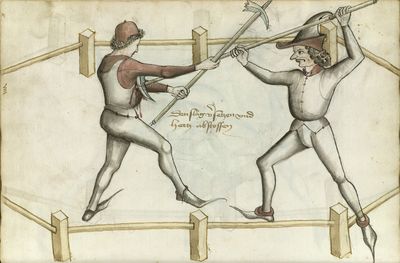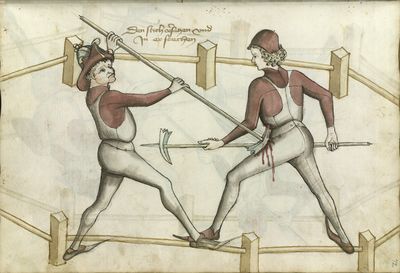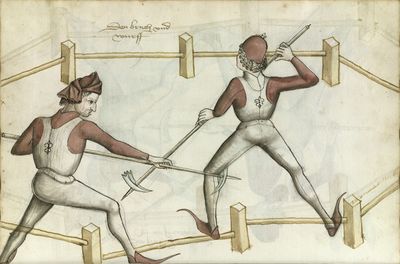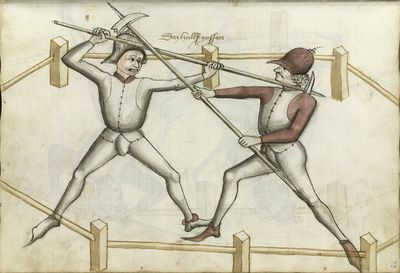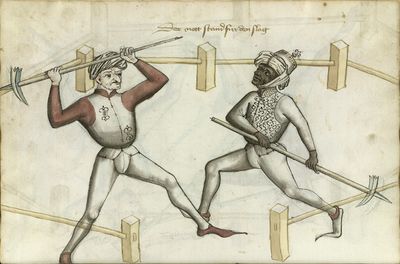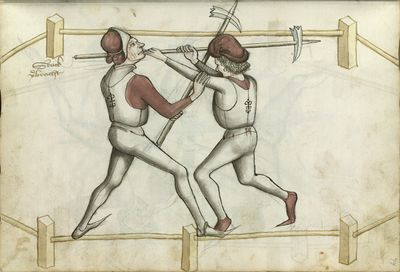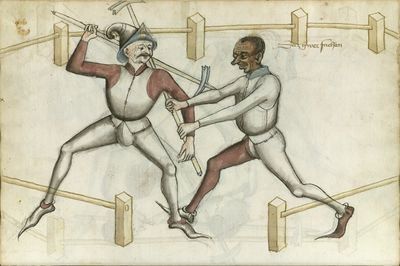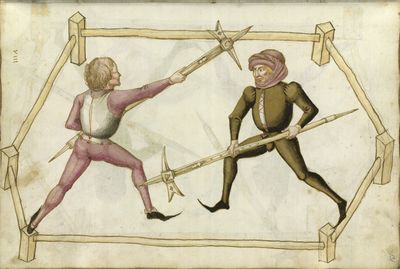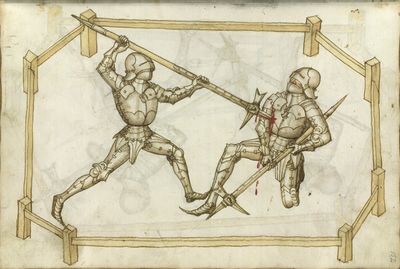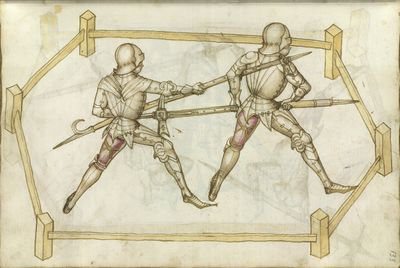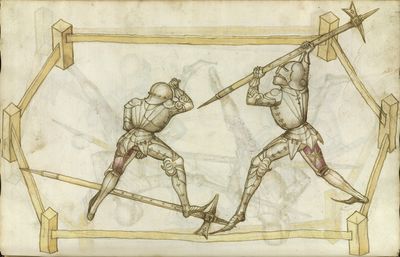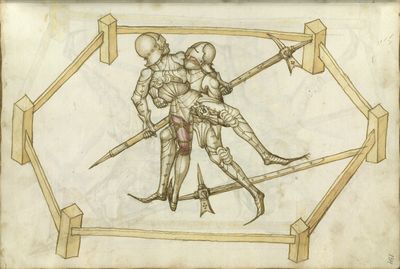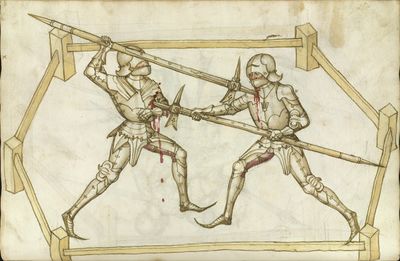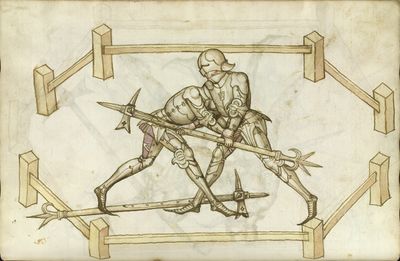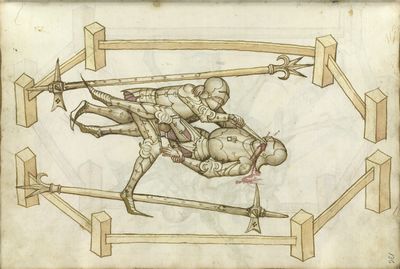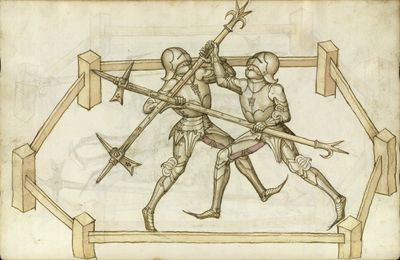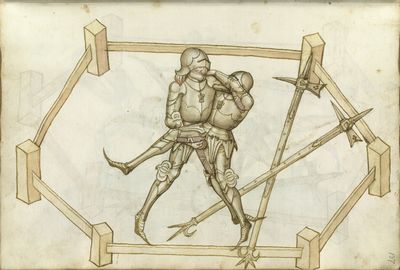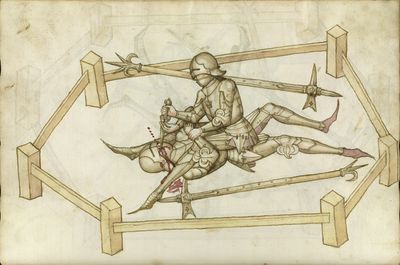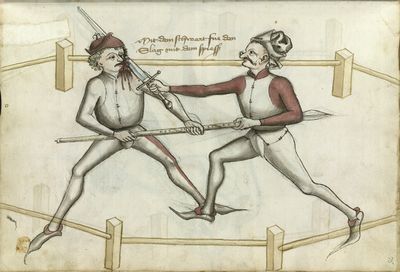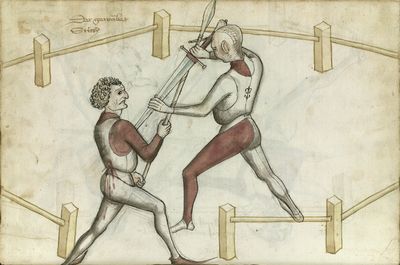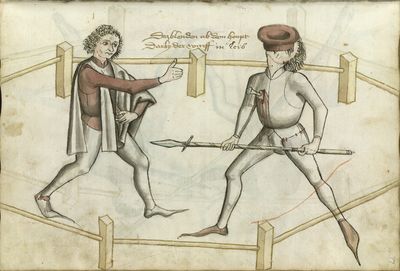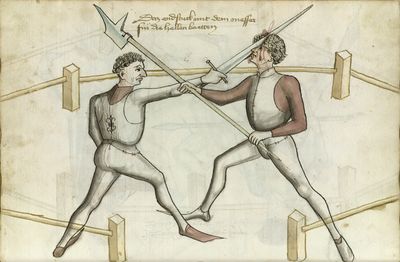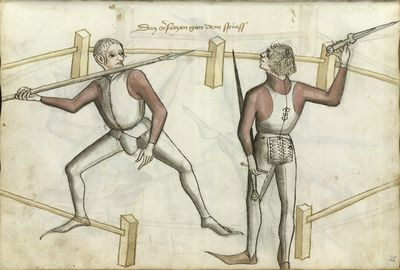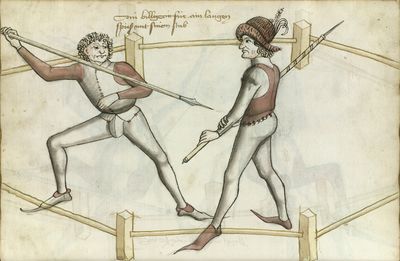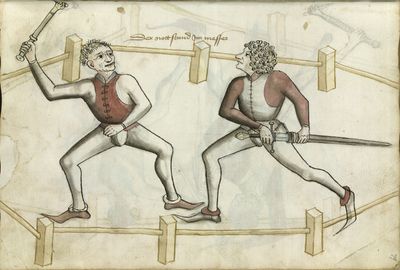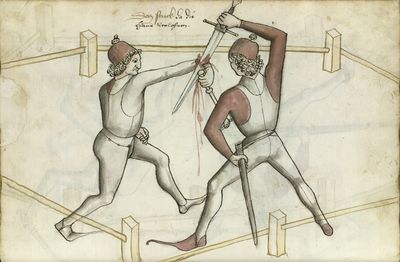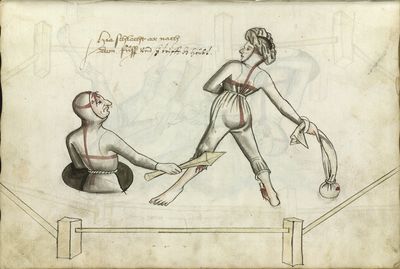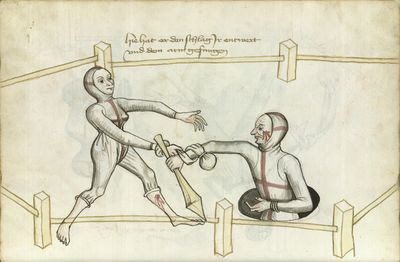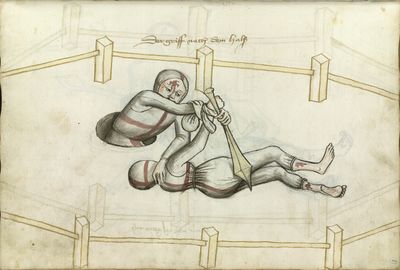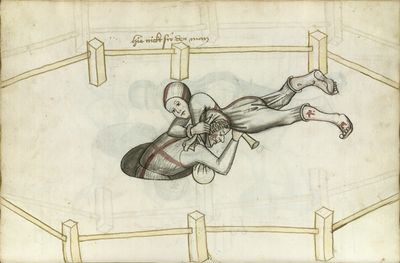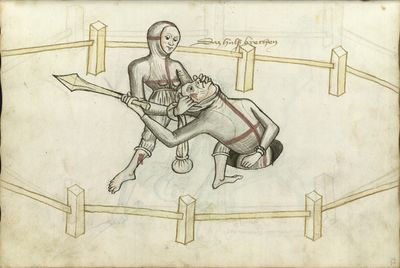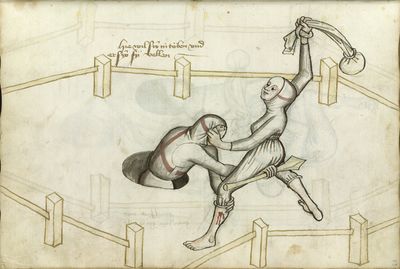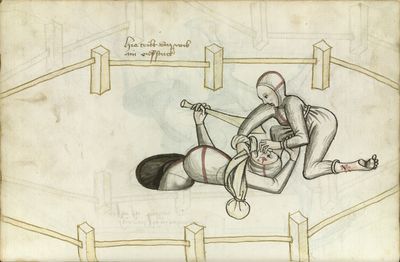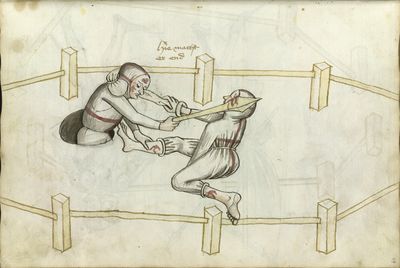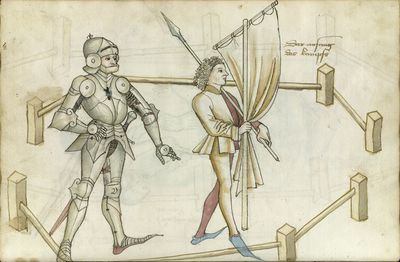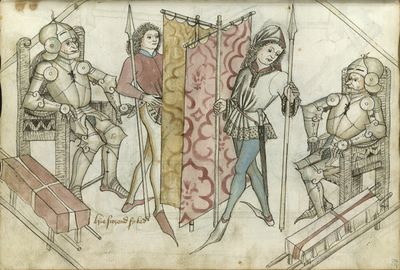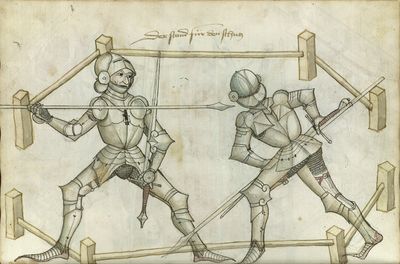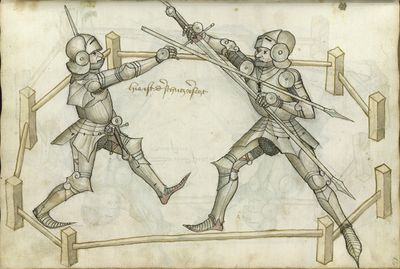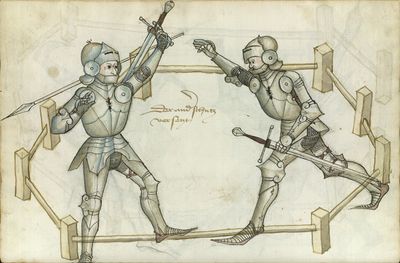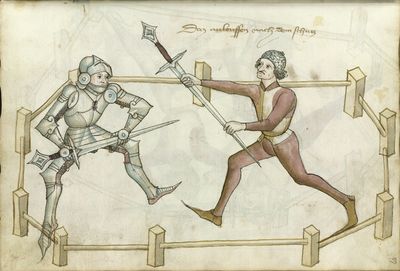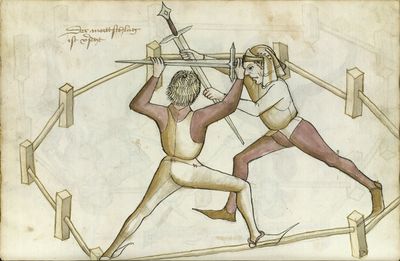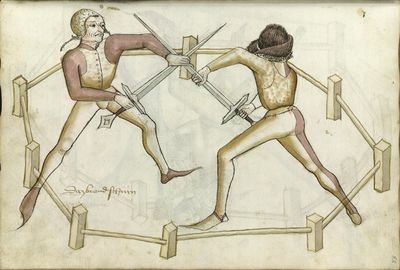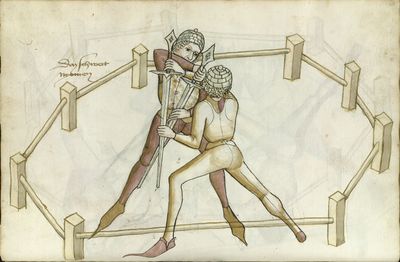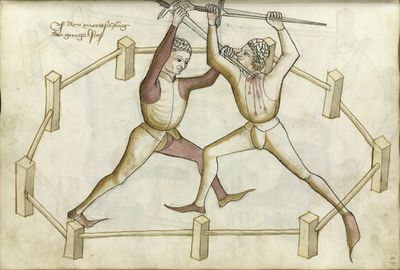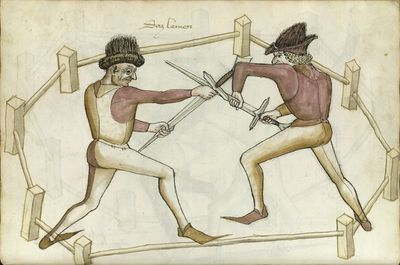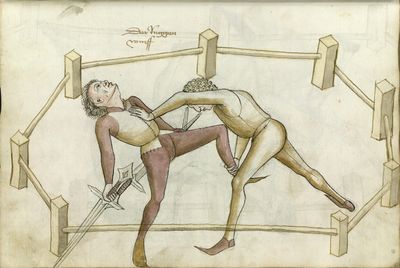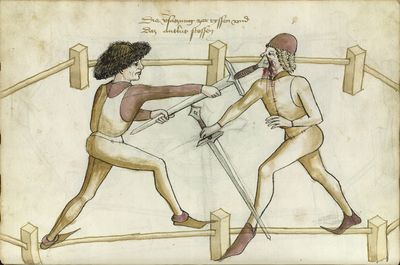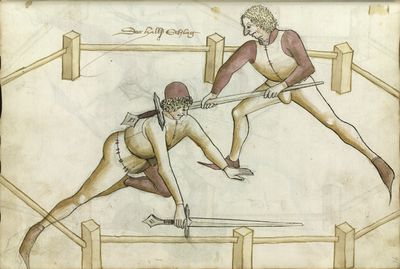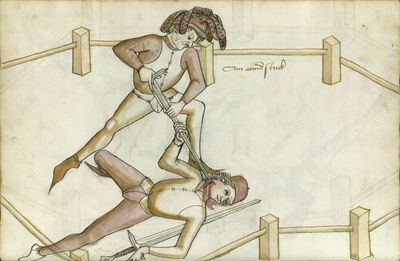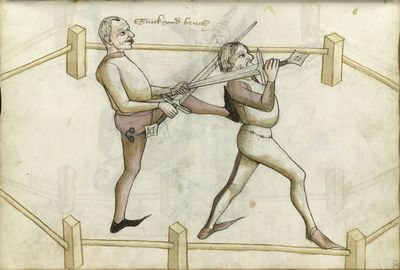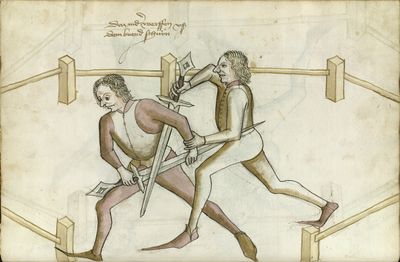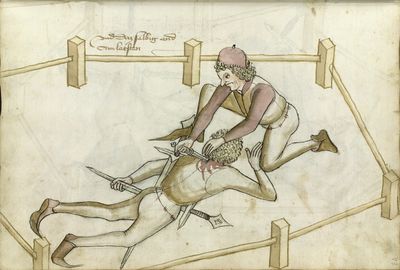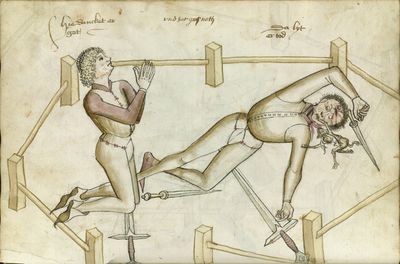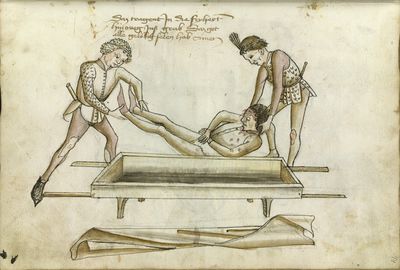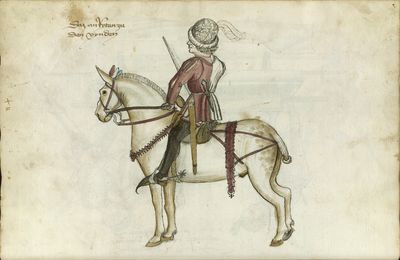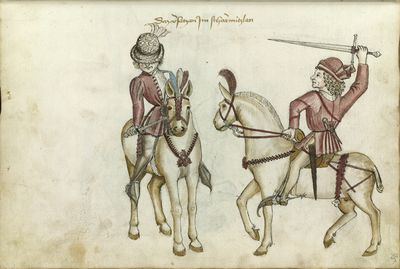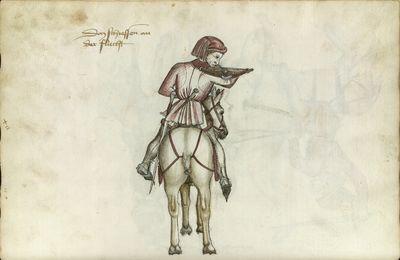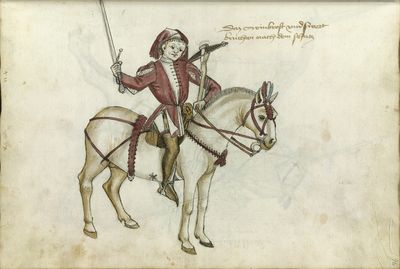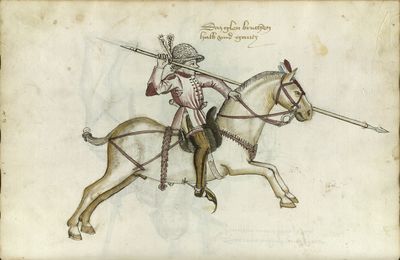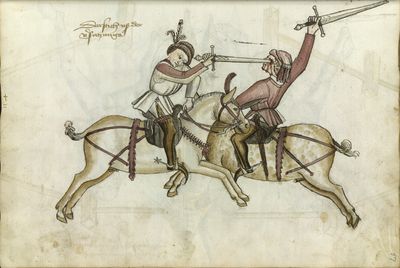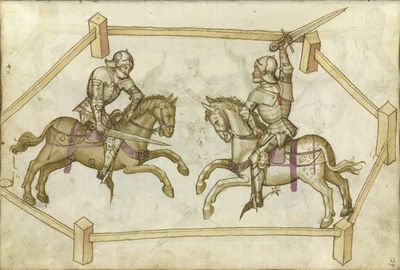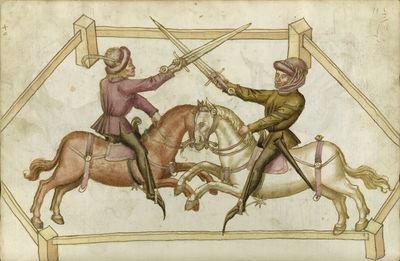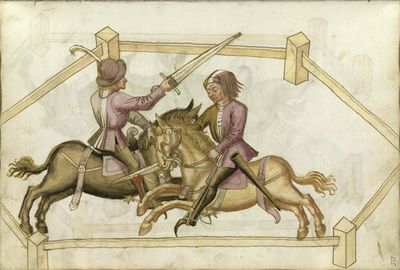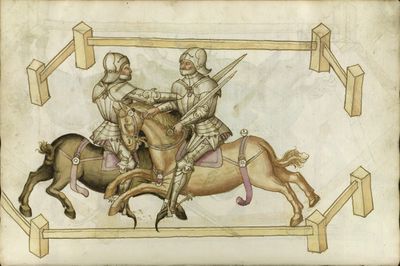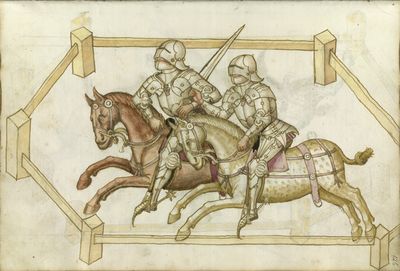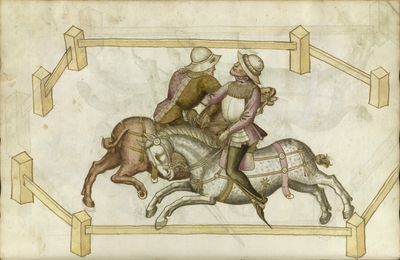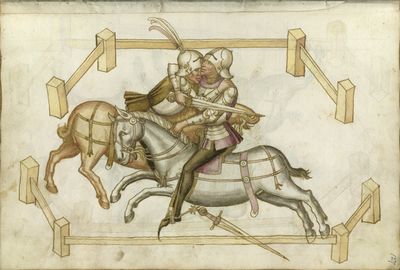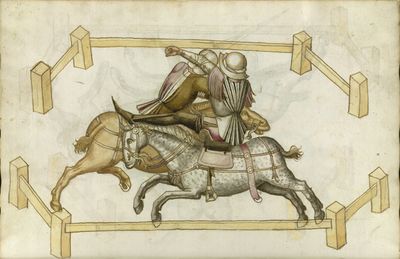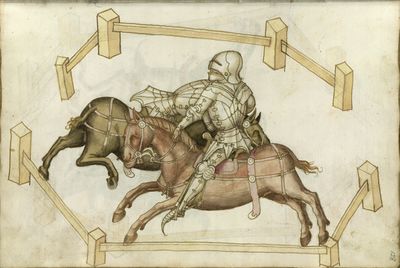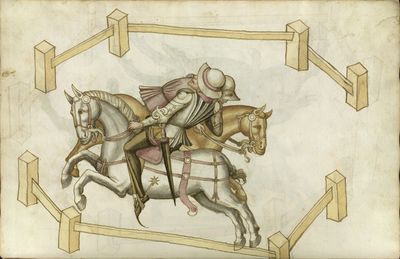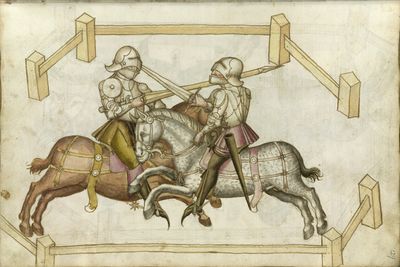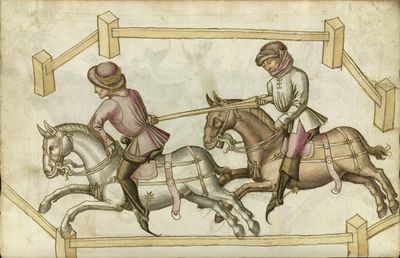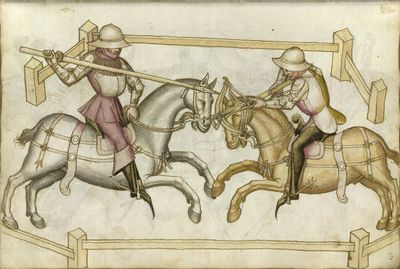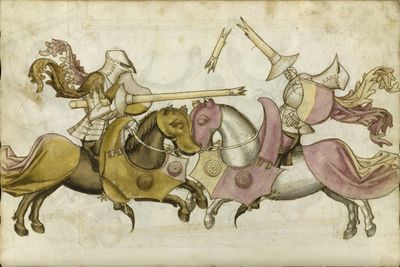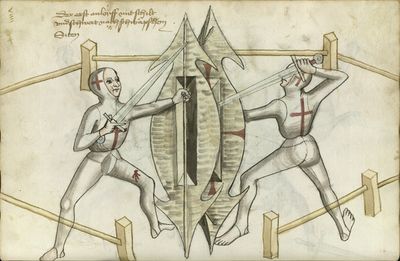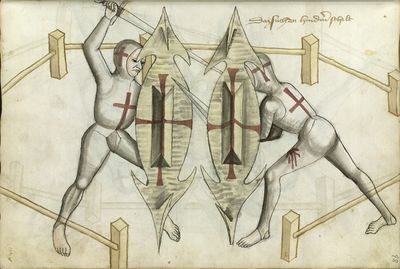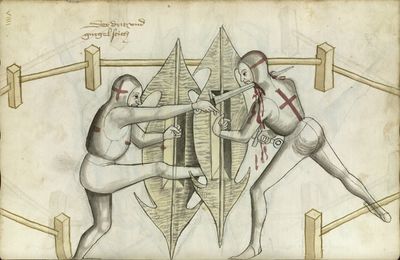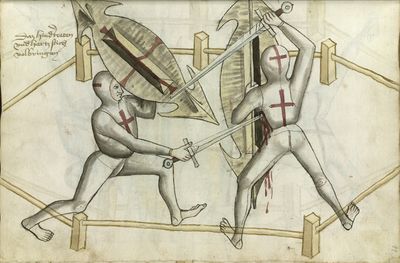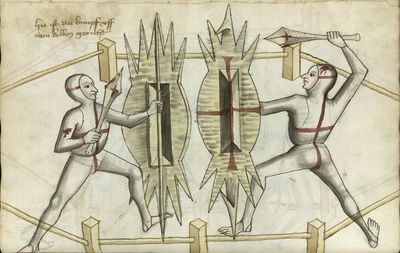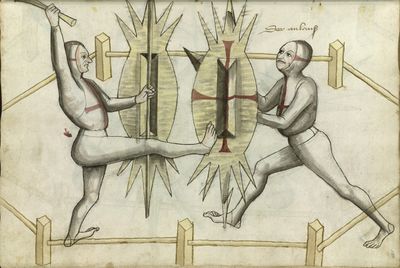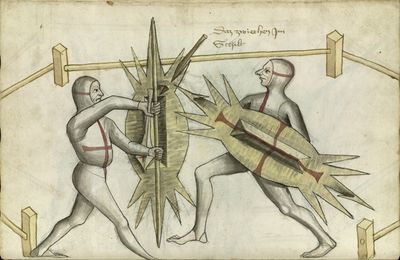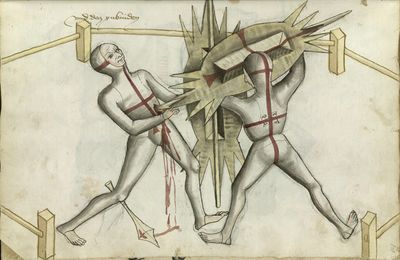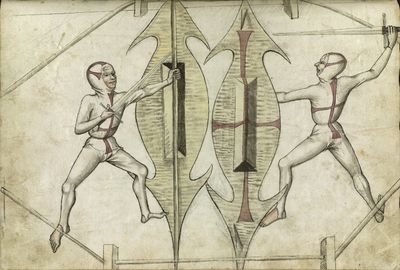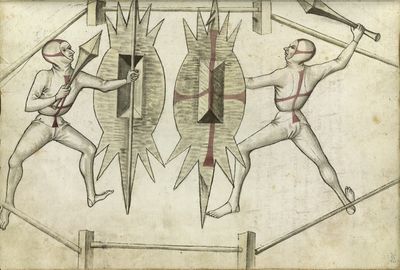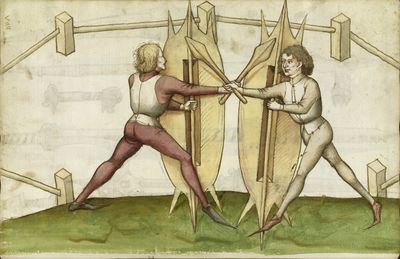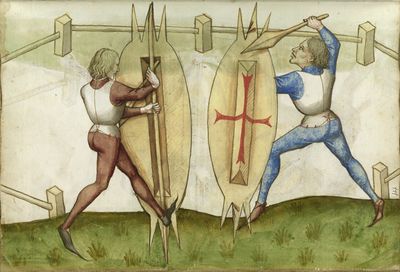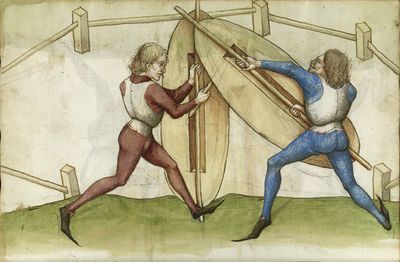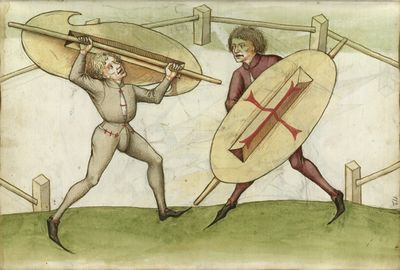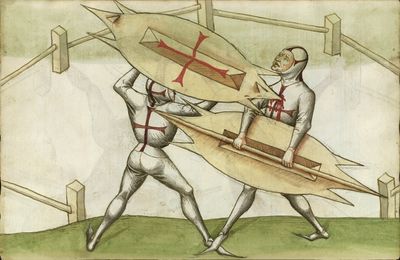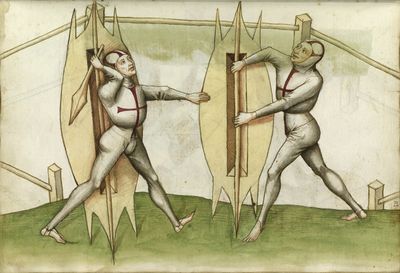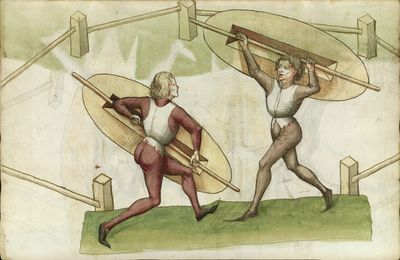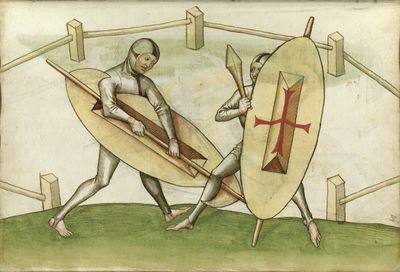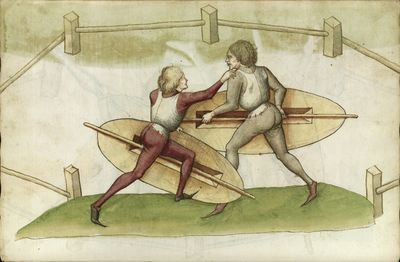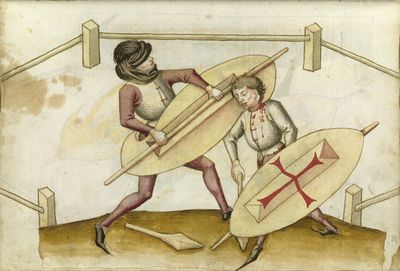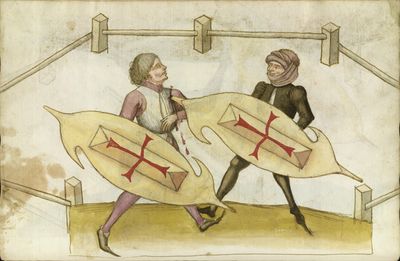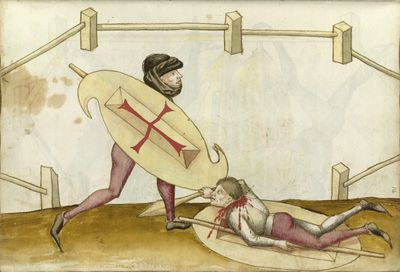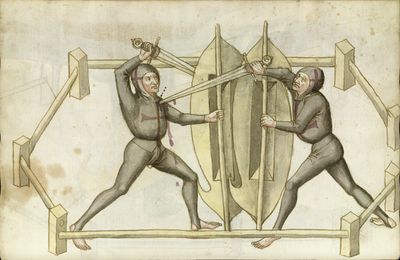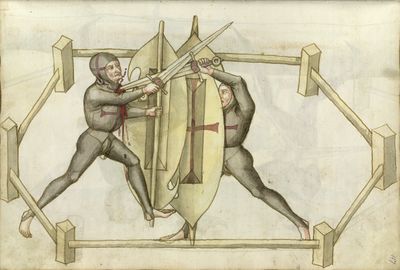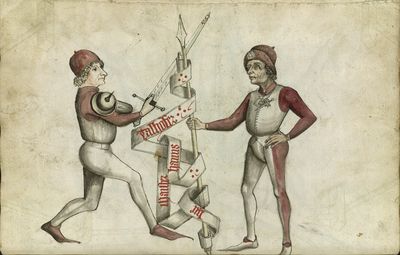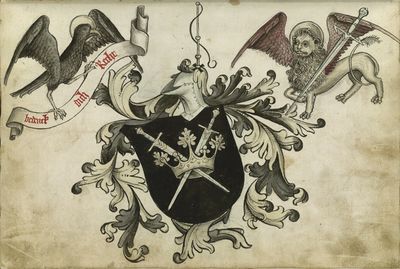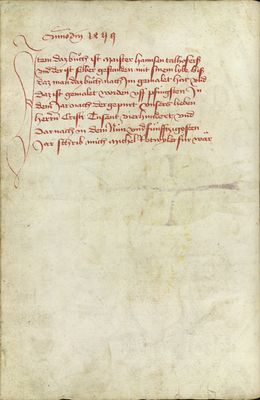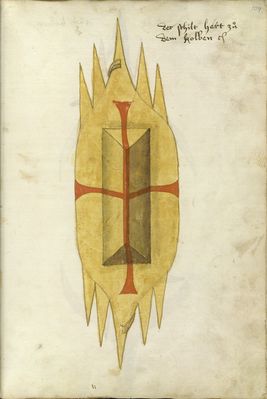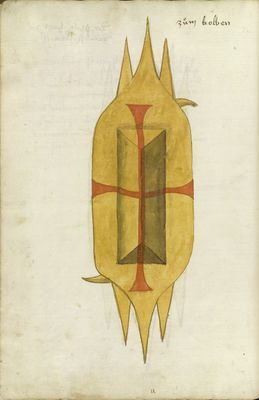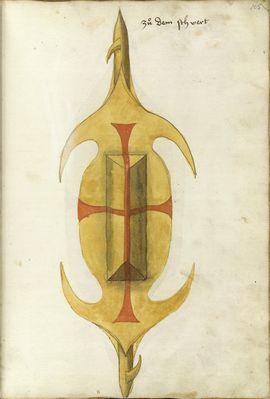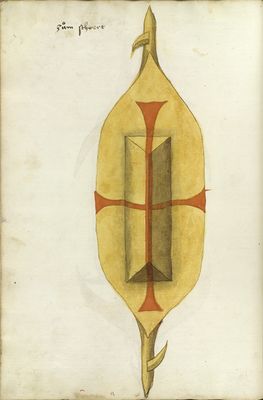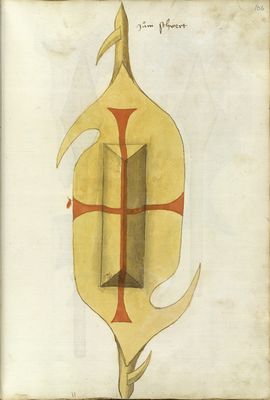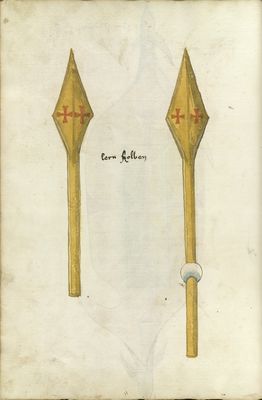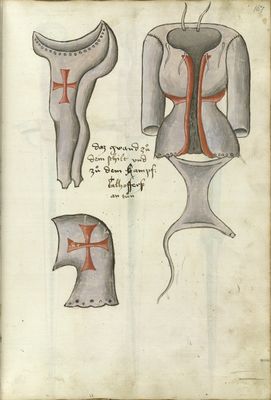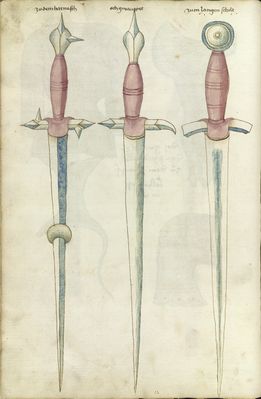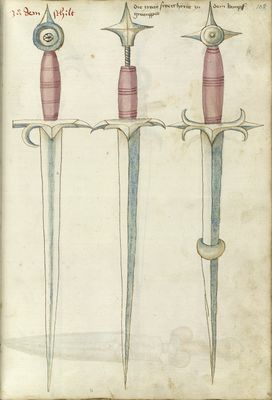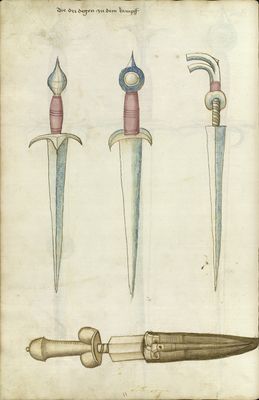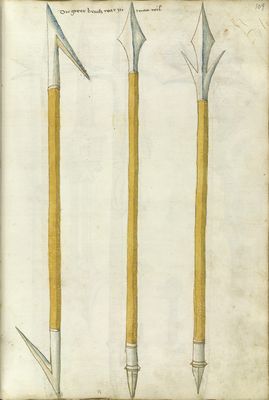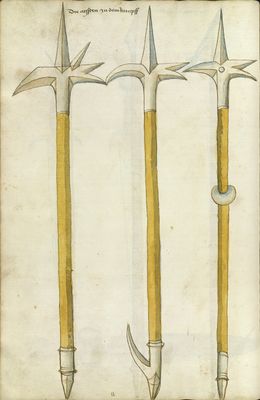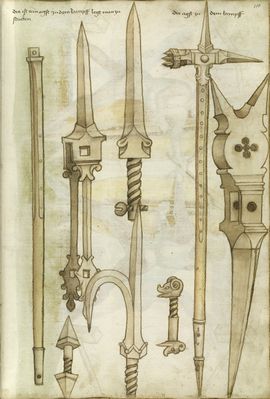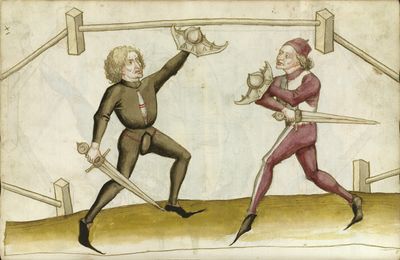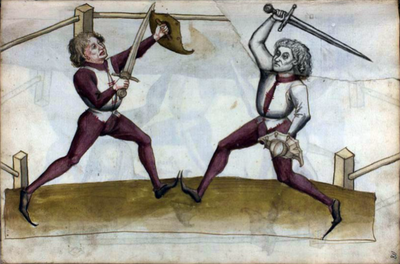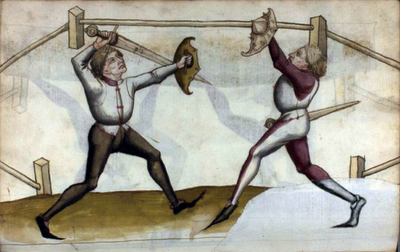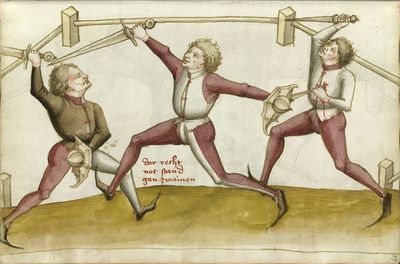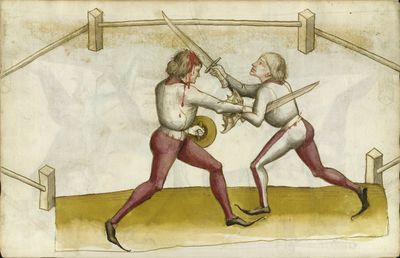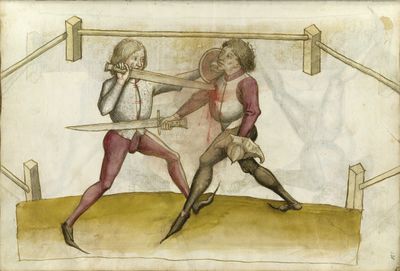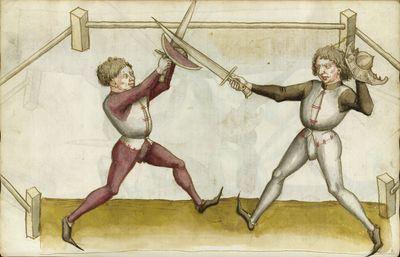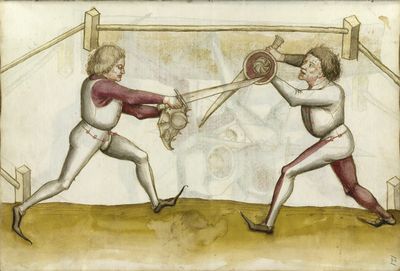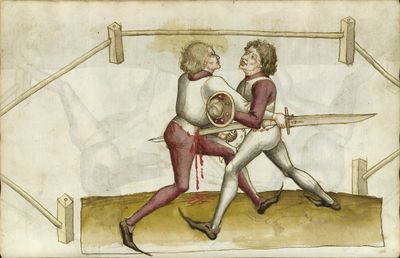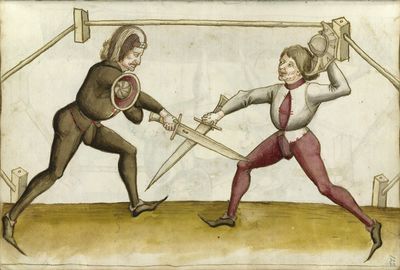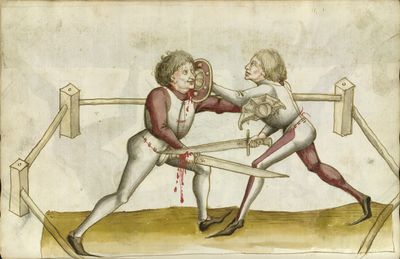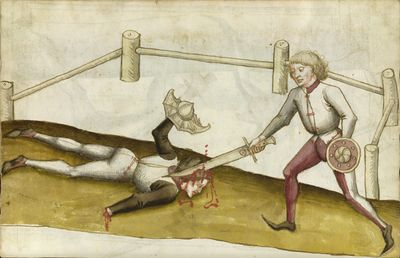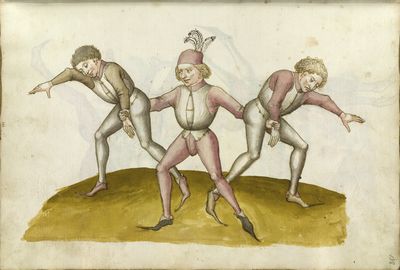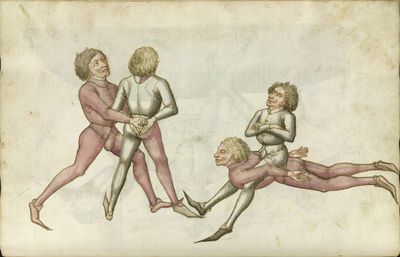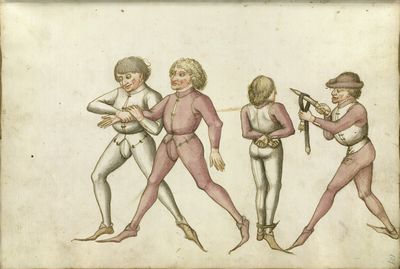|
|
You are not currently logged in. Are you accessing the unsecure (http) portal? Click here to switch to the secure portal. |
Hans Talhoffer
| Hans Talhoffer | |
|---|---|
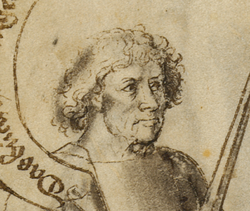 | |
| Born | ca. 1410-15 Swabia |
| Died | after 1482 |
| Occupation |
|
| Patron |
|
| Movement | Marxbrüder (?) |
| Genres | |
| Language | Early New High German |
| Archetype(s) |
|
| Manuscript(s) |
Cod. I.6.2º.1 (before 1561)
|
| Concordance by | Michael Chidester |
| Translations | |
| Signature |  |
Hans Talhoffer (Dalhover, Talhouer, Thalhoffer, Talhofer) was a 15th century German fencing master. His martial lineage is unknown, but his writings make it clear that he had some connection to the tradition of Johannes Liechtenauer, the grand master of the German school of fencing. Talhoffer was a well educated man, who took interest in astrology, mathematics, onomastics, and the auctoritas and the ratio. He authored at least five fencing manuals during the course of his career, and appears to have made his living teaching, including training people for trial by combat.
The first historical reference to Talhoffer is in 1433, when he represented Johann II von Reisberg, archbishop of Salzburg, before the Vehmic court. Shortly thereafter in 1434, Talhoffer was arrested and questioned by order of Wilhelm von Villach (a footman to Albrecht III von Wittelsbach, duke of Bavaria) in connection to the trial of a Nuremberg aristocrat named Jacob Auer, accused of murdering of his brother Hans. Talhoffer subsequently confessed to being hired to abduct Hans von Villach, and offered testimony that others hired by Auer performed the murder.[1] Auer's trial was quite controversial and proved a major source of contention and regional strife for the subsequent two years. Talhoffer himself remained in the service of the archbishop for at least a few more years, and in 1437 is mentioned as serving as a bursary officer (Kastner) in Hohenburg.[2]
The 1440s saw the launch of Talhoffer's career as a professional fencing master. He purchased (and perhaps contributed to) the MS Chart.A.558, an anthology created in ca. 1448. The fencing portion is largely text-less and it may have been designed as a visual aid for use in teaching; in addition to these illustrations, the manuscript also contains a treatise on name magic and a warbook that might be related to Konrad Kyeser's Bellifortis. While Talhoffer's owner's mark appears in this manuscript,[3] his level of involvement with its creation is unclear. It contains many works by other authors, in addition to plays that are somewhat similar to his later works, and shows evidence of multiple scribes and multiple artists. It is possible that he purchased the manuscript after it was completed (or partially completed), and used it as a basis for his later teachings.[4]
Most notable among the noble clients that Talhoffer served in this period was the Königsegg family of southern Germany, and some time between 1446 and 1459[5] he produced the MS XIX.17-3 for this family. This work depicts a judicial duel being fought by Luithold von Königsegg and the training that Talhoffer gave him in preparation, but it seems that this duel never actually took place.[6] He seems to have passed through Emerkingen later in the 1450s, where he was contracted to train the brothers David and Buppellin vom Stain; he also produced the MS 78.A.15 for them, a significantly expanded version of the Königsegg manuscript.[7]
In 1459,[8] Talhoffer commissioned the MS Thott.290.2º, a new personal fencing manual along the same lines as the 1448 work but expanded with additional content and captioned throughout. He appears to have continued instructing throughout the 1460s, and in 1467 he produced his final manuscript, Cod.icon 394a, for another of his noble clients, Eberhardt I von Württemberg.[9] This would be his most extensive work, and the graf paid 10 Guilder as well as quantities of rye and oats for the finished work.[10]
While only a few facts are known about Talhoffer's life, this has not stopped authors from conjecture. The presence of the Lion of St. Mark in Talhoffer's 1459 coat of arms (right) has given rise to speculation that he may have been an early or even founding member of the Frankfurt-am-Main-based Marxbrüder fencing guild, though there is no record of their existence prior to 1474.[citation needed] Additionally, much has been made of the fact that Talhoffer's name doesn't appear in Paulus Kal's list of members of the Fellowship of Liechtenauer.[11] While some have speculated that this indicates rivalry or ill-will between the two contemporaries, it is more likely that Talhoffer simply didn't participate in whatever venture the fellowship was organized for.
Various otherwise-unidentified fencing masters named Hans have also been associated by some authors with Talhoffer. The 1454 records of the city of Zürich note that a master (presumed by some authors to be Hans Talhoffer) was chartered to teach fencing in some capacity and to adjudicate judicial duels; the account further notes that a fight broke out among his students and had to be settled in front of the city council, resulting in various fines.[12] In 1455, a master named Hans was retained by Mahiot Coquel to train him for his duel with Jacotin Plouvier in Valencienne; if this were Talhoffer, his training did little good as Coquel lost the duel and died in brutal fashion.[citation needed]
Contents
- 1 Treatises
- 1.1 First Manuscript (1448)
- 1.2 Königsegg Treatise (1446-59)
- 1.3 Personal Manuscript (1459)
- 1.3.1 Opening
- 1.3.2 Rules for dueling
- 1.3.3 Grappling
- 1.3.4 Dagger
- 1.3.5 Poleaxe
- 1.3.6 Mixed Weapons
- 1.3.7 Duel between a man and a woman
- 1.3.8 Armored fencing
- 1.3.9 Mounted fencing
- 1.3.10 Longshield
- 1.3.11 Talhoffer's owner's mark
- 1.3.12 Equipment for dueling
- 1.3.13 Sword and buckler
- 1.3.14 Closing
- 1.4 Württemberg Treatise (1467)
- 1.5 Copyright and License Summary
- 2 Additional Resources
- 3 References
Treatises
Not only did Talhoffer produce at least three distinct treatises in his lifetime, but his writings have been reproduced in every century up to the present. They exist in well over a dozen manuscripts created in the fifteenth through nineteenth centuries; they have also been published a number of times in facsimiles beginning in 1887, including translations into English and French.
Talhoffer's writings cover a wide assortment of weapons, including the buckler, crossbow, dagger, flail, Messer, longshield, mace, poleaxe, spear, sword, and unarmed grappling, often both armored and unarmored, on horse and on foot, and in scenarios including tournaments, formal duels, and unequal encounters implying urban self-defense. Despite the obvious care and detail that went into the artwork, the manuscripts generally have only a few words captioning each page (and in many cases none at all); some were likely teaching aids and would need no detailed explanation, while the treatises for Königsegg, Stain, and Württemberg were probably intended as memory aids to review his teachings after he left.
Though there is considerable overlap in the specific plays Talhoffer teaches, the organization and exact contents differ in each of the main treatises. For this reason, they are listed separately below (along with their derivative copies) rather than being combined into one giant mixed concordance that fails to capture the organization of any of them. Though his authorship of his first manuscript, the Gotha, cannot be proven, it is included below because it is a useful reference to compare to his authenticated works.
First Manuscript (1448)
In addition to the four manuscripts which reproduce all or parts of the contents of the Gotha version, there are two others that only reproduce the material on dueling with longshields. These are the Wolfenbüttel and Coburg versions (which date to the 17th and 18th centuries, respectively), and they are also different from the other copies in that they have captions for many of the illustrations in this section. It's unclear who wrote the text or when it was written, but it's possible that the text is original to the treatise and the Gotha version is just a draft or incomplete copy of another, now lost, manuscript. In the absense of more information, it seems prudent to treat it as authentic. To streamline the concordance, these two sections are included at the far-right side of the longshield dueling and not included in any other sections.
Preface and Sword Dance
Illustrations |
Archetype Transcription (1448) [edit] |
New York Transcription (1600s) [edit] |
Göttingen Transcription (1600s) [edit] |
Kassel Transcription (1600s) [edit] |
Munich Transcription (ca.1820) [edit] | |
|---|---|---|---|---|---|---|
[1] [Banner:] God, thou Eternal Word, help the body here, the soul there. |
[002r] [In a banner.] Hilff · got · du · ewiges · wort ·· dem · leib ·· hie · der · sel · dort :·: * Amen * [In a more modern hand.] Hilff Gott du Ewiges Wort dem Leibe hie der Seelen dort. |
|||||
[2] |
[003r] [No text] |
[003r] [No text] | ||||
[3] |
[004r] [No text] |
[004r] [No text] | ||||
[4][13] |
[004v] [No text] |
[004v] [No text] | ||||
[5] |
[005r] [No text] |
[005r] [No text] | ||||
[6] |
[006r] [No text] |
[006r] [No text] |
Longshield Dueling
Illustrations |
Archetype Transcription (1448) [edit] |
New York Transcription (1600s) [edit] |
Göttingen Transcription (1600s) [edit] |
Kassel Transcription (1600s) [edit] |
Munich Transcription (ca.1820) [edit] |
Wolfenbüttel Transcription (1600s) [edit] |
Coburg Transcription (1700s) [edit] | |
|---|---|---|---|---|---|---|---|---|
[1] |
[024r] [No text] |
[40r] Figur des inwendigen Schildes, deßen durchgehendes stängelein die Kämpffer ergrieffen und damit den Schildt regieret. Figur des auswendigen Schildes. | ||||||
[2] |
[024v] [No text] |
[020r] [No text] |
[024r] [No text] |
[367v] [No text] |
[025v] [No text] |
[43v] Dieser schild ist auff denen Ecken ausgeschweiffet, und haben die Kämpffer einander darmit an Köpffen oder Hälsen, Armen und beinen, anfassen und zu boden oder zu sich reissen können. |
[40v] Dieser Schild ist auf denen Ecken ausgeschweiffet, und haben die Kämpffer einander darmit an Köpffen oder Hälsen, Armen und Beinen anfaßen und zu Boden oder zu sich reißen Können. | |
[3] |
[025v] [No text] |
[020v] [No text] |
[024v] [No text] |
[026v] [No text] |
[13r] [No text] [12v] Hier wird der Aus forderungs Brieff fortgeschickt. |
[14v] Hier wird der Ausforderungs Brieff fortgeschickt. | ||
[4] |
[026r] [No text] |
[021r] [No text] |
[025r] [No text] |
[027r] [No text] |
[14r] [No text] [13v] Der Ritter welcher die Aus forderung bestätiget. |
[15r] Der Ritter welcher die Ausforderung bestätiget. | ||
[5] |
[027r] [In a banner] Meister seyt mir gar wilkum |
[026v] [No text] |
[15r] [In a scroll.] Meister seyd mir Gott [!] willkommen [14v] Die Ritter und grißwartten bieten ihre dienste als beystande an. |
[16r] [In a scroll.] Meister seyd mir Gott [!] willkommen Die Ritter und Grießwartten bieten ihre Dienste als beystande an. | ||||
[6] |
[026v] [No text] |
[022r] [No text] |
[026r] [No text] |
[027v] [No text] |
[16r] [No text] [15v] Die Kämpffer versprechen sich zusammen das sie erscheinen wollen. |
[17r] [No text] [16v] Die Kämpffer versprechen sich zusammen, daß sie erscheinen wollen. | ||
[7] |
[027v] [No text] |
[023v] [No text] |
[027v] [No text] |
[369v] [No text] |
[028v] [No text] |
|||
[8] |
[028r] [In a banner] Hilff · got · du · ewiges · wort · dem · leib · hie · · der · selb · dort :·: :Amen·: |
[17r] [In a scroll.] Hilff Gott du Ewiges Wortt, dem Leibe hier, der Seelen dort. [16v] Der Kämpffer thut sein gebet zu Christo daß Er ihn bey stehen und seine unschuld retten wolle. Wessen das Wappen seyn solle, ist unbekandt. |
[18r] [In a scroll.] Hilff Gott du Ewiges Wortt, dem Leibe Hier, der Selen dort. [17v] Der Kämpffer thut sein Gebet zu Christo, daß Er ihn bey stehen und seine Unschuld retten wolle. Weßen das Wappen seyn solle, ist unbekandt | |||||
[9] |
[028v] [No text] |
[024v] [No text] |
[028v] [No text] |
[029v] [No text] |
[18r] Ritter S. Jörg, nu won mir bey und mach mich aller Sorgen frey. Amen [17v] Weil hier das bildnuß Maria und das ritters S. Jörgen stehet, will ich die Abergläubische händel, Welche die fechtmeister auff beyde nahmen gegründet haben, kürtzlich erzehlen. Meister liechtenauer in seinem Kunst buch deß langen schwerdts Anno 1443. geschrieben, schreibet da von nachfolgendes: Wisset daß die hohen meister alle gemeiniglich die nahmen getheilt haben in 2. theil. den ersten unser frauen nahmen der Jungfer Marien zugehöret, und den andern theil S. Jörgen. Also welcher nahme unser frauen zugehöret, der an ihrem theil stehet, den heissen Sie unser frauen bruder, und welcher an S. Jörgen theil stehet, den heissen sie S. Jörgen bruder. Darauff wisset, alle nahmen die unser frauen brüder sind, haben 3. Tage in einer ytzlichen wochen, gantzen Sygk, und den Sontag nachmittag. So haben S. Jörgen brüder auch 3. Tage in einer ytzlichen wochen gantzen Sygk, und den Suntag vormittage .etc. hiernach folget eine Tabel derienigen nahmen welcher unser frauen brüder, oder S. Jörgen brüder seyn, und wer sich darnach richtet der soll gesichert seyn, daß er nicht gefallen mag. Auff diese Tabel setzt der Autor runde figuren oder zirckel des Pythagorae, Ptolomaei, platonis, Aristotelis und |
[18v] Weil hier das Bildnuß Maria und des Ritters S. Jörgen stehet, will ich die Abergläubische Händel, welche die Fechtmeister auff beyde Nahmen gegründet haben, kürtzlich erzehlen. Meister Liechtenauer in seinem Kunst buch deß langen schwerdts Anno 1443. geschrieben, schreibet davon nachfolgendes: Wißet daß die Hohen Meister alle gemeiniglich die Nahmen getheilet haben in 2. theil. Den Ersten unser Frauen Nahmen der Jungfer Marien zugehöret, und den andern theil S. Jörgen. Also welcher Nahme unser Frauen zugehört, der an ihrem theil stehet, den heißen sie unser Frauen Bruder, und welcher am S. Jörgen Theil stehet, den heißen sie S. Jörgen Bruder. Darauf wißet, alle nahmen die unser Frauen Brüder sind, haben 3. Tage in einer itzlichen Wochen gantzen Sygck, und den Sonntag nachmittag. So haben S. Jörgen Brüder auch 3. Tage in einer ytzlichen Wochen gantzen Sygck, und den Suntag vormittage .etc. hiernach folget eine Tabel derjenigen Nahmen welcher unser Frauen Brüder, oder S. Jörgen Brüder seyn, und wer sich darnach richtet, der soll gesichert seyn, daß er nicht gefallen mag. Auff die Tabel setzt der Autor runde figuren oder zirckel des Pythagorae, Ptolomaei, platonis, Aristotelis und Haly, mit den Buchstaben des Alphabets | ||
[10] |
[029r] [No text] |
[025r] [No text] |
[029r] [No text] |
[030r] [No text] |
||||
[11] |
[029v] [No text] |
[025v] [No text] |
[029v] [No text] |
[030v] [No text] |
[19r] [No text] [18v] Haly, mit den buchstaben des Alphabets und allerhand zahlen, darinnen man finden solle, wenn zwene rechten, oder ringen, oder stechen, oder was sie thun, welcher obliegen werde, und füllet einige bogen damit an, allein weil es zu nichts dienet, habe ich solches übergehen wollen. Wo zu diese stange oder balcken gebraucht worden, kann aber nicht wissen. Wollen vieleicht die Schrancken da von bauen. |
[20r] [No text] [19v] und allerhand zahlen, darinnen man finden solle, wenn zwene rechten oder ringen, oder stechen, oder was sie thun, welcher obliegen werde, und füllet einige Bogen damit an, allein weil es zu nichts dienet, habe ich solches übergehen wollen Der Kämpffer thut sein Gebet zu Christo, daß er ihn bey stehe, und seine Unschuld retten wolle. Weßen das Wappen seyn solle, ist unbekandt. Wozu diese Stange oder Balken gebraucht worden kan aber nicht wißen. wollen vielleicht die Schrancken davon bauen. | ||
[12] |
[030r] [No text] |
[026r] [No text] |
[030r] [No text] |
[031r] [No text] |
||||
[13] |
[030v] [No text] |
[026v] [No text] |
[030v] [No text] |
[031v] [No text] |
[20r] [No text] [19v] Hier erlustirt sich der Kämpffer mit der Jagt. |
[21r] [No text] [20v] Hier erlustirt sich der Kämpffer mit der Jagd | ||
[14] |
[031r] [No text] |
[027r] [No text] |
[031r] [No text] |
[368r] [No text] |
[032r] [No text] |
|||
[15] |
[031v] [No text] |
[027v] [No text] |
[031v] [No text] |
[032v] [No text] |
[21r] [No text] [20v] Ist und trinckt und macht sich lustig. |
[22r] [No text] [21v] Ist und trinkt und macht sich lustig. | ||
[16] |
[032r] [No text] |
[028r] [No text] |
[032r] [No text] |
[033r] [No text] |
||||
[17] |
[032v] [No text] |
[028v] [No text] |
[032v] [No text] |
[033r] [No text] |
[22r] [No text] [21v] Badet, damit ihm der leib und glieder fein gelencke werden. |
[23r] [No text] [22v] Badet, damit ihm der Leib und glieder fein gelencke werden. | ||
[18] |
[033r] [No text] |
[029r] [No text] |
[033r] [No text] |
[034r] [No text] |
||||
[19] |
[033v] [No text] |
[029v] [No text] |
[033v] [No text] |
[034v] [No text] |
||||
[20] |
[034r] [No text] |
[030r] [No text] |
[034r] [No text] |
[035r] [No text] |
||||
[21] |
[034v] [No text] |
[030v] [No text] |
[034v] [No text] |
[035v] [No text] |
[23r] [No text] [22v] Setz sich in die Bad stube und läst vieleicht zur Ader, damit er zum kämpffen desto hurttiger sey. |
[24r] [No text] [23v] Setz sich in die Badstube und läst vieleicht zur Ader, damit er zum Kämpffen desto hurtiger sey. | ||
[22] |
[035r] [No text] |
[031r] [No text] |
[035r] [No text] |
[036r] [No text] |
||||
[23] |
[035v] [No text] |
[031v] [No text] |
[035v] [No text] |
[036v] [No text] |
[24r] [No text] [23v] Praeparirt sich zum Tode und beichtet. |
[25r] [No text] [24v] Praeparirt sich zum Tode und beichtet. | ||
[24] |
[036r] [No text] |
[032r] [No text] |
[036r] [No text] |
[037r] [No text] |
||||
[25] |
[036v] [No text] |
[032v] [No text] |
[036v] [No text] |
[037v] [No text] |
[25r] [No text] [24v] Nimt abschied von seinen Weibe und gefreünden. |
[26r] [No text] [25v] Nimt Abschied von seinen Weibe und gefreunden. | ||
[26] |
[037r] [No text] |
[033r] [No text] |
[037r] [No text] |
[038r] [No text] |
||||
[27] |
[037v] [No text] |
[033v] [No text] |
[037v] [No text] |
[038v] [No text] |
[26r] [No text] [25v] Empfäht das heilige Abendmahl. |
[27r] [No text] [26v] Empfäht das heilige Abendmahl. | ||
[28] |
[038r] [No text] |
[034r] [No text] |
[038r] [No text] |
[039r] [No text] |
[27r] [No text] [26v] Nun sind die stühle vor die Kämpffer zurechte gesetz, und die Schrancken auffgebaut. |
[28r] [No text] [27v] Nun sind die Stühle vor die Kämpffer zu rechte gesetzt und die Schrancken aufgebauet. | ||
[29] |
[038v] [No text] |
[034v] [No text] |
[038v] [No text] |
[039v] [No text] |
[28r] [No text] [27v] Der Kämpffer wird nun mehr zu dem Kampffplatz aus geführt. |
[29r] [No text] [28v] Der Kämpffer wird nun mehr zu dem Kampffplatz ausgeführt. | ||
[30] |
[039r] [No text] |
[035r] [No text] |
[039r] [No text] |
[040r] [No text] |
[29r] [No text] [28v] Trit mit seinem Grießwartten und Waffen träger in den Kampffplatz. |
[30r] [No text] [29v] Trit mit seinen Grießwartten und Waffen träger in den Kampffplatz. | ||
[31] |
[039v] [No text] |
[035v] [No text] |
[039v] [No text] |
[040v] [No text] |
||||
[32] |
[040r] [No text] |
[036r] [No text] |
[040r] [No text] |
[041r] [No text] |
[30r] [No text] [29v] Beyde Kämpffer lassen ihre Särge in den Kampff Platz bringen, setzen sich auff ihre stühle und erwartten das zeichen zum Kampff. |
[31r] [No text] [30v] Beyde Kämpffer laßen ihre Särge in dem Kampff platz bringen, setzen sich auff ihre stühle, und erwartten das zeichen zum Kampff. | ||
[33] |
[040v] [No text] |
[036v] [No text] |
[040v] [No text] |
[041v] [No text] |
[31r] [No text] [30v] Hier wird vor die Kämpffer zu Christo gebeten daß er ihnen wolle gnädig seyn und dem gerechten den Sieg ver leihen. |
[32r] [No text] [31v] Hier wird vor die Kämpffer zu Christo gebehte daß er ihnen wolle gnädig seyn und dem Gerechten den Sieg verleihen. | ||
[34] |
[041r] [No text] |
[037r] [No text] |
[042r] [No text] |
[042r] [No text] |
[32r] [No text] [31v] Der Waffen träger überreicht den Kämpffer seine Waffen. |
[33r] [No text] [32v] Der Waffenträger überreicht den Kämpffer seine Waffen | ||
[35][16] |
[042v] [No text] |
|||||||
[36] |
[042r] [No text] |
[038r] [No text] |
[043r] [No text] |
[370v] [No text] |
[043r] [No text] |
[33r] [No text] [32v] Hier gehen sie mit Schilden und Kolben auff ein ander loß, welches sonst auch mit den Schwerdten geschehen. |
[34r] [No text] [33v] Hier gehen sie mit Schilden und Kolben auff einander loß, welches sonst auch mit den Schwerdten geschehen. | |
[37] |
[043r] [No text] |
[039r] [No text] |
[044r] [No text] |
[044r] [No text] |
||||
[38] |
[044r] [No text] |
[040r] [No text] |
[045r] [No text] |
[045r] [No text] |
||||
[39] |
[045r] [No text] |
[041r] [No text] |
[046r] [No text] |
[046r] [No text] |
||||
[40] |
[046r] [No text] |
[042r] [No text] |
[047r] [No text] |
[047r] [No text] |
[34r] [No text] [33v] Der eine Kämpffer wird nach dem sie die Kolben hingeworffen, mit dem schilde blessirt. |
[35r] [No text] [34v] Der eine Kämpffer wird nach dem sie die Kolben hingeworffen, mit dem Schilde blessirt. | ||
[41] |
[047r] [No text] |
[043r] [No text] |
[048r] [No text] |
[048r] [No text] |
[35r] [No text] [34v] Und gar erleget. |
[36r] [No text] [35v] und gar erlegt. | ||
[42] |
[048r] [In a banner] gotes dine° wil ich sin er hat behiet daz lebn min [In modern script] Gottes diener wil ich sin, Er hat behüt das Leben min. |
[36r] [In a scroll.] Gottes diener wil ich sin, Er hat behüt das leben min. [35v] Hier liegt der ertödtete auff der bahre und der andere dancket Gott das er dem Sieg davongetragen. |
[37r] [In a scroll.] Gottes diener wil ich sin, Er hat behüt das leben min [36v] Hier liegt der ertödtete auff der bahre und der andere danket Gott, daß er den Sieg davongetragen. |
Armored Dueling
Illustrations |
Archetype Transcription (1448) [edit] |
New York Transcription (1600s) [edit] |
Göttingen Transcription (1600s) [edit] |
Kassel Transcription (1600s) [edit] |
Munich Transcription (ca.1820) [edit] | |
|---|---|---|---|---|---|---|
[1] |
[049r] [In a banner] Ritter · sant · Jörg · nu · won · mir · bey · vnd · · mach · mich · aller · sorgen · frey Amen :· [In modern script] Ritter Sanct Jörg Wohn mir beÿ, U. mach mich aller Sorgen freÿ. Amen. |
[371r] [No text] |
||||
[2] |
[050r] [No text] |
[046r] [No text] |
[053r] [No text] |
[051r] [No text] | ||
[3] |
[051r] [No text] |
[047r] [No text] |
[054r] [No text] |
[052r] [No text] | ||
[4] |
[052r] [No text] |
[048r] [No text] |
[055r] [No text] |
[053r] [No text] | ||
[5] |
[053r] [No text] |
[049r] [No text] |
[056r] [No text] |
[054r] [No text] | ||
[6] |
[054r] [No text] |
[050r] [No text] |
[057r] [No text] |
[055r] [No text] | ||
[7] |
[054v] [No text] |
[050v] [No text] |
[057v] [No text] |
[376r] [No text] |
[055v] [No text] | |
[8] |
[055r] [No text] |
[051r] [No text] |
[058r] [No text] |
[056r] [No text] | ||
[9] |
[055v] [No text] |
[051v] [No text] |
[058v] [No text] |
[056v] [No text] | ||
[10] |
[056r] [No text] |
[052r] [No text] |
[059r] [No text] |
[373r] [No text] |
[057r] [No text] | |
[11] |
[057r] [No text] |
[053r] [No text] |
[060r] [No text] |
[058r] [No text] | ||
[12] |
[058r] [No text] |
[054r] [No text] |
[061r] [No text] |
[059r] [No text] | ||
[13] |
[059r] [No text] |
[055r] [No text] |
[062r] [No text] |
[060r] [No text] | ||
[14] |
[060r] [No text] |
[056r] [No text] |
[063r] [No text] |
[061r] [No text] | ||
[15] |
[061r] [No text] |
[057r] [No text] |
[064r] [No text] |
[062r] [No text] | ||
[16] |
[062r] [No text] |
[058r] [No text] |
[065r] [No text] |
[063r] [No text] | ||
[17] |
[063r] [No text] |
[059r] [No text] |
[066r] [No text] |
[064r] [No text] | ||
[18] |
[064r] [No text] |
[060r] [No text] |
[067r] [No text] |
[065r] [No text] | ||
[19] |
[065r] [No text] |
[061r] [No text] |
[068r] [No text] |
[066r] [No text] | ||
[20] |
[066r] [No text] |
[062r] [No text] |
[069r] [No text] |
[067r] [No text] | ||
[21] |
[067r] [No text] |
[063r] [No text] |
[070r] [No text] |
[068r] [No text] | ||
[22] |
[068r] [No text] |
[064r] [No text] |
[071r] [No text] |
[069r] [No text] | ||
[23] |
[069r] [No text] |
[065r] [No text] |
[072r] [No text] |
[070r] [No text] | ||
[24] |
[070r] [No text] |
[066r] [No text] |
[073r] [No text] |
[071r] [No text] | ||
[25] |
[071r] [No text] |
[067r] [No text] |
[074r] [No text] |
[374r] [No text] |
[072r] [No text] | |
[26] |
[072r] [In a banner] [In modern script] |
[375r] [No text] |
Poleax
Illustrations |
Archetype Transcription (1448) [edit] |
New York Transcription (1600s) [edit] |
Göttingen Transcription (1600s) [edit] |
Kassel Transcription (1600s) [edit] |
Munich Transcription (ca.1820) [edit] | |
|---|---|---|---|---|---|---|
[1] |
[073v] [No text] |
[073r] [No text] |
[076r] [No text] |
[377r] [No text] |
[074v] [No text] | |
[2] |
[074v] [No text] |
[074r] [No text] |
[077r] [No text] |
[075v] [No text] | ||
[3] |
[075v] [No text] |
[075r] [No text] |
[078r] [No text] |
[076v] [No text] | ||
[4] |
[076v] [No text] |
[076r] [No text] |
[079r] [No text] |
[077v] [No text] | ||
[5] |
[077v] [No text] |
[077r] [No text] |
[080r] [No text] |
[078v] [No text] | ||
[6] |
[078v] [No text] |
[078r] [No text] |
[081r] [No text] |
[079v] [No text] | ||
[7] |
[079v] [No text] |
[079r] [No text] |
[082r] [No text] |
[080v] [No text] | ||
[8] |
[080v] [No text] |
[080r] [No text] |
[083r] [No text] |
[081v] [No text] | ||
[9] |
[378r] [No text] |
Dagger
Illustrations |
Archetype Transcription (1448) [edit] |
New York Transcription (1600s) [edit] |
Göttingen Transcription (1600s) [edit] |
Kassel Transcription (1600s) [edit] |
Munich Transcription (ca.1820) [edit] | |
|---|---|---|---|---|---|---|
[1] |
[083r] [No text] |
[081r] [No text] |
[084r] [No text] |
[379r] [No text] |
[084r] [No text] | |
[2] |
[083v] [No text] |
[081v] [No text] |
[084v] [No text] |
[084v] [No text] | ||
[3] |
[084r] [No text] |
[082r] [No text] |
[085r] [No text] |
[085r] [No text] | ||
[4] |
[084v] [No text] |
[082v] [No text] |
[085v] [No text] |
[085v] [No text] | ||
[5] |
[085r] [No text] |
[083r] [No text] |
[086r] [No text] |
[086r] [No text] | ||
[6] |
[085v] [No text] |
[083v] [No text] |
[086v] [No text] |
[086v] [No text] | ||
[7] |
[086r] [No text] |
[084r] [No text] |
[087r] [No text] |
[087r] [No text] | ||
[8] |
[086v] [No text] |
[084v] [No text] |
[087v] [No text] |
[087v] [No text] | ||
[9] |
[087r] [No text] |
[085r] [No text] |
[088r] [No text] |
[088r] [No text] | ||
[10] |
[087v] [No text] |
[085v] [No text] |
[088v] [No text] |
[088v] [No text] | ||
[11] |
[088r] [No text] |
[086r] [No text] |
[089r] [No text] |
[089r] [No text] | ||
[12] |
[088v] [No text] |
[086v] [No text] |
[089v] [No text] |
[089v] [No text] | ||
[13] |
[089r] [No text] |
[087r] [No text] |
[090r] [No text] |
[090r] [No text] | ||
[14] |
[089v] [No text] |
[087v] [No text] |
[090v] [No text] |
[090v] [No text] | ||
[15] |
[090r] [No text] |
[088r] [No text] |
[091r] [No text] |
[091r] [No text] | ||
[16] |
[090v] [No text] |
[088v] [No text] |
[091v] [No text] |
[091v] [No text] | ||
[17] |
[091r] [No text] |
[089r] [No text] |
[092r] [No text] |
[092r] [No text] | ||
[18] |
[091v] [No text] |
[089v] [No text] |
[092v] [No text] |
[092v] [No text] | ||
[19] |
[092r] [No text] |
[090r] [No text] |
[093r] [No text] |
[093r] [No text] | ||
[20] |
[092v] [No text] |
[090v] [No text] |
[093v] [No text] |
[093v] [No text] | ||
[21] |
[093r] [No text] |
[091r] [No text] |
[094r] [No text] |
[094r] [No text] | ||
[22] |
[093v] [No text] |
[091v] [No text] |
[094v] [No text] |
[094v] [No text] | ||
[23] |
[094r] [No text] |
[092r] [No text] |
[095r] [No text] |
[095r] [No text] | ||
[24] |
[094v] [No text] |
[092v] [No text] |
[095v] [No text] |
[095v] [No text] | ||
[25] |
[095r] [No text] |
[093r] [No text] |
[096r] [No text] |
[096r] [No text] | ||
[26] |
[095v] [No text] |
[093v] [No text] |
[096v] [No text] |
[096v] [No text] | ||
[27] |
[096r] [No text] |
[094r] [No text] |
[097r] [No text] |
[097r] [No text] | ||
[28] |
[096v] [No text] |
[094v] [No text] |
[097v] [No text] |
[097v] [No text] | ||
[29] |
[097r] [No text] |
[095r] [No text] |
[098r] [No text] |
[098r] [No text] | ||
[30] |
[097v] [No text] |
[095v] [No text] |
[098v] [No text] |
[098v] [No text] | ||
[31] |
[098r] [No text] |
[096r] [No text] |
[099r] [No text] |
[099r] [No text] | ||
[32] |
[098v] [No text] |
[096v] [No text] |
[099v] [No text] |
[099v] [No text] | ||
[33] |
[099r] [No text] |
[097r] [No text] |
[100r] [No text] |
[100r] [No text] | ||
[34] |
[099v] [No text] |
[097v] [No text] |
[100v] [No text] |
[100v] [No text] | ||
[35] |
[100r] [No text] |
[098r] [No text] |
[101r] [No text] |
[101r] [No text] | ||
[36] |
[100v] [No text] |
[098v] [No text] |
[101v] [No text] |
[101v] [No text] | ||
[37] |
[101r] [No text] |
[099r] [No text] |
[102r] [No text] |
[102r] [No text] | ||
[38] |
[101v] [No text] |
[099v] [No text] |
[102v] [No text] |
[102v] [No text] | ||
[39] |
[102r] [No text] |
[100r] [No text] |
[103r] [No text] |
[103r] [No text] | ||
[40] |
[102v] [No text] |
[100v] [No text] |
[103v] [No text] |
[103v] [No text] | ||
[41] |
[103r] [No text] |
[101r] [No text] |
[104r] [No text] |
[104r] [No text] | ||
[42] |
[103v] [No text] |
[101v] [No text] |
[104v] [No text] |
[104v] [No text] | ||
[43] |
[104r] [No text] |
[102r] [No text] |
[105r] [No text] |
[105r] [No text] | ||
[44] |
[104v] [No text] |
[102v] [No text] |
[105v] [No text] |
[105v] [No text] |
Grappling
Illustrations |
Archetype Transcription (1448) [edit] |
New York Transcription (1600s) [edit] |
Göttingen Transcription (1600s) [edit] |
Kassel Transcription (1600s) [edit] |
Munich Transcription (ca.1820) [edit] | |
|---|---|---|---|---|---|---|
[1] A beginning, with same grasping of the arms. |
[116v] Ain an hebung czw gleichm~ fassen auß den armen |
|||||
[2] This is a strike, to come at the man. |
[117r] Das ist ain abslahen czw komen an den man |
|||||
[3] This is the hip-wrestle by the neck. |
[117v] Das ist das hueff ringen beÿ dem hals |
|||||
[4] This is a break against the hip wrestle by the neck. |
[118r] Das ist der bruch vber das hueff ringen pey dem hals |
|||||
[5] The arm close over the hip. |
[118v] Das arm~ slyssen vber dy hueff |
|||||
[6] This is an advance to grasp the same leg. |
[119r] Das ist das dringen pey dem pain zu gleichm~ fassen |
|||||
[7] This is the forward step when equal in grasp. |
[119v] Das ist das fur treten czw gleichem fassen |
|||||
[8] He who presses you, throw over your head like so. |
[120r] Wer dich tringt den burf vber das haubt also |
|||||
[9] This is the slip-through outside of the leg. |
[120v] Das ist das durch sliffen aussen pey dem pain |
|||||
[10] This is the slip-through inside of the leg. |
[121r] Das ist das durch sliffen In wen dem pain |
|||||
[11] That is the wrong slip-through when back to back. |
[121v] Das ist das ebich durch sliffen ruck an ruck |
|||||
[12] The limb breaking at the outside of the arm. |
[122r] Das glit prechen aussen an den arm~ |
|||||
[13] This is the break against the slip-through on the outside of the leg, grasp to send him into a vertigo spin. |
[122v] Das ist der bruech vber das durch sliffñ aussen an dem pain faß In in dy swindel wait |
|||||
[14] This is the break against the slip-through inside the leg. |
[123r] Das ist der bruch vb° das durch sliffñ In an dem pain |
|||||
[15] Right against right left against left. |
[123v] Recht gein recht glinck gein glinck |
|||||
[16] This is the break against the slip-through the outside at the leg, grasp to send him into a vertigo spin. |
[124r] Das ist der pruch vber das durch sliffen aussen an dem pain faß In In dy swindel wag |
|||||
[17] This is the hurl by the arm. |
[124v] Das sit das sleuderñ pey dem arm~ |
|||||
[18] This is the step-behind in the arm where you press. |
[125r] Das ist das hintter tretten In dem arme~ wer dich truckt |
|||||
[19] How to push away from you when someone closes in. |
[125v] Das von dir stossen wer in dich dringt |
|||||
[20] This is the vertigo spin when you raise him. |
[126r] Das ist dy swindel wag zw auff czucken |
|||||
[21] This is the ending of the vertigo spin. |
[126v] Da hat die swindel wag ain end |
|||||
[22] This is the knee kick against the limb. |
[127r] Das ist das knye ab tretten wider das glit |
|||||
[23] This is the arm break against the shoulder. |
[127v] Das ist das arm~ ab prechen vber dy achsel |
|||||
[24] One should play on a board like this. |
[128r] Also sol man auff aim In dem pret spilen |
|||||
[25] The twist at the arm. |
[128v] Das vmb dreen bey dem arm~ |
|||||
[26] The French Wrestling. |
[129r] Das franczosis ringen |
|||||
[27] This is how to go through back to back. |
[129v] Das ist das mit durch gen ruck ruck an |
|||||
[28] Back to back is finished. |
[130r] Ruck an rück hat ein end |
|||||
[29] This is the defense against a hard press. |
[130v] Das ist al pruch vber hart trücken |
|||||
[30] How the man who is caught throws two. |
[131r] Wye ainer czwen sol werffen den man gefangñ fürt |
|||||
[31] That is how one should close one arm with both arms. |
[131v] Das ist das wie man aim ain arm~ sol slissen mit payden arm~ |
|||||
[32] That is how you can close in with the elbow in his shoulder. |
[132r] Das ist wie man aim sol enfaln mit dem elpogen In sein achsel glit |
|||||
[33] That is the defense when one has the leg on the others arm. |
[132v] Das ist der bruch wen ainer hat das pain auff der achsel |
|||||
[34] |
[133r] [No text] |
[131r] [No text] | ||||
[35] |
[133v] [No text] |
[131v] [No text] |
Warbook
Illustrations |
Archetype Transcription (1448) [edit] |
New York Transcription (1600s) [edit] |
Göttingen Transcription (1600s) [edit] |
Kassel Transcription (1600s) [edit] |
Munich Transcription (ca.1820) [edit] | |
|---|---|---|---|---|---|---|
[1] |
[141r] Das ist ain wasserman Der ist gemacht mit leder die augñ sollen sein von weissem duñen horn zu der Rorn hat er atem als lanng biß die obern seck val werd~ Das leder sol sein gesmirht mit öl vnd mit wachs vnd sol sein genät mit ain° sibeln al di nit sneidt also sol man die nachgeschribñ stuck all näen vnd smirben die von leder sein |
|||||
[2] |
[141v] Das ist wie man zu fuss vber wasser sol geen Das ist ain schuch mit ain° peil pleven solen ist der man swar so mach man den schuch dester swarer das er die wag hab das In der wind nit vmb werff vnden an dem schuch das ist das rued° |
|||||
[3] |
[142r] Das ist ain zewg zu ross vber wasser |
|||||
[4] |
[142v] das ist ain geschiffte laiter da die wäpmer an steigñ Das ist ain laiter wil ainen gesellen habñ |
|||||
[5] |
[143r] Das ist ain nater daman inn steiglaiter In ain venster mit hebt Das ist ain steigñ mit sprüsseln an ainem ainitzigñ strick Das ist ain aintzige stangñ mit sprüsseln zu steigñ Das ist ain schuch zu steigñ an an ain° slechten stangñ |
|||||
[6] |
[143v] Das ist wie man sich selb sol auf hin winden |
|||||
[7] |
[144r] Das ist ein steigñ mit vedern In aine~ ror an aine~ ainitzigñ strick |
|||||
[8] |
[144v] Das ist ain prugken von leder da müssen die seck auf geplosen sein mit furfallenden pletern sack |
|||||
[9] |
[145r] Das ist ain punt zu dem steckñ |
|||||
[10] |
[145v] also sol man ain Armbst vnder aine~ mantel spannen |
|||||
[11] |
[146r] Wie zwen man ain puchsen sellen hebñ auf aine~ wagñ die hundert zennten hat |
|||||
[12] |
[146v] ain geschiffter spies Das ist ain steiglaiter |
|||||
[13] |
[147r] ain sturmlaiter |
|||||
[14] |
[147v] Wie man ainen brief vnder aine~ wasser sol schreibñ |
|||||
[15] |
[148r] Wie man machñ sol das aiñ sein aigñ schlos nit mag auf tun Wie man aus dem sack sol komen |
| ||||
[16] |
[148v] 3 Loth. 4 Loth. |
Königsegg Treatise (1446-59)
Preface
Illustrations |
Archetype Transcription (1446-1459) [edit] |
Berlin Transcription (1450s) [edit] |
Vienna Transcription (1480-1500) [edit] |
Augsburg Transcription (1561) [edit] | |
|---|---|---|---|---|---|
[1] One notices, if a nobleman has an agreement that he is provoked to a duel, or provokes one, then he should remember to take a master who could prepare him for the fight, and is from the master to be sworn that he faithfully shares with him his art, and not tell his secrets or the tricks which he teaches. |
[01r] Item Es ist zu° wissent des ersten wen ain bÿder man zeschaffen haut das Im geschriben würt zu° dem ernst oder er aim schribt so sol er gedencken das er stelle nach aim maister der in zu° dem kampff versorge~ kind[18] vnd sol Im den maister haissen geloben das er Im trẅlich sein kunst mittaill Vnd sein haimlichait nit sag vnd auch nit wider in sÿ das er die kunst niemat wissen lauß die er In ler° |
[01r] Item. Es ist zu wissen, des Ersten wen ain bydrman ze schaffen hawe, das Im geschriben wäre zu dem ernst oder er aim schreybe, so sol er gedencken das er sulle nemen ain maister, der In zu dem kampf versorgen kind vnd sol Im den Maister hayssen globen, das er Im treulich sein kunst mit tail vnd sein Haymlichayt nit sag vnd auch nit wider In sey, das er kunst niemann wissen lasz, die er In Ler. |
|||
[2] The young nobleman has to be careful not to have too much confidence in people and not to give his secret arts away to anybody, so that he will not be betrayed, and particularly he is to rise all days early, hear a mass, then to go home, eat a slice of Johanisbrot, and then practice for two hours with effort, not eat much fat, practice again in the afternoon for two hours and at night before going to sleep to eat a piece of pumpernickel/dark bread, which has been soaked in cold water; that makes good breath and widens the chest. |
Item Es sol auch der Junckher sich hütten das er nit vill gehaimß mit den lütten hab das sein haimlichait niemen erfar vnd das im nit werd v°geben vnd besunder so sol er alltag frü vff stãn vnd hören ain meß vnd dar nach hain gãn vnd sol essen ain schnÿtte santj Johans brott vnd sich arbaitten zwu° stund in der ler vnd nit vil faists dings essen Vnd nach mittag aber zwu° stund Vnd zenacht so er schlauffen wil gãn so sol er essen ain Ruggj schnÿtte brot vß ainem kaltten wasser das macht Im gu°tten autem vnd wit vmb das hertz |
Item. Es sol auch der Junckher sich hüten, das er nit vil gehayms mit den Leuten hab, das sein heymlichayt niemann erfar vnd das Im nit werd vergeben, vnd besunder so sol er altag frue auff stan vnd hören ain mesz vnd dar nach haym gan vnd sol essen ain schnytten sanct Johans prott vnd sich arbayen zwo stunde In der ler vnd nit vil faists dings essen vnd nach mittag aber zwo stunde vnd zu nacht so er schlaffen wil gan so sol essen ain rugk schwarez brot ausz ainem kalten wasser das macht Im guten atem vnd weyt vmb das herez. |
|||
[3] If the business is then to take place, he is to turn to a city, which pleases him therefore, asking for inlet and protection; if one assures that to him, then he requires free escort for himself and his companions. |
It~ wer den das der söltte für sich gãn So sol erschriben ain aiñ stat die Im den dar zu° gefelt vmb in lauß vnd vmb glichen schirm vnd wen Im das zu° geseÿt würt so sol er begern das man Im ain frÿeß gelaitt geb für sich selb vnd alle dÿ die mit Im dar koment |
Item wa den das da sule fur sich gan, so sol er schreyben In ain stat, die Im dan dar zw gefale vmb Inlass vnd vmb gleichen schrym vnd wan Im das zw gesagt wirdt, so sol er begern, das man, Im am freysz gelatde geb fur sich selb vnd alle, die da mit Im dar komen. |
|||
[4] The fencing master is to lead the young nobleman who wants to duel to a lonely place (a church) and have him kneel down and ask god to lend him a lucky hour and victory. |
Item. Es sol auch der schrym maister den Jungkher nemen, der da kempfen wil, vnd sol In furen an ain haymlich stat alsz In ain kirchen vnd sol In hayssen nyder knyen vnd got pitten, das er Im verleich ain glugkhafft stunde vnd Im verleich sig das er seinem feind angesig. |
||||
[5] Hе should also have a bold heart and strong fists, that is also very good in addition. |
Vnd ain gut herez vnd starck fewst hab das ist auch fast gut dar zu. |
||||
[6] Young man, now learn |
[01v] Jung man nu lern |
[01v] Jung man, nun lern |
|||
[7] Show manly courage |
Nu~ hab ain manß mu°t |
Nun hab ains mans mut |
|||
[8] This bear in mind |
Daruff so mercke |
Dar auff merck |
|||
[9] Now will Leutold von Königsegg learn Dueling from Tafhoffer. Gоd releases us from all complaint. |
Hie will lẅtold von küngs egg lernen zu° dem Ernst von dem Talhofer Got erlauß unß aller schwer |
Nu wil Lwtold von Kungksegg lernen zu den Ernst von dem talhoffer. Got erlasz unsz aller schwer. |
Equipment
Illustrations |
Archetype Transcription (1446-1459) [edit] |
Berlin Transcription (1450s) [edit] |
Vienna Transcription (1480-1500) [edit] |
Augsburg Transcription (1561) [edit] | |
|---|---|---|---|---|---|
[1] |
[37r] das ist wie sich ainer versorgen sol der zu° gewapeter hand fechten sol |
||||
[2] |
|||||
[3] |
[62r] das send die schilt züm schwert vñ zum kolben |
||||
[4] |
[62v] das send die gewer |
Armored Fencing
Illustrations |
Archetype Transcription (1446-1459) [edit] |
Berlin Transcription (1450s) [edit] |
Vienna Transcription (1480-1500) [edit] |
Augsburg Transcription (1561) [edit] | |||
|---|---|---|---|---|---|---|---|
[1] |
[02r] [In a banner] |
[02r] [No text] |
[04r] [No text] | ||||
[2] This is the first instruction therein one may learn to proceed (from) and is exceptional for one to begin from above and is also good for strikes.
|
[03r] Das ist die erst anlaittu~g darin man ain lert gan vnd besunder die ober nach dem stand vnd ist auch gu°t für stechen Das ist der ander stand Im fiertell |
[15v] die zu°n ersten stend ain fu°r stechen den andern fu°r hawen |
[03r] Das ist die erst anlaitung dar Inn man ain lert gan vnd besunder die ober nach dem stand vnd ist auch gut für stechen. Das ist der ander stand Im furtell. |
||||
[3] This is the second instruction (to go) from below to above.
|
[04r] Das ist die ander an laittu~g von vnda vff
|
[09r] die ersten züo anlaitung |
[04r] Das ist die ander anlaitung von vnden uff.
|
||||
[4] This is the third instruction and the correct stance in which to wait
|
[05r] Das ist die drÿt anlaittu~g vnd der recht stand in der Ru°
|
[19r] die andern zuo |
[05r] Das ist die drytt anlaittung vnd der recht stand in der ru.
|
||||
|
|
[5] Here he has the sword and the spear in his hands and (he is) positioned for a throw (throw can also be thrust).
|
[05v] Hie haut er schwert vnd spüß in den henden vnd staut für schiessen [06r] Das ist der ander stand für schüssen |
[19v] ain stand fu°r schiesen
|
[05v] Hie hat er schwerdt vnd spiessz in den henden vnd stat für schiessen [06r] Das ist der ander stand für schiessen. |
|||
|
|
[6] This is the instruction for the middle (stance).
|
[06v] Das ist die mÿttell anlaittu~g [07r] Der staut in siner hu°t |
[10v] die züo miteln anlait [11r] [No text] |
[06v] Das ist der Mittell anlaittung. [07r] Der stat in seiner hut. |
|||
|
|
[7] He stands in the lower displacement.
|
[07v] Der stat in der nÿdern v°satzu~g [08r] Der schlechtt im nach seim fu°ß |
[11v] die wnder versatzung fu°r den schlag [12r] [No text] |
[07v] Der stat in der Nidern versatzung. [08r] Der schlecht im nach seim fusz. |
|||
|
|
[8] Here he leads the murder strike.
|
[08v] Da fürt er den mordschlag [09r] Da will er den straich weren |
[12v] [No text] [13r] die ober versatzung fu°r den schlag |
[08v] Da fürt er dem mort schlag. [09r] Da will er den straich weren. |
|||
[9] Here Hans Talhoffer prepares Lwtold von Küngsegg. |
[09v] Hie leÿt hans talhofer lẅtold von küngs egg an |
[13v] da let man in an |
[09v] Hie legt hans talhoffer lwtold von küngsegg an. |
||||
[10] Here he goes into the list and he walks with Talhoffer, the witness is in the lead. |
[10r] Hie gaut er in den schranck vnd treit Im der talhofer den zẅg vor |
[14r] da gat er in den schranken vñ dret man im den zu°g for etc |
[10r] Hie gat er In den schranck vnd tregt Im der talhoffer den zeüg vor. |
||||
|
|
[11] Here sits Lwtold von Kungsegg.
|
[10v] Da sitzt lẅtold von küngs egg [11r] Vnd da sein wider sach |
[14v] [No text] [05r] da sitzen sie gen ain ander hinder den schirmen |
[10v] Da siczt Lwtold von Kungsegg. [11r] Vnd da sein wider sach. |
|||
|
|
[12] Here he will throw.
|
[11v] Der will schüssen [12r] Da wert er den schutzs |
[05v] der will schiechsen [20r] der stat fu°r den schutz |
[11v] Der will schiessen. [12r] Da wert er den schutzs. |
|||
|
|
[13] There he has a cover against a strike.
|
[12v] Da haut er den schutz vß geschlagen [13r] Da laufft er in an |
[20v] der hat den schutz vss geschlagen [06r] der wil nach dem schutz in lofen |
[12v] Da hat er den schusz vsz geschlagen. [13r] Da lauffte er In an. |
|||
[14] There they have arrived at their work (close combat) and seek to turn any opening to their advantage. |
[13v] Da sind sÿ zemen kum~en in die arbait vnd su°cht ÿetliche~ die blöß vff sin vortaill |
[06v] das an binden |
[13v] Da sind sy zemen kumen In die arbait vnd sucht yetlicher die blösz uff sein vortaill. |
||||
[15] |
[03r] das recht werlos machen |
||||||
[16] |
[03v] das beschliesen |
||||||
[17] |
[18r] der irgang |
||||||
[18] |
[18v] das hin helfen dem mort schlag |
||||||
[19] This is a seizure to the neck and a throw. |
[14r] Das ist das fauchen vmb den hals vnd werffen |
[24r] das risen vm den hals |
[14r] Das ist das fauchen vmb den hals vnd werffen. |
||||
[20] There positioned in the press. |
[14v] Da stãnds im getrang |
[24v] in dem gedrang |
[14v] Da stands im getrang. |
||||
[21] The thrust (to the) inside (of) the gauntlet. |
[15r] Das füren bÿ dem hentschoch |
[25r] das fu°ren vss dem krais |
[15r] Das furen bey dem hantschuch. |
||||
[22] The sword is taken. |
[15v] Das schwert niemen |
[25v] das schwert niemen |
[15v] Das schwert nemen. |
||||
[23] Here he has set aside the strike. |
[16r] Hie haut er den schlag v°setzt |
[26r] duÿ versatzung fu°r den schlag vñ das risen vm~ den hals |
[16r] Hie hat er den schlag verseczt. |
||||
[24] Here he has parried and winds in with a thrust into the visor. |
[16v] Da haut er v°setzt vnd went im de~ spitz inß visier |
[26v] du°y versatzung fu°r den schlag vñ mit dem spitz in das fisir |
[16v] Da hat er verseczt vnd went Im den spiecz In das visier. |
||||
[25] |
[17r] das risen mit dem heltz |
||||||
[26] |
[17r] das risen mit dem heltz |
||||||
[27] |
[21r] der ver stolen schlag zü dem end |
||||||
[28] |
[21v] der wrf ver borgen |
||||||
[29] |
[22r] das hend leme~ pg [?] |
||||||
[30] |
[22v] duÿ luter ver satzung |
||||||
[31] |
[02r] das zeren nach dem schlag |
||||||
[32] |
[02v] vss der luter versatzung das in brechen |
||||||
[33] There he slips through and wants to take the sword. |
[17r] Da schlẅfft er durch vnd wil das schwert niemen |
[27r] da hand sy ain ander die schwert er grifen |
[17r] Da schlwfft er durch vnd will das schwert nemen. |
||||
[34] This is the defense (counter).
|
[17v] Das ist der bruch |
[27v] stuk vnd bruch |
[17v] Das ist der Bruch. |
||||
[35] Here is he in the act of entering the legs and he wants him to bend down. |
[18r] Hie ist er im In geschossen vnd will in nÿder wegen |
[04r] das in schiesen zu° dem wrf |
[18r] Hie ist er Im Ingeschossen vnd will In nider wegen. |
||||
[36] Here he searches for an opening with the dagger. |
[18v] Da su°cht er in mit dem tegen |
[04v] das su°chen nach dem wrf |
[18v] Da sucht er in mit dem tegen |
||||
[37] Here they lay and either (one of them) seeks for his advantage. |
[19r] Da ligent sÿ vnd su°cht ÿetlicher sein vortall |
[16r] das vff stan vnder dem man |
[19r] Da ligend sy vnd sucht yetlicher sein vortaill |
||||
[38] There he has seized him from above and jerks him up. |
[19v] Da haut er in über grüffen vnd zuckt in vff |
[16v] das u°ber grifen |
[19v] Da hat er In vbergriffen vnd zuckt In uff. |
||||
[39] There he throws him down. |
[20r] Da wirff er in nÿder |
[08r] den letzsten wrf(f) |
[20r] Da wirfft er In nider. |
||||
[40] There he breaks into the helmet. |
[20v] Da bricht er im die huben vff |
[08v] da bricht er im die huben vff |
[20v] Da bricht er Im die huben uff. |
||||
[41] Here he has stabbed him to death on the inside (of the helmet). |
[21r] Hie haut er in erstochen |
[07r] da hat er in er stochen |
[21r] Hie hat er In erstochn. |
||||
[42] There he has stood up and looks to see if he still moves. |
[21v] Da ist er vff gestanden vnd lu°get ob er sich noch reg |
[07v] da ist es volbracht dar vm er hie ist |
[21v] Da ist er uff gestanden und lugt ob er sich noch reg. |
||||
[43] They undress one. |
[22r] Da zẅcht man ab |
[23r] da zu°cht man den doten ab |
[22r] Da zwcht man ab. |
||||
[44] They lay one into his bier (coffin). |
[22v] Da leÿt man in die baur |
[23v] da let man in die bar |
[22v] Da leyt man In die baur. |
||||
[45] Here he thanks God. |
[23r] Da tancket er got
|
[01r] h°e dankt der got
|
[23r] Da tancket er gott. |
||||
[46] Here stands Lwtold von Kungsegg and hands over the sword to Talhoffer. |
[24r] Hie stat lẅtold von küngs egg vnd bẅt im der talhoffer das schwert |
[24r] Hie stat Lwtold von Kungsegg vnd bwt Im der talhoffer das schwert. |
Dagger
Illustrations |
Archetype Transcription (1446-1459) [edit] |
Berlin Transcription (1450s) [edit] |
Vienna Transcription (1480-1500) [edit] |
Augsburg Transcription (1561) [edit] | |
|---|---|---|---|---|---|
[1] Here Luithold von Königsegg begins to learn the dagger from Master Hans Talhoffer. |
[25r] Hie vachtt lẅtold von küngs egg an zelernen indem tegen von maister hanssen talhoffer |
[34r] hie gat duÿ ler an mit dem degen |
[25r] Hie vacht Lwtold von Kungsegg an ze leren In dem tegen von maister hannsen taloffer. |
||
[2] This is the first and upper stab.
|
[25v] Das ist der ober stich vnd der erst
|
[34v] der stich vnd der stand dar fu°r etc |
|||
[3] He stands in the lower guard in the third stab.
|
[26r] Der staut inder vndren hu°t indem drÿtten stÿch
|
[35r] der ander stich vnd der stand dar fu°r von dem stich kumend zuay ver kertn rangen |
[26r] Der stat in der vndern hut In dem dritten stich.
|
||
[4] There he has nullified his stab and wants to punch him in the mouth with the fist. |
[26v] Da haut er im den stich entwertt vnd will in mit der funst inß mull stosen |
[35v] der bruch fu°r den stich etc |
[26v] Der hat Im den stich entwert vnd will Im mit der fawst In das mawl stossen. |
||
[5] Here he has parried without (?) the dagger and wrenches it away. |
[27r] Hie haut er v°setzt añ den tegen vnd wirgtt in Im vß |
[36r] da hat er den stich gewent vnd grift nach im |
[27r] Hie hat er verseczt awn (?) den tegen vnd wirgt In Im ausz. |
||
[6] There he has resisted his lower stab and wants to wrench his arm onto the shoulder. |
[27v] Da haut der im gewertt den vndern stich vnd will im wirgen den arm vff die achsell |
[36v] der bruch fu°r den vnder stich ※P※ |
|||
[7] There he has parried his stab and throws him over the foot. |
[28r] Da haut er Im den stich v°setzt vnd wirfft in über den fu°ß |
[50r] der bruch vnd der wrff |
[28r] Da hat er im den stich verseczt vnd wirgt In von Im wirfft In vber den fusz. |
||
[8] There he has parried in the scissors. |
[28v] Da haut er v°setztt in der schärr |
[50v] die scher in degen |
[28v] Da hat er verseczt in die schäre. |
||
[9] There he has parried his stab and wrenches him away from him. |
[29r] Da haut er Im den stich v°setztt vnd wirggtt in von Im |
[49r] der grif in den elenbogen |
[29r] Da hat er Im den stich verseczt vnd wirgt In von Im. |
||
[10] The throw on the back and the arm breaking. |
[29v] Das werffen an den ruggen vnd das arm brechen |
[49v] das arm brechen |
[29v] Das werffen an den ruggen vnd das arm brechen. |
||
[11] Here he has inverted him and throws him on his head. |
[30r] Hie haut er in v°kert vnd wirfft in vff den kopff |
[46r] das durch grifen |
[30r] Hie hat er In verkert vnd wirfft In uff den kopff. |
||
[12] Technique and counter. |
[30v] Stuck vnd bruch |
[46v] stuk vnd bruch zu°fach |
[30v] Stuck vnd bruch. |
||
[13] Throwing in the dagger. |
[31r] Das werffen im tegen |
[47r] das werfen ※P※ |
[31r] Das werffen Im tegen. |
||
[14] The upper shield to take the dagger. |
[31v] Der ober schiltt zu° dem tegen niemen |
[47v] der schilt im degen ※P※ |
[31v] Der ober schilt zu dem tegen nemen. |
||
[15] Bind against bind and taking the dagger. |
[32r] Punt wider punt vnd den tegen niemen |
[40r] das degen nemen mit ainer hand etc |
[32r] Punt wider punt vnd den tegen nemen. |
||
[16] The crossing over and throwing. |
[32v] Das über schrencken vnd werffen |
[40v] das wiber grifen |
[32v] Das uber schrencken vnd werfen. |
||
[17] The lower shield for the lower stab. |
[33r] Der vnder schiltt für den vndern stich |
[39r] der vnder schilt |
[33r] Der vnder schilt fur den vndern stich. |
||
[18] A lock around the arm. |
[33v] Ain schlüssen vmb den arm |
[39v] das arm wirgen |
[33v] Das schlüssen umb den arm. |
||
[19] The catching in the dagger and the leading. |
[34r] Das fachen im tegen vnd das füren |
[42r] das vachen |
[34r] Das fachen Im tegen vnd das füren. |
||
[20] The counter against the leading. |
[34v] Der bruch über das füren |
[42v] der bruch fu°r das beschliese[n] |
[34v] Der bruch uber das füren. |
||
[21] There they have both parried the stabs. |
[35r] Da haut sÿ baid die stich v°setztt |
[41r] da hand sy die stich bed gewent |
[35r] Da Hand sie baide die stich verseczt. |
||
[22] There he has thrown him and lifted him with force. |
[35v] Da haut er im geworffen vnd hept in mit gewaltt |
[41v] der letzst wrff zü dem end etc item von jechtlichem stuk im degen kumend allu ringen vñ der degen halt gatz das ringen in |
[35v] Da hat er In geworffen vnd hebt In mit gewalt. |
Grappling
Illustrations |
Archetype Transcription (1446-1459) [edit] |
Berlin Transcription (1450s) [edit] |
Vienna Transcription (1480-1500) [edit] |
Augsburg Transcription (1561) [edit] | |
|---|---|---|---|---|---|
[1] |
[36r] Da will lẅtold von küngs egg lernen ringen von dem talhoffer |
[51r] der anfang im ringen |
[36r] [No text] |
||
[2] |
[36v] Das erst grüffen in dem anuang |
[51v] das erst an grifen |
[36v] [No text] |
||
[3] |
[37r] Da hãnd sÿ gefasset vnd begrüffen ainander bÿ dem armen |
[52r] das fasnn |
[37r] [No text] |
||
[4] |
[37v] Das vß brechen vnd den arm würgen |
[52v] das vss brechen |
[37v] [No text] |
||
[5] |
[38r] Als der in begrüffen haut in der waichen so druckt er in bÿ dem hals von Im |
[48r] stuck vnd bruch |
[38r] [No text] |
||
[6] |
[38v] Das durch gän vnd über rugg werffen |
[48v] das durch schliefen |
[38v] [No text] |
||
[7] |
[39r] Das ist der bruch für daz durchschlüffen |
[43r] das beschliesen |
[39r] [No text] |
||
[8] |
[39v] Das arm brechen |
[43v] das arm brechen ※P※ |
[39v] [No text] |
||
[9] |
[40r] Das über grüffen nach dem fu°ß |
[38r] das u°ber grifen ※P※ |
[40r] [No text] |
||
[10] |
[40v] Wen ainer ain fürt gefangen So ist das der bruch darüber |
[38v] das fu°ren |
[40v] [No text] |
||
[11] |
[41r] Das schlechtt vassen ain arm vnden den andern oben |
[58r] pu°rlins vasen |
[41r] [No text] |
||
[12] |
[41v] Da haut er den arm zuckt vnd fasset in vorder ölenbogen |
[58v] der wrff |
[41v] [No text] |
||
[13] |
[42r] Da haut er in bÿ dem fu°ß so druckt in der nÿder |
[59r] stuk vñ bruch |
[42r] [No text] |
||
[14] |
[42v] Da zuckt er Im den fu°ß vnd stost in oben von im |
[59v] das zuken vnd stosen |
[42v] [No text] |
||
[15] |
[43r] Da wirfft er Inn übe~ vß |
[53r] das falen |
[43r] [No text] |
||
[16] |
[43v] Da ist er vff in komen In dem wurff |
[53v] da kumt er in dem wrff vff in |
[43v] [No text] |
||
[17] |
[44r] Da sÿtz er vff Im vnd wigtt In |
[57r] ain heben |
[44r] [No text] |
||
[18] |
[44v] Das schlüssen vnd heben |
[57v] aber ain heben |
[44v] [No text] |
||
[19] |
[32v] [No text] |
||||
[20] |
[44r] [No text] |
||||
[21] |
[44v] [No text] |
||||
[22] |
[61r] [No text] |
Staff Weapons
Illustrations |
Archetype Transcription (1446-1459) [edit] |
Berlin Transcription (1450s) [edit] |
Vienna Transcription (1480-1500) [edit] |
Augsburg Transcription (1561) [edit] | |
|---|---|---|---|---|---|
[1] The displacing for the side strike. |
[45r] Die v°satzung für die sÿten schlegg |
[45r] [No text] |
|||
[2] The stab over the arm.
|
[45v] Der stich über den arm
|
[45v] [No text] |
|||
[3] He strikes down from above.
|
[46r] Der schlag von oben nÿder
|
[33r] da will er den grossen schlag weren ※P※ |
[46r] [No text] |
||
[4] There has he defended the great strike and thrusts his glaive through him. |
[46v] Da haut er den grossen schlag gewert vnd stost sein glän durch In |
[33v] da hat ers volbracht |
[46v] [No text] |
||
[5] He has struck over.
|
[47r] Der haut v°schlagen
|
[56r] da ver setzt er mit stal [?] |
[47r] [No text] |
||
[6] Here he has stepped to him and has him trapped with the glaive by the neck and will throw him. |
[47v] Hie ist er zu° im getretten vnd haut in mit der glän gevangen bÿ dem hals vnd will in werffen |
[56v] da hat er versetzt vñ tribt das risen vm~ den hals |
[47v] [No text] |
||
[7] Thus he has struck.
|
[48r] Als der geschlagen hautt
|
[45r] da hat er versetzt vñ lat den ort durchin gan |
[48r] [No text] |
||
[8] So he has struck.
|
[48v] So der geschlagen haut
|
[45v] das werfen in der glen |
[48v] [No text] |
||
[9] Thus he is running in and has struck well. So he has thrown the armed spear forward, and gripped over his arm with the left hand, and thrust the spear through him with the right. |
[49r] Als der in geloffen ist vnd hautt wellen schlachen So hautt der den spüß für geworffen gewappett vnd im mit der glinggen hand den arm über grüffen vnd stost mit der rechtten den spüß durch Inn |
[55r] [No text] |
[49r] [No text] |
||
[10] This is the advantage with the glaive against a knight. |
[49v] Das ist der vortaill mit der glän gen aim rÿttenden |
[55v] [No text] |
[49v] [No text] |
Mounted Fencing
Illustrations |
Archetype Transcription (1446-1459) [edit] |
Berlin Transcription (1450s) [edit] |
Vienna Transcription (1480-1500) [edit] |
Augsburg Transcription (1561) [edit] | |
|---|---|---|---|---|---|
[1] |
[50r] Als er die glän nach im züchtt
|
[50r] [No text] |
|||
[2] |
[50v] Da tu°t er sich v°su°chen
|
[50v] [No text] |
|||
[3] |
[51r] Also sol ainer sin glän füren inder fluchtt So man In geÿchtt |
[51r] [No text] |
|||
[4] |
[51v] Also sol sich ainer schicken mit dem schwertt gen dem der vff in rÿtt mit der glän |
[51v] [No text] |
|||
[5] |
[52r] Also nÿmpt man aim die glän mit de~r schwertt |
[52r] [No text] |
|||
[6] |
[52v] Also nÿmptt man aim die glän mit der hand |
[52v] [No text] |
|||
[7] |
[53r] Als er in erritten hautt inder fluchtt
|
[53r] [No text] |
|||
[8] |
[53v] Wen man dir die glän well vnder rÿten So zucks vß dem gerist vff den arm vnd stichs wider zu° Im
|
[53v] [No text] |
|||
[9] |
[54r] Hie ventt er sich wider vmb in der fluchtt
|
[54r] [No text] |
|||
[10] |
[54v] Als der obnen nider schlechtt
|
[54v] [No text] |
|||
[11] |
[55r] Da tu°nd sÿ die äbichen schleg Ainer vnder der ander oben |
[29v] die eben schleg |
[55r] [No text] |
||
[12] |
[55v] Da rÿtt er Im in das antlÿt mit de~ spitz
|
[29r] das an riten |
[55v] [No text] |
||
[13] |
[56r] Also nÿmpt man aim sein schwertt inder flucht |
[56r] [No text] |
|||
[14] |
[56v] Als der haut geschlagen so haut Im diser das schwert genom~en |
[56v] [No text] |
|||
[15] |
[57r] Das erst ringen fürsich |
[31v] das forder beschliesen |
[57r] [No text] |
||
[16] |
[57v] Das ander griffen für sich |
[31r] och ain forders beschliese[n] |
[57v] [No text] |
||
[17] |
[58r] Der bruch mit äbicher hand vmb den hals |
[30v] stuk vñ bruch |
[58r] [No text] |
||
[18] |
[58v] Der griff hindersich an der fluchtt |
[30r] ain hinders beschliesen |
[58v] [No text] |
||
[19] |
[59r] Der ander griff hÿndersich |
[28r] da hinder beschliesen |
[59r] [No text] |
||
[20] |
[59v] Daz hÿnder sitzen wen er beschlossen wirt |
[28v] stuk vñ bruch |
[59v] [No text] |
||
[21] |
[60r] Da sitzt er hÿnderim |
[60r] [No text] |
|||
[22] |
[60v] Da springt er in sattell aun stegraiff |
[60v] [No text] |
|||
[23] |
[61r] Da git Junckher lẅtold dem talhofer das gelaÿtt
|
[32r] |
[61r] [No text] |
Sword and Buckler
Illustrations |
Archetype Transcription (1446-1459) [edit] |
Berlin Transcription (1450s) [edit] |
Vienna Transcription (1480-1500) [edit] |
Augsburg Transcription (1561) [edit] | |
|---|---|---|---|---|---|
[1] |
[54r] hie versetzt er mit dem meser vnd grift mit dem bukler |
||||
[2] |
[54v] duÿ vnder vñ duÿ ober in den rechten bunt etc |
Flail
Illustrations |
Archetype Transcription (1446-1459) [edit] |
Berlin Transcription (1450s) [edit] |
Vienna Transcription (1480-1500) [edit] |
Augsburg Transcription (1561) [edit] | |
|---|---|---|---|---|---|
[1] |
[60r] wie sich ainer sol halten fu°r den schlag |
||||
[2] |
Longshield
Illustrations |
Archetype Transcription (1446-1459) [edit] |
Berlin Transcription (1450s) [edit] |
Vienna Transcription (1480-1500) [edit] |
Augsburg Transcription (1561) [edit] | |
|---|---|---|---|---|---|
[1] |
[71v] die beraitung in den schranken |
||||
[2] |
[71r] das in fu°ren |
||||
[3] |
[77v] das sitzen im schr[ank]en |
||||
[4] |
[77r] [Library stamp] |
||||
[5] |
[65r] duÿ drit züm ver wenden |
||||
[6] |
[65v] die ander von oben ab |
||||
[7] |
[66r] duÿ fierd zü dem zuren |
||||
[8] |
[66v] der schlag zü dem risen |
||||
[9] |
[67r] das ver werfen |
||||
[10] |
[67v] der stand zü dem schmuken [?] |
||||
[11] |
[64v] der loft in an |
||||
[12] |
[64r] das buchen |
||||
[13] |
[72v] das hinder binden |
||||
[14] |
[72r] das dreten |
||||
[15] |
|||||
[16] |
[75v] der schlag nach dem drit |
||||
[17] |
[70v] da ist er erstochen |
||||
[18] |
[70r] da lit er in der bar |
||||
[19] |
[73v] da danket der got |
||||
[20] |
[73r] das ist das angann mit dem schwert vñ schilt |
||||
[21] |
[69r] der drit vñ stich dar vss |
||||
[22] |
[69v] das ist stuk vñ bruch |
||||
[23] |
[74r] das schilt lupfen |
||||
[24] |
[74v] das hinder schlichen |
||||
[25] |
[76r] das su°chen züm schilt lupfen |
||||
[26] |
[76v] da hat der den schilt von dem [?] lofen vñ lügt |
||||
[27] |
[68r] da lit er |
||||
[28] |
[68v] da let man in bar |
||||
[29] |
[63v] da danket er got |
||||
[30] |
[63r] da stat her dauid vnd buppellin vom stain gebrueder vñ hand die kunst duy in disem büch stat gelernnet von hansen dalhofer |
Personal Manuscript (1459)
Opening
Illustrations |
Archetype Transcription (1459) [edit] | |
|---|---|---|
[1] Conclusion of hewing:[27] Would that your fighting be lucky – |
[1v] Beschliessung der höw Wiltu daz dirß fechten glück | |
[2] Thus here is the key to Rightful Art, according to all the masters, the sundry hands of converging ways; which is also consigned to memory; and which is the right grounding: |
Jtem die Sloß der rechten kunst nach dem alß die maister die abgetailt hand von genähe wegen daz ouch billich zu behaltent ist wenn diß ist der recht grunde. | |
[3] Thus firstly, when you will fight in earnest with someone, then look out for how you and he agree what hour thereafter; thus by all means you act according to pressing need; and keep that to yourself and tell nobody what you have in mind or would do, since the World is so false. And by all means, the gauntlets serve to your vantage; sword and gambeson and leggings and whatever you will that is customary; yet mark how you and he agree upon that – and so then abide by it. Even if the sword has no other right, then it has that which is one’s own and free will. Thus when you come within the barriers and will begin / attack, then let any foe say and do what he will; and cower not within yourself; and have the earnest in mind; and whatever he says unto you, do not react to it; and fight earnestly for yourself thusly; and let him have no rest and become no threat; and follow the art, thus fear not his strikes; and would he draw you into meetings of the blades, then counterstrike merrily. |
Jtem zu dem ersten wenn du in ernst mit ainem fechten wilt, so luog wie du mit im abredest und uff wolche stund. nachdem so richt dich nach notturft mit allem zeug, und daz tuo selber haimlich, und sag nymant waß du im sinn habest oder tun wollest, wenn die welt ist also valsch. und richt diu hentschuch nach deim vortail mit allem zeug, Schwert und wameß, hosen, und waß du denn bruchen wilt. und merck aber wie du mit im abredist, dann darby wirt eß beliben, wann daz schwert hat sunst kain recht, dann daz es aigner und fryer will ist. | |
[4] Thereupon speaks Hans Talhoffer: The good man must speak up for the truth – even when it seems obvious and happens often, etc. |
Item wenn du in den schrancken kumpst und an gan wilt, so lauß yaderman sagen und tun waß er wöll, und sich nit hindersich, und hab den ernst im sinn. und waß er mit dir red, da ker dich nit an, und ficht ernstlich für dich daz, und lauß im kain Ruo, und treu und folg der kunst. furcht nit sine sleg, und wil er ernstlich an dich, zuck innß treffen dz ich How wider fröhlich daran spricht |
Rules for dueling
Illustrations |
Archetype Transcription (1459) [edit] | |
|---|---|---|
[1] Here finds one written of judicial combat Thus what now be decreed as forbidden of all combatants. So by and by, it has become the custom of kaisers and kings, princes and lords, to whom one likens himself and emulates, that one is obliged to fight, especially regarding several causes and articles which are written down hereafter. |
[8r] hie vint man geschriben von dem kempfen Item wie daz nun sy daz die decretaleß kempf verbieten, So hat doch die gewonhait herbracht von kaisern und künigen fürsten und hern noch gestatten und kempfen laussen, und darzu glichen schierm gebent, und besunder und umb ettliche sachn und artikeln, alß her nach geschriben staht. | |
[2] Yet firstly this – Nobody is happy when one of his comrades cuts him up with loud words. He who would have at dueling with such a comrade, indeed he is within his rights and may well-fight him if he would. Thus dueling is wantonness. |
Item zu dem ersten maul daz Im nymant gern sin Eer laut abschniden mit wortten ainem der sin genoß ist Er wolte Er hebet mit im kempfen wie wol er doch nit recht wol von im kem ob er wolte und darumb so ist kämpfen ain muotwill | |
[3] Now those aforesaid causes and articles are seven, wherefor a man has duty to fight:
|
Item der sachen und ardickelen sind siben Darumb man noch pfligt zu kempfen Item daz erst ist mortt | |
[4] That is why one man challenges another to duel. Such a man shall come before court and shall lay down his case through his own advocacy. Therefor he who accuses shall name the man by baptized name and surname. At the appointed hour it is right that he who calls for the tribunal also complains to three tribunes after the accused comes – unless either one comes not and answers for himself. Yet nobody of one’s ilk may do so, for truly one may answer better for himself. Then the accuser proves his need be just and right. So shall the man under accusation, as much as his accuser, comprehend and likewise this helps the land. Only after all the testimony is done shall verdict be rendered. |
Item spricht ain man den andern kempflich an, der sol komen für gericht und sol durch sinen fürsprechen sin sach für legen, darumb er in denn an clagt und sol den man nennen mit dem touff namen und zuo namen. So ist recht, daz er in für gericht lad und in dry stund beklag uff dryen gerichten nach ain ander. kumt er denn nit und veranttwurt sich nach nymant von sinen wegen, so mag er sich fürbaß nit mer veranttwurten, [8v] er bewyse dann Ehafte nott als recht sy, so sel man in verurtailen alß fer in daz fürbott innerhalb landes begriffen hant. Je dar nach, alß die ansprach ist gegangen, darnach sol daz urtail ouch gan. | |
[5] Thus he who was challenged, he comes singularly before the three tribunes to respond and gainsay. Therefor the man who was challenged, he speaks thus that he be blameless and he repeats that the accusations be not true and thereover he would honour with struggle upon that knowledge, as then be right for and required by the land wherein this be and so thereupon is dealt his training-time. So he is dealt six weeks and four days from this tribunal for his training time. Thereupon is also dealt that the men shall struggle as is customary and right in the land. |
Item der da kempflich angesprochen wirt uff den dryen gerichten und er ainost zuo der antwort kumpt und leugnot darum man in an gesprochen hat und spricht er sy des also unschuldig und der sag uff in daz nit war sy und daz wöll er widerumb mit kempfen beherten und uff in daz wysen alß denn recht sy un dem land darinn eß sy und forttert dar über mit urtail seinen lertag, so werdent im sechß wochen ertailt zu sinem lertag und vier tag von dem gericht werdent im auch ertailt, daruff sie kempfen süllent alß in dem land gewonhait und recht ist. | |
[6] Thus the two men pledge willingly to go before court and struggle against each other – each also with about six weeks of trainingtime in peace, during which either or both are banished if someone breaks peace – thus not until when it is agreed upon as right by the judge. |
Item versprechent sich zwen man willkürlich gen einander ain kampfez vor gericht, den git an auch sechs wochen lertag und sol in frid bannen baiden, und wolcher under den den frid brech, uber den richtet man on den kampf alß recht ist. | |
[7] How one may lawfully meet the other. Thus is one man challenged to fight by another man. The man said to be not as good by the other – he may with right meet that other, if he will. Or if a man would be said or become spurious, then he may instead disregard the duel. Thus indeed the noble challenge the craven to dueling – so may the craven not well disregard that. |
wie ainer dem anderen mit recht ußgan mag Item ist daz ein man kempflich angesprochen wiert von aim der nit alß guot ist alß er, dem mag er mit recht uß gan ob er wil oder ob ain man echtloß gesagt würde oder worden wer, dem mag man ouch des kampfes absin. | |
[8] Thus why indeed two men may not combat one another; though whichever among them, of the two, may well want to meet the other: Thus these two men are intent to duel – except they who are within five places of kinship, they may not rectify with one another by dueling; which seven men must swear, who may be of either the paternal or maternal half of either man’s family. |
[9r] Item wie aber zwen mann nit mit ainender mügent kempfen und wolcher wil under den den zweye dem andern wol uß gan mag ~ Item wenn zween mann gefrunt sind biß uff die fünffte sipp oder näher die mügent durch recht nit mit ein ander kempfen und des müssen siben mann schwern die die vatter und muoter halb mäge sind. ~ ~ | |
[9] Thus how one or the other may disregard the duel, if he has such a handicap as written and stated here: Thus if a lame man, or one who has bad eyes, becomes challenged to duel. Yet if he may well-manage somehow to meet the sound one, it be then the wise decree to make this person on par with the other; and that wise decree must be done upon their oath; such that just as well the lamed or poorly sighted man thus may well win instead of the other one in any duel of theirs. |
Item wie aber ainer dem andern kampfes absin mag mit solichem gelimpf alß hie geschriben stät Item ob ain lamer man oder ainer der böse ougen hett und kampfes an gesprochen wirt der mag sich der auch wol behellffen und dem gesunden us gan, Eß sy denn daz wyse lüt daz gelich nach der person machen und daz müssent wyß lüt uff ir aid tun und daz also glich machen. Es mag auch der lam oder mit den bosen ougen wol ainen an Ir statt gewinnen der für Iro ainen kempfe. ~ ~ | |
[10] When thus the six weeks are past and the last day is come, then the judge has summoned them, whereupon shall be combat. So shall they both come before the judge with such training and in such respect as the customs and law teach in the land wherein the duel shall be; or accordingly as they have otherwise willingly agreed and so forth. |
Item wenn also die sechß wochen uß sind und der letst tag komen ist den in der richter beschaiden haut daruff kempfen sullen, So sullen sie beide für den richter komen mit solichem ertzögen und in solicher acht alß die gewonheit und das recht lert In dem lande dar Inn sie kempfen sullen oder nach dem alß sie mit einander gewillkürt habent Item etc. ~ | |
[11] Thus so there, the complainant shall swear that he therefor has cause for fighting the other; and that he has deemed the other man guilty. And then shall the judge assign a ring and “grit-wardens” and verdict; and counsel wise decrees according to the customs of the land; whereupon the day in the ring arrives for the verdict. One erring man vanquished as honour demands; which he shall take as proof and as rightful / lawful. |
Item so soll da der cleger schweren daz er der sach darumb er dem ainen man zugesprochen haut schuldig sy und denn so sol man in ainen ring machen und grieß wartten und urttail geben [9v] nach wyser lute raut und nach des landeß gewonhait. und wer uff den tag in den ring nit kumpt den urttailt man sigeloß Ir in irre denn Ehafte nott die sol er bewysen alß recht ist ~ ~ | |
[12] Here is stated how one shall hold oneself when the combatants are come into the ring upon the appointed hour, at which time one thus shall duel the other adversarily: When the combatants are thus come into the ring, then the judge of that hour shall stare at all there; and advise that hiding is forbidden, by health and wealth; and that he shall not allow one or the other to be aided by someone else; thus shall each both do combat exclusively; so may the judge intimidate any rabble. |
Hie staut wie man sich halten sol wenn die kempfer in dem ring komen sind uff die stund und uff die zit so man pheindiglich kempfen sol WEnn die kempfer also in den ring komen sind So sol der richter von stund an alle stür und ler vestecklich verbieten by lyb und guot und sol nicht gestatten daz man ainem für den andern nicht zulege und sel inß baiden machen so er Imer gelichest mag ungenerde. | |
[13] That which is lawful if one of the combatants flees out, or becomes driven out, of the ring: Thus whichever combatant comes out of the ring, before then the duel has its deadly ending, because he becomes knocked out of the ring by the other or he flees thereout, or however else he comes thereout; or he admits that the other man’s position regarding the cause for challenge is right – then shall that man be adjudged vanquished, or otherwise slain and killed; for another man has conquered him. |
Das ist was recht wer ob der kempfer ainer uss dem ring fluch oder getriben wurd Item wolcher kempfer uss dem ring kumpt Ee denn der kampf ain ende haut Er werde daruß geschlagen von dem andern oder fluche daruß oder wie er daruß käme oder aber ob er der sache vergicht darum man in denn mit recht an gesprochen haut, den sol man sigeloß urttailen. Oder wolcher den andern erschlecht und ertötett der haut gesiget Dem sol man aber richten alß des landes gewonhait und recht ist darumb sie dem mit ainander gekemppffet hand. | |
[14] Then a man shall rectify indeed as is lawful and customary in the land. And thereby they have battled one another. |
||
[15] Now mark this bond that you need to understand: Thus firstly you should know well the master who will teach you; that his art be right and protective; and that he be pious / sober; and that he not embezzle you; and that he not shorten / beguile the lore; and that he wits to broaden the arsenal wherewith he will battle. However – should that master not accept that, swearing upon his profits ingratiatingly and his prejudices devotedly and thus shall his ilk become masters because of him – then swear neither to further nor to teach his so-called art. |
[10r] Nun merck uff dissen puncten der ist notturfftlich zuo uerstend Item des ersten So soltu den maister wol erkennen der dich lerren wil dz sin kunst recht und gewer sy und dz er frum sy und dich nit veruntrüwe und dich nit verkürtz in der lerr und wiß die gwer zü zebraitten da mit er kempfen wil. | |
[16] Here heed the master: Thus the master, who has a student to teach, he shall wit that he recognise well the man whom he will teach; whether he be weak or strong and if he be coxcombraging or gentle-minded; whether he has good breathing / endurance or not; and whether he may work heartily. So when you the master have well-recognised him as into the lore and what work he is able to do, thereafter you must teach the student such that it avails him against his foes. Yet the combatant and the master shall guard that they let no man see them nor also the arsenal with which they work. And they both shall guard their doings from much of society; and say little of the fighting, so that no notice is made thereof. |
Och sol er den maister nit uff nemen | |
[17] About patronage: How the combatant and the master want to relate: Remit the fee and reciprocate. What be his nature? If he be strong or weak, if yet he be coxcomb-raging or not; and how his top heats up if someone would quarrel or fight. It is also needful to wit by the master who teaches him: That the man strives to set himself aright. |
Hie merck uff den maister Item der maister der ain understat zu leren, der sol wißen daß er den man wol erken, den er lerren wil, ob er sie schwach oder starck, und ob er gäch zornig sÿ oder senftmüttig, och ob er gütten auttem hab oder nit, och ob er arbaitten müg in die in die harr; und wenn du inn wol erkanet haust in der lerr, un wz arbait er uermag darnach müstu in lerren dz Im nütz ist gen sinen vind. Och sol der kempffer und der maister sich hütten dz sie niemand zu sehen laussend und In sunder sie gwer da mit sy arbaittent und sich baid hütten vor vil geselschafft und von dem vechten wenig sagen dz kain abmercken da von kom. | |
[18] When now the combatant is taught and shall go within the barriers: So firstly, when he shall fight, accordingly shall he hear a priest say mass, in honour of Our Lady Mary and of Saint George patron of knights, and the priest shall bless him in the name of Saint John of the gospel, with which the combatant agrees. Thereafter the master shall try earnestly to advise the combatant one last time; whereupon the combatant shall stay; and shall fathom nothing, yet focus upon his foe and earnestly look at him. |
von kuntschafft wie der kempffer und der maister kuntschafft möchte hon zu rem widertail, wz sin wesen wer, ob er sÿ starck oder swach, ob er och sÿ gechzornig oder nit, und wie sin touff nam hieß, ob man wölt dar uß bratticiern oder rechnen. Es ist och nottürfftig zu wissen wz maister in lerr dz man sich darnach müg richten [10v] und inn under richten dar uff er bliben sol, und sol in uff kein ding haissen acht hon dann uff sin vind, und den ernstlich an schowen. | |
[19] Mark the presentation when one thus comes within the barriers: So shall he make one cross with the right foot and one cross with the right hand at his breast and shall sign in the name of the Father and Son and the Holy Ghost. The grit-wardens bearing staves or spears take the men in and present them and they turn round in the Sun. So then shall each combatant bid well the witnessing princes and lords; and they stand around the circle, as each bids God would help him and would give him victory over his foe, as He has truth and right. |
Merck uff dz infüeren Item wenn der man kompt in den schrancken so sol er machen mit dem rechten fuß ain krütz und mit der hand aines an an die brust und sol fürsich gon im namen des vatters und sunes und des hailigen gaistes. Dann sind In die grießwartten nemen und sind Inn fürren gegen der sunnen umbhe. So sol dann der kempfer die fürsten und herren bitten und die umb den kraiß stand, dz sy im wölle helffen got bitten dz er Im sig wölle geben gegen sinem vind alz er war und recht hab. | |
[20] Thereafter shall one sit down in the chair: When he is now seated, so shall someone overspan him with a tent, and his bier is behind him at the barriers, and his arsenal is well-arrayed and is lawful and ready for his needs / as required by court. |
Dar nach sol man In setzen in den sessel Wenn er nun gesessen ist So soll man im für spannen ain tüch und sin bar hinder Im an den schrancken und sine gwer sind wol gehenckt sin und gericht nach nottürfft | |
[21] The grit-wardens or armigers: The master and grit-wardens should heed the judge, or whomever else then as agreed previously. Dueling is started at the first call – so shall he the judge call the combatants to stand up and draw up from the tents; and when he has called for the third time, calling them by name, then he goes thence and commends them unto God. |
Die grieß wartten oder käpffer Der maister und die grieß wartten söllend mercken uff den richter oder uff den, der den kampff an lauffen wirt. Wann der rüfft zu dem ersten mal, so sol er den man haisen uff ston und dz tüch von Im ziehen, und wann man rüfft zü dem dritten mäl So sol er In haissen hin gon und In got enpfelhen. | |
[22] Of the aftermath states the judge: Thus the combatant shall ward his body as avails him, within the ring or barriers; and then go out when he overcomes. So states the judge the aftermath at the barriers – that the combatant has proven himself ever-so right, if he becomes called the winner. x Talhoffer |
Von dem nach richter Item der kempffer sol wartten das Im nützit an dem lib über den ring oder schrancken uß gang dann wz dar über kem, so stat der nach richter an dem schrancken der hott ims ab mit recht ob er angerüft wirt. x talhoffer | |
[23] He “inscribes” a message within a knotted twine. |
[11r] der schribt an ain knuo faden | |
[24] He records the words of the mouth upon paper and those shall become black later. |
der schribt uß dem mund und wirt schwartz | |
[011v] [No text] |
Grappling
Illustrations |
Archetype Transcription (1459) [edit] | |
|---|---|---|
[1] Thus rushing-wrestling by gripping the outer arms. |
[049r] Item zulouffens ringen uß den armen | |
[2] Thus arm-breaking and throwing over the shank. |
[049v] Item daz arm brechen und uber den schenckel werffen | |
[3] Thus bear-clinching. |
[050r] Item das burn vassen | |
[4] Thus tugging out of that bear-clinch and throwing foe foreward upon the elbows. |
[050v] Item daz uß zucken und werffen vor der elenbogen | |
[5] Thus going through to throw. |
[051r] Item das durchgan | |
[6] Thus the counter for that going-through. |
[051v] Item der bruch uber daz durchgan | |
[7] Thus seizing the foe by his wambeson. |
[052r] Item daz vassen im wammeß | |
[8] The counter for that seizing of the wambeson. |
[052v] Der bruch über daz vassen im wammeß | |
[9] The play over foe's arm and foot. |
[053r] Daz stuck uber den arm und inn fuoß | |
[10] Throwing over the hip. |
[053v] Daz werffen uber die huffte | |
[11] The arm-break. |
[054r] Der armbruch | |
[12] The hinter-treading. |
[054v] Das hinder tretten | |
[13] The arm-break over the shoulder. |
[055r] Der armbruch uber die achsel | |
[14] Yet another hinter-treading. |
[055v] Duch am hinder tretten | |
[15] The shoulder-breaking. |
[056r] Das achsel brechen | |
[16] The throat-strangling. |
[056v] Das halß würgen | |
[17] Trying to go through or to hinter-tread. |
[057r] Daz versuchen durchgan oder hinder tretten | |
[18] The boys-wrestling / knaves-wrestling done by rolling under and throwing foe overhead. |
[057v] Der buobnwurff überß houpt ~ | |
[19] Attack and counter. / Play and break. |
[058r] Stuck und bruch | |
[20] The neck-clinching. |
[058v] Daz genick vassen | |
[21] The inverted throw. |
[059r] Der verkertt wurff | |
[22] Getting away from foe. |
[059v] vom man zu komen | |
[23] The locking-clinch. |
[060r] Daz beslossen vassen | |
[24] The counter for foe's heaving of you is found behind oneself by grabbing foe’s hair to break his hold. |
[060v] hinder sich der bruch für daz heben |
Dagger
Illustrations |
Draft Translation |
Archetype Transcription (1459) [edit] |
|---|---|---|
[1] For the upper stab, with the left arm. |
[061r] Für den obern stich Mit dem linggen arme | |
[2] The arm-break. |
[061v] Der arm bruch | |
[3] The inverted throwing. |
[062r] Daz verkertt werffen | |
[4] To throw the opponent with the dagger. |
[062v] Den man zu werffen mit dem tegen | |
[5] Resist the lower stab and break the arm. |
[063r] Den undern stich weren und den arm brechen | |
[6] To throw the opponent forward. |
[063v] Den man für zu werffen | |
[7] One taking the dagger with his dagger. |
[064r] Den tegen ainem Nymen mit sim tegen | |
[8] The upper shield. |
[064v] Der ober schilt | |
[9] The throw over the hip. |
[065r] Der wurff uber die hufft | |
[10] Throwing the opponent with force. |
[065v] Den man werffen mit gewalte | |
[11] Throwing before and shooting through, pull toward yourself. |
[066r] Für werffen und durch schiessen zuck an dich | |
[12] The catching. |
[066v] Das fahen | |
[13] The counter against it. |
[067r] Der bruch darüber | |
[14] The throw over the back. |
[067v] Der wurff ubern ruggen | |
[15] The counter and death-stab. |
[068r] Der bruch und dot stich | |
[16] The lower counter and heart-stab. |
[068v] Der under bruch und hertz stich | |
[17] The woven-stab and counter for it. |
[069r] Der wabet stich und bruch dar für | |
[18] Technique is completed. |
[069v] Stuck ist volbracht | |
[20] The lower shield. |
[070r] Der under schilt | |
[21] The murder-stab. |
[070v] Der mortt stich | |
[22] The finishing technique. |
[071r] Das end stuck |
Poleaxe
Illustrations |
Archetype Transcription (1459) [edit] | |
|---|---|---|
[1] Foresetting the pollaxe strike and stop-thrusting with pollaxe to the heart. |
[071v] Den slag versetzen und hertz abstossen | |
[2] Foresetting foe’s thrust and thrusting to the foe. |
[072r] Den stich versetzen und in er stechen | |
[3] The break and throw. |
[072v] Den bruch und wurff | |
[4] The neck-wrenching. |
[073r] Daz hallß ryssen | |
[5] The needed stance countering the strike. |
[073v] Der nott stand fur den slag | |
[6] The play achieved. |
[074r] Stuck verbracht | |
[7] Catching the armament. |
[074v] Daz gwer fachen | |
[8] |
[131r] [No text] | |
[8] |
[131r] [No text] | |
[9] |
[131v] [No text] | |
[10] |
[132r] [No text] | |
[11] |
[132v] [No text] | |
[12] |
[133r] [No text] | |
[13] |
[133v] [No text] | |
[14] |
[134r] [No text] | |
[15] |
[134v] [No text] | |
[16] |
[135r] [No text] | |
[17] |
[135v] [No text] | |
[18] |
[136r] [No text] | |
[19] |
[136v] [No text] | |
[20] |
[137r] [No text] | |
[21] |
[137v] [No text] |
Mixed Weapons
Illustrations |
Archetype Transcription (1459) [edit] | |
|---|---|---|
[1] With the sword one counters the strike with the spear by trapping and hewing. |
[075r] Mit dem schwert fur den Slag mit dem spieß | |
[2] The woven thrust done by half-swording. |
[075v] Der gewäbet Stich | |
[3] The over-hew countering the thrust by spear. |
[076r] Der oberhow fur den stich | |
[4] The ending play with the longsword countering the halberd by avoiding its over-hew while treading and crumple-hewing. |
[076v] Daz end stuck mit dem schwert für die hellen barten | |
[5] The unarmed one blinds the other by throwing his hat at the head and thereby he throws his dagger into the body. |
[077r] Daz blenden ab dem huopt Darby der wurff in leib | |
[6] The ending play with the bastard-sword countering the halberd. |
[077v] Daz endstuck mit dem messer für die hellen bartten | |
[7] The foresetting of the ready-to-hurl spear. |
[078r] Daz versetzen gen dem spiess | |
[8] The short-pike counters a long-spear with its shaft like one would do with a staff. |
[078v] Ain billgerin für ain langen spieß mit sinem stab | |
[9] The needed stance with the messer or bastard-sword. |
[079r] Der nott stand im messer | |
[10] …And the play whereby the hand of the foe is lost. |
[079v] Daz stuck da die Hand verlohren. |
Duel between a man and a woman
Illustrations |
Archetype Transcription (1459) [edit] | |
|---|---|---|
[1] Here, in judicial duel of man and woman, he strikes at her foot and she hits his head. |
[080r] Hie schlecht er nach dem fuoß und sy trifft dz houpt. | |
[2] Here he has negated her strike and caught it around his arm. |
[080v] Hie hat er den schlag ir entwert und dem arm gefangen | |
[3] The grip at the throat. |
[081r] Der griff nach dem halß | |
[4] Here she nods/neutralises the man. |
[081v] hie nickt siu den man | |
[5] The neck-breaking. |
[082r] Daz halß brechen | |
[6] Here he makes an ending play. |
[082v] Hie macht er ain end stuck | |
[7] Here she would hammer/deafen him, and here he be felling her. |
[083r] Hie wil siu in töben und er siu sÿ vellen | |
[8] Here the woman drives an ending play. |
[083v] Hie tribt daz wib ain endsstuck | |
[] Here they make an end of each other. |
[084r] Hie macht er end |
Armored fencing
Illustrations |
Archetype Transcription (1459) [edit] | |
|---|---|---|
[1] The commencement of the armoured duel. |
[084v] Der anfang des kampfs | |
[2] Here both knights be sitting. |
[085r] Hie sitzend sy bed | |
[3] The stance countering the hurl of foe's spear. |
[085v] Der stand für den schutz | |
[4] Here the first hurl is foreset. |
[086r] Hie ist der schutz versetzt | |
[5] …And here the second hurl is foreset. |
[086v] Der ander schutz versetzt | |
[6] The rushing with longswords after the spear-hurls. |
[087r] Daz anlouffen nach dem schutz | |
[7] The morte-strike/murder-strike is foreset. |
[087v] Der morttschlag ist versetzt | |
[8] The fire-poker/branding-iron, thus the half-sword. |
[088r] Daz brendschürn | |
[9] The sword-taking from binding at fire-pokers. |
[088v] Daz schwert nymen | |
[10] Out of the morte-strike into the jugular-stab. |
[089r] uß dem morttschlag den gurgelstoß | |
[11] The leaning. |
[089v] Das lemen | |
[12] The back-throw. |
[090r] Der ruggen wurff | |
[13] The foresetting, ripping and face-punching. |
[090v] Die versatzung zer ryssen und daz antlut stossen | |
[14] The neck-strike. |
[091r] Der hallß Schlag | |
[15] An ending play. |
[091v] ain ander stuck | |
[16] Attack and counter. |
[092r] Stuck und bruch | |
[17] Locking then throwing down out of fire-poker… |
[092v] Daz under werffen uß den brend schürn | |
[18] …Which at last is ended by dagger-stab. |
[093r] und daz selbig end am letsten | |
[10] Here he thanks God. |
[93v] Hie dancket er got | |
[12] And here the winner thanks God; as he had great need. |
und hat groß noth[28] | |
[13] There lies the loser dead. |
Da lyt er tod | |
[20] …Whom they carry away to the freedom of the grave that God has for all worthy souls. Amen. |
[094r] Daz tragent in die fryheit hin weg inß grab / Daz got alle gelöbig selen hab amen |
Mounted fencing
Illustrations |
Archetype Transcription (1459) [edit] | |
|---|---|---|
[1] Advancing to the foe. |
[094v] Daz anryten zu den vynden | |
[2] For foresetting during skirmishing upon horse. |
[095r] Daz versetzen im schärmitzlen | |
[3] Shooting the crossbow while fleeing upon horse. |
[095v] Daz schiessen an der flucht | |
[4] The crossbow and sword: Countering protectively/countering after the shot. |
[096r] Daz armbrost und swert bruchen nach dem schutz | |
[5] The lance counters half and whole. |
[096v] Daz glen bruchen halb und gantz | |
[6] The thrust done out of the foresetting. |
[097r] Der stich uß versatzunge | |
[7] |
[124r] [No text] | |
[8] |
[124v] [No text] | |
[9] |
[125r] [No text] | |
[10] |
[125v] [No text] | |
[11] |
[126r] [No text] | |
[12] |
[126v] [No text] | |
[13] |
[127r] [No text] | |
[14] |
[127v] [No text] | |
[15] |
[128r] [No text] | |
[16] |
[128v] [No text] | |
[17] |
[129r] [No text] | |
[18] |
[129v] [No text] | |
[19] |
[130r] [No text] | |
[20] |
[130v] [No text] |
Longshield
Illustrations |
Archetype Transcription (1459) [edit] | |
|---|---|---|
[1] The first rush of judicial duel with pavise and sword according to the Swabian tradition. |
[097v] Der erst anlouff mit schilt und schwert nach schwäpschen Siten | |
[2] Seeking there, behind/from behind the pavise. |
[098r] Daz suchen hinderm schilt | |
[3] The kick and jugular-thrust. |
[098v] Der drit und gurgel stich | |
[4] The hinter-treading and heart-thrust achieved. |
[099r] Daz hinder treten und hertz stich volbringen | |
[5] Here is the judicial duel determined by the mace and pavise according to Franconia tradition. |
[099v] Hie ist der kampf uff dem kolben gericht | |
[6] The onslaught/provocation. |
[100r] Der anlauß | |
[7] The hampering of foe's pavise… |
[100v] Daz zwierhen im Schilt | |
[8] …And the thwarting inside foe’s pavise. |
[101r] und daz ynbinden | |
[9] |
[102v] [No text] | |
[10] |
[103r] [No text] | |
[11] |
[110v] [No text] | |
[12] |
[111r] [No text] | |
[13] |
[111v] [No text] | |
[14] |
[112r] [No text] | |
[15] |
[112v] [No text] | |
[16] |
[113r] [No text] | |
[17] |
[113v] [No text] | |
[18] |
[114r] [No text] | |
[19] |
[114v] [No text] | |
[20] |
[115r] [No text] | |
[21] |
[115v] [No text] | |
[22] |
[116r] [No text] | |
[23] |
[116v] [No text] | |
[24] |
[117r] [No text] |
Talhoffer's owner's mark
Illustrations |
Archetype Transcription (1459) [edit] | |
|---|---|---|
[1] Here Master Hans Talhoffer |
||
[2] Bethink Thee Right |
||
[3] In the year of our Lord 1459: Thus this Book is that of Master Hans Talhoffer; and he is self-avowed with his life that someone (Clauss Pflieger) has illustrated this Book according to him; and that it became illustrated during Whitsuntide in that year after the birth of our beloved Lord Christ which is the one-thousand-four-hundred-fifty-ninth year thereafter. Truly, Michel Rotwyler scribed “me” the Book. |
[103v] anno domini 1459 Item das buoch ist Maister Hansen Talhoferß und der ist selber gestanden mit sinem lybe biß daz man daz buoch nach im gemalt hat und daz ist gemalet worden uff pfingsten in dem Jar nach der gepurt unsers lieben Herrn Christi Tusent vierhundert und darnach in dem Nün und fünfftzigosten Jar schrib mich Michel Rotwyler für wär[31] |
Equipment for dueling
Illustrations |
Archetype Transcription (1459) [edit] | |
|---|---|---|
[1] This spiky pavise is "hard" versus the mace. |
[104r] Der schlilt hert zuo Dem Kolben ~ | |
[2] As is this spiky pavise versus the mace. |
[104v] zuom kolben | |
[3] This hooked & barbed pavise is hard versus the sword. |
[105r] zuo dem schwert | |
[4] As is this smooth pavise versus the sword. |
[105v] zuom schwert | |
[5] As is this hooked pavise versus the sword. |
[106r] zuom schwert | |
[6] Learn to wield maces. |
[106v] lern kolben | |
[7] The garments for the pavise duel and for other dueling that Talhoffer advises to put on. |
[107r] daz gwand zuo dem schilt und zuo dem Kampf. +talhofferß an tuon | |
[8] For the harness |
[107v] zu dem harnasch | |
[9] Yet also for any armoured dueling |
och gewapnet | |
[10] And versus pavises. |
zum langen schilt | |
[11] Versus pavises |
[108r] zuo dem schilt | |
[12] Twain “sword-horns” for armoured dueling. |
die zwen swert hörnt zu dem kampf gewapnet | |
[13] The three daggers for dueling. |
[108v] die dri degen zu dem kampff | |
[14] These weapons break armament & armour, truly as one wills. |
[109r] Die gwer bruch war zuo man wil | |
[15] These pollaxes/luzern-hammers/ravens-beaks are for dueling. |
[109v] Die agsten zu dem kampff | |
[16] This is a modularly and optionally assembled pollaxe for the duel, with which one lays low his foe by stabbing thus it serves also like spear. |
[110r] dis ist ain agst zu dem kampff legt man zu stucken | |
[17] This axe is assembled and ready for dueling. |
die agst zu dem kampff |
Sword and buckler
Illustrations |
Archetype Transcription (1459) [edit] | |
|---|---|---|
[1] |
[117v] [No text] | |
[2] |
[118r] | |
[3] |
[118v] [No text] | |
[4] The right and needed stance against two foes. |
[119r] der recht not stand gen zwainen | |
[5] |
[119v] [No text] | |
[6] |
[120r] [No text] | |
[7] |
[120v] [No text] | |
[8] |
[121r] [No text] | |
[9] |
[121v] [No text] | |
[10] |
[122r] [No text] | |
[11] |
[122v] [No text] | |
[12] |
[123r] [No text] | |
[13] |
[123v] [No text] |
Closing
Illustrations |
Archetype Transcription (1459) [edit] | |
|---|---|---|
[1] |
[138r] [No text] | |
[1] |
[138v] [No text] | |
[1] |
[139r] [No text] |
Württemberg Treatise (1467)
The earlest known copy made from the archetype, which was previously Cod.Ser.Nov.2978, was sold to an unknown private collector in the late 20th century and is no longer available for study. For this reason, it cannot be included in the concordances below. The Göttingen, Wolfenbüttel, and Coburg versions only include plays of the duel between man and woman, so to make the tables easier to read, they are omitted from all other sections and included at the far right side of that one.
Long Sword
Illustrations |
Archetype Transcription (1467) [edit] |
Kassel Transcription (1600s) [edit] |
Munich Transcription (1820) [edit] | |
|---|---|---|---|---|
[1] Upper-hew. |
[2r] Oberhow. |
|||
[2] Lower-hew. |
Vnderhow. |
|||
[3] Plunging-hew. |
[2v] Sturtzhow. |
|||
[4] Changing-hew. |
Wechsselhow. |
|||
[5] Threaten him with the Wrath-point. |
[3r] Zorn ortt Im dröw. |
|||
[6] Yet another Upper-hew. |
Aber oberhout. |
|||
[7] The long Wrath-point. |
[3v] Das lang Zorn ortt. |
|||
[8] Therefore is the Crossed-point. |
Darfür ist das geschrenckt ortt. |
|||
[9] The free hew From the roof. |
[4r] Der fry How von Tach. |
|||
[10] Therefrom the neck-blow make. |
Dams das Halsfahen mach. |
|||
[11] On the lower opening. |
[4v] Am vnderen blosz. |
|||
[12] Also on the lower opening. |
ouch am vnderen blasz. |
|||
[13] A sword taking. |
[5r] Ain Schwert niemen. |
|||
[14] A to-laying or before-coming. |
[5v] Ain zu legen oder eekomen. |
|||
[15] Left goes right that must fence strongly. |
[6r] Linck gen rechten das must Starck vechten. |
|||
[16] A free point. |
[6v] Ain fryes ortt. |
|||
[17] The whipping. |
Das gayszlen. |
|||
[18] From the binding-on, away-thrusting and grasping behind the elbow. |
[7r] Vsz dem anbinden hinvegstoszen hinter dem Elbogen vassen. |
|||
[19] With the free point running-in and stepping in the stomach. |
[7v] Mit dem fryen ortt Inlouffen vnd Tretten In den buch. |
|||
[20] Two upper points. |
[8r] Zwey ober ortt. |
|||
[21] The two lower openings. |
[8v] Die zwo vnderen blosz. |
|||
[22] The way-binding or behind-binding. |
[9r] Das wegbinden oder Hinder binden. |
|||
[23] The attacking over the Iron Gate. |
[9v] Das gryffen über die Iszny Portt. |
|||
[24] The Iron Gate. |
Die yszni Port. |
|||
[25] The Upper-hew given up and striking to the arm. |
[10r] Den Oberhaw erliegen vnd In die arm slahen. |
|||
[26] He has made the crossed point. |
[10v] Der das geschrenckt ortt macht. |
|||
[27] He hews from the roof. |
Der hout von tach. |
|||
[28] Crooked onto nimbly. |
[11r] Krum vff behend |
|||
[29] The point turn against. |
das ort wider wend. |
|||
[30] Here is the Crooked completed. |
[11v] Hie ist die krum volbracht. |
|||
[31] He attacks after the lower opening. |
[12r] Der gryfft nach der vnderen blosz |
|||
[32] He slices from above therein. |
der schnit von oben daryn. |
|||
[33] The work in the war. |
[12v] Die arbeit Im krieg. |
|||
[34] The crossed weak. |
[13r] Die geschrenckt schwechin. |
|||
[35] He stands in the guard. |
Der stat in der Hut. |
|||
[36] A falling-over. |
[13v] Ain überfallen. |
|||
[37] Both stand in the guard. |
[14r] Stand beid In der Hut. |
|||
[38] An armed falling-in and sword taking. |
[14v] Ain gewauppet Infallen vnd swert niemen. |
|||
[39] He stands freely with the point. |
[15r] Der staut fry Im ort. |
|||
[40] He hews left over the point. |
Der hout linck über das ort. |
|||
[41] From the Upper-hew, falling in the armed point. |
[15v] Vsz dem oberhow geuallen In das gewauppet ort. |
|||
[42] From the binding-on, gripping-over and throwing. |
[16r] Vsz den anbinden übergryffen vnd werfen. |
|||
[43] From the binding-on, yet another grabbing with force. |
[16v] Vsz den anbinden uber ain vahen mit gewalt.
|
|||
[44] From the binding-on, falling in the lower point. |
[17r] Vsz den anbinden geuallen In die vndere ort. |
|||
[45] From the binding-on, thrusting away by the elbow. |
[17v] Vsz dem anbinden stossen hinweg by den Elbogen. |
|||
[46] The murder-blow. |
[18r] Der mortschlag. |
|||
[47] The throw from the murder-blow. |
[18v] Der wurff vsz dem ortschlag. |
|||
[48] From the free hew, falling in the armed point. |
[19r] Vsz dem fryen How geuallen In das gewauppet ort. |
|||
[49] From the Squinter, falling in the armed point. |
[19v] Vsz dem schilher geuallen In das gewauppet ort. |
|||
[50] From the thunder-blow, a throw. |
[20r] Vsz dem Tunrschlag Ain werffen. |
|||
[51] From the thunder-blow, a wrenching. |
Vsz dem dunrschlag ain Ryszen. |
|||
[52] After the wrenching the thrust in the face. |
[20v] Nach dem Ryszen der stos In das antlitz. |
|||
[53] The fire-tongs.[32] |
[21r] Bas brentschirn. |
|||
[54] Or the binding-on with the shortened sword. |
Oder das anbinden Im kurtzen Schwert. |
|||
[55] From the binding-on with the shortened sword. |
[21v] Vsz dem anbinden Im kurtzen schwert |
|||
[56] From the burn-sheers, a leaning onto the elbow. |
||||
[57] A necessary-stance for the stab above and below. |
[22v] Ain Notstand für den Stich oben vnd vnden. |
|||
[58] A pressing, therefrom working. |
[23r] Ain gedreng darus Arbaiten. |
|||
[59] A tacking of his glove.[34] |
[23v] Ain hefften In Hentschuch. |
|||
[60] A tacking of his foot. |
[24r] Ain Hefften In fus. |
|||
[61] From binding-on, a wrenching by the knee hollow. |
[24v] Vom anbinden ain Hyszen by der knüw kelen. |
|||
[62] The made-up murder-strike and blow to the shank. |
[25r] Den mordstraich erlogen vnd schlahen In den schenckel. |
|||
[63] From the binding-on, a throat-wrenching. |
[25v] Vsz dem anbinden ain Halssryszen. |
|||
[64] Here have they gripped the sword. |
[26r] Hie hand sie die swert begriffen. |
|||
[65] A sword taking. |
[26v] Ain Schwert niemen. |
|||
[66] Sword changing. |
[27r] Schwert wechszlen. |
|||
[67] Yet another searching. |
[27v] Aber ain suchen. |
|||
[68] He will thrust and wrench. |
Der wil stossen vnd Ryszen. |
|||
[69] Here is the murder-strike displaced, and he wrenches him by the neck. |
[28r] Hie ist der mordtstraich versetzt vnd ryszt In by dem Hals. |
|||
[70] From the burn-sheers, a lock-in. |
[28v] Vsz dem brentschiren ain ynschlieszenn. |
|||
[71] From the sword grasping, then throw both from you and end-well. |
[29r] Vsz dem swert vassen so würffs baide von dir vnd vollend. |
|||
[72] From the murder-strike, the turning around. |
[29v] Vom dem mordtstraich das vmb keren. |
|||
[73] The break over the around-turn. |
[30r] Der Bruch über das vmkern. |
|||
[74] From the murder-strike, of him running and thrusting and again hitting and wrenching. |
[30v] Vsz dem Mordtstreich von Im louffen vnd stoszen vnd wider schlahen vnd ryszen. |
|||
[75] From the sword gripping, slipping through. |
[31r] Vsz dem swert begryffen durch schlupffen. |
|||
[76] From the burn-sheers, a lock and throw. |
[31v] Vsz den brentschürn ain schlieszen vnd werffen. |
|||
[77] He stands for stab and strike. |
[32r] Der staut für stich vnd Straich. |
|||
[78] He stands reversed for stab and strike. |
Der staut verkert für Stich vnd Streich. |
|||
[79] Yet another sword taking. |
[32v] Aber ain schwert niemen. |
|||
[80] He wants to hit. |
[33r] Der will schlahenn. |
|||
[81] A running-in. |
Ain Inlouffen. |
|||
[82] From the running-in, the throw. |
[33v] Vsz dem Inlouffen der wurff. |
|||
[83] The throw is completed. |
[34r] Der wurff Ist volbracht. |
|||
[84] For the stab and wrenching his arm. |
[34v] Für den stich vnd rysen In Arm. |
|||
[85] And with stepping-before and thrusting in the face. |
[35r] Vnd mit fürtretten vnd stossen In das antlitz. |
Armored Fencing
Illustrations |
Archetype Transcription (1467) [edit] |
Kassel Transcription (1600s) [edit] |
Munich Transcription (1820) [edit] | |
|---|---|---|---|---|
[1] Here he goes in the barrier. |
[35v] Hie gat er In den schrancken. |
|||
[2] He carries in his procession before. |
Der tregt Im sin Zug vor. |
|||
[3] Here they both sit in the barrier and wait for the occasion and have both their coffins behind them and their grit-wardens before them. |
[36r] Hie sitzent sie beid Im, schrancken vnd wartent des anlas vnd hat yeder sin bär hinder Im und sin grieswarten vor Im. |
|||
[4] Here they are beginning, and he stands in the displacement for the shoot. |
[36v] Hie sint sie angelauszen vnd stat der in der versatzung für den schütz. |
|||
[5] He will shoot with the spear. |
Der will schiessen mit dem spies. |
|||
[6] He has shot. |
[37r] Der hat geschossen. |
|||
[7] The shot is displaced. |
Der schusz ist versetzt. |
|||
[8] The displacement for the blow. |
[37v] Das versetzen für den schlag. |
|||
[9] He runs-on with the murder-blow. |
Der anlouff mit dem Mordtschlag. |
|||
[10] From the displacement, thrusting away. |
[38r] Usz der versatzung hinweg stossen. |
|||
[11] He has completed the strike. |
Der haut den straich volbracht. |
|||
[12] And before-stepping and throwing over the shank. |
[38v] Vnd fürtreten vnd werffen über den schenckel. |
|||
[13] A break for a free blow, displace armed and grip-over the man and fall onto the stepping foot. |
[39r] Ain bruch für ain fryen schlag versetz gewaubet vnd uhergryff den man vnd fall vff den dritten fus. |
|||
[14] Piece and break. |
[39v] Stuck und bruch. |
|||
[15] The uncertain-stab. |
[40r] Der Zwyuelstich. |
|||
[16] He is in the necessary correct stance. |
Der recht stand in der Nott. |
|||
[17] He wants to work. |
Der wil arbeiten. |
|||
[18] He stands in his advantage without danger. |
Der stat In sin vorteil on gewer. |
|||
[19] There they wrestle around the sword. |
[40v] Da Ringen sie umb das swert. |
|||
[20] Here he has hit, and the other displaces and makes and end. |
Hie hat der geschlagen und der ander versetzt und macht ain end. |
Pole Weapons
Illustrations |
Archetype Transcription (1467) [edit] |
Kassel Transcription (1600s) [edit] |
Munich Transcription (1820) [edit] | |
|---|---|---|---|---|
[1] The first binding-on with the axe. |
[41r] Das erst anbinden mit der axst. |
|||
[2] From the binding-on, he has made him defenseless. |
[41v] Vsz dem anbinden Hat er In werlousz gemacht. |
|||
[3] He will freely hit. |
[42r] Der will fry schlahen. |
|||
[4] He will bind him behind and make him defenseless and help his blow away. |
Der will In hinder binden vnd In werlousz machen vnd sin schlag hinweg helffen. |
|||
[5] Here he has helped the blow away, and the technique is completed. |
[42v] Hie hat er dem schlag hinweg geholffen, vnd ist das stuck volbraucht. |
|||
[6] The displaced made-up strike, and wrenching therefrom. |
[43r] Der erlogen straich versetzet vnd darns geryssen. |
|||
[7] As they both hit from the roof, from the binding on he then falls around his neck and wrenches him. |
[43v] Als sie baid geschlagen hand von tach vsz dem anbinden so felt er Im vmb den Hals vnd ryszt In. |
|||
[8] In the wrenching he steps in-after and grips him by the neck and throws him over the hip. |
[44r] In dem Ryszen dritt der hinach vnd ergrifft In by dem Hals vnnd wurfft In über die Hüfften. |
|||
[9] From the binding-on they have come to wrestling, and he has from the Knave throw thrown him. |
[44v] Vsz dem anbinden sint sie zu Ringen komen vnd hat In vsz dem buben wurff geworffen. |
|||
[10] From the free strike and binding-on has he over-gripped, and will throw him. |
[45r] Vsz dem fryen schlag vnd anbinden hat er In übergriffen, vnd will In werffen. |
|||
[11] He has hit. |
[45v] Der hat geslagen. |
|||
[12] Here he displaces with the shaft and will work. |
Hie versetzt der mit dem schafft vnd will arbeiten. |
|||
[13] Here he is stepping-before and completes the piece. |
[46r] Hie ist er furtreten vnd das stuck volbracht. |
|||
[14] He has hit to him after the foot. |
[46v] Der hat geschlagen dem nach den füszen. |
|||
[15] He has displaced the blow and wants to again work. |
Der hat den schlag versetzt vnd will wyter arbaiten. |
|||
[16] From the displacement he hits him on the neck and will wrench. |
[47r] Vsz der versatzung schlecht er In an Hals vnd will Ryszen. |
|||
[17] Here has he displaced the stab and hit him around the neck and will wrench. |
[47v] Hie hat der den stich versetzt vnd schlecht In vmb den Hals vnd will ryszen. |
|||
[18] He has stabbed. |
Der hat gestochen. |
|||
[19] Here he makes the break and they wrench around the axe. |
[48r] Hie macht der den bruch vnd ryszen sie sich vmb die agst. |
|||
[20] There is the piece completed and he throws him over the shank. |
[48v] Da ist das stuck volbracht vnd würfft In über den schenckel. |
|||
[21] From the binding-on, he falls in with the axe behind the elbow and shoves him away. |
[49r] Vsz den anbinden felt er Im mit der agst hinder den Elbogen vnd schubt In hinweg. |
|||
[22] There he turns completely around and makes the break over the before-named piece. |
[49v] Da lat er sich gar vmb kern vnd macht den bruch über das vorgenant stuck. |
|||
[23] Yet another occasion. |
[50r] Aber ain anlasz. |
|||
[24] Here he will distress with stabbing and hitting. |
Hie will der den nöten mit stichen vnd schlahen. |
|||
[25] Here he has displaced the stab and will wrench. |
[50v] Hie hat der den stich versetzt vnd will ryszen. |
|||
[26] A behind-binding. |
[51r] Ain Hinderbinden. |
|||
[27] He waits for the blow from the roof. |
[51v] Der wartet des schlags von Tach. |
|||
[28] He will hit with power. |
Der wyl mit macht Schlahen. |
|||
[29] Here he has displaced the blow and thrusts him from him. |
[52r] Hie hat der den schlag versetzt vnd stotzt In von Im. |
|||
[30] He has given my weak in his strong and thrust me from him. |
Der hat mir Tschwech In Sterck geben vnd mich von Im gestossen. |
|||
[31] Here am I come from my advantage. |
[52v] Hie hin ich von mynem vortail Komen. |
|||
[32] As he has thrust him, so he hit in the axe on the neck and threw him on the back. |
Als er In gestossen hatt so schlecht er Im die agst an Halsz vnd würfft In an den Rucken. |
|||
[33] Here he makes an end-piece with him and stabs him to death. |
[53r] Hie machet er ain endstuck mit Im vnd Sticht In zu tod. |
Longshield
Illustrations |
Archetype Transcription (1467) [edit] |
Kassel Transcription (1600s) [edit] |
Munich Transcription (1820) [edit] | |
|---|---|---|---|---|
[1] Here is the beginning with the shield and the stance to my advantage. God give us luck and well-being. |
[53v] Hie ist der anfang mit dem schilt vnd ston in mynem Vortail Gott geb uns glük vnd haill. |
|||
[2] Here I stand in the Frankish manner. |
Hie ston Ich nach frenckeschem Rechten. |
|||
[3] Therewith allow I am not afraid. I mean to cover myself with my shield. |
[54r] Damit lausz ich mich nit erschrecken. Ich wyl mich mit dem schült bedecken. |
|||
[4] Here I stand in the hazard. |
Hie ston ich Im wurff. |
|||
[5] Here in this stance he has found me completely open. |
[54v] Hie In diser stund hast du mich gar blosz funden. |
|||
[6] Here he has interlocked the shields and stikes towards his head. |
Hie hatt er den schilt geschrenckt vnd schlecht Im nach Sinem hopt. |
|||
[7] This one means to hammer the shield at him. |
[55r] Der wyl Im den schilt Inschlahen. |
|||
[8] Thus he steps forth and means to strike at his head. |
So tritt er für vnd wyl In zu dem hopt schlahen. |
|||
[9] I have been found in an opening. I fear he might get a thrust at me. |
[55v] Ich bin funden hlos. Ich fircht es werd mir ain stosz. |
|||
[10] This one binds his shield behind. |
Der hatt Im hinder den schilt gebunden. |
|||
[11] Here he makes an end-thrust at me. |
[56r] Hie macht er mir ain endstosz. |
|||
[12] Here I have thrust. |
Hie hon ich den gestossen. |
|||
[13] With my stride I have surprised you, and strike with certainty. |
[56v] Mit mynem Tryt hon ich dich entrist, vnd schlach gar gewyssz. |
|||
[14] He then steps around my shield. Thus, I mean to throw (the club?). |
Er hatt mir den schilt vmbtretten. So wyl Ich werffen. |
|||
[15] Here this one means to thrust therein over the shield. |
[57r] Hie wyl der den schilt obnen hinyn stossen. |
|||
[16] Here I mean to bind him behind and find an opening near his heart. |
Hie wil Ich Im hinterbinden vnd vmb Sin hertz blos finden. |
|||
[17] Here the piece is completed just as it was described before. |
[57v] Hie ist das stuck volbracht wie vor geschriben Stat. |
|||
[18] Here each one charges around and seeks his advantage. |
[58r] Hie Triben Sie ainannder vmb vnd sucht yeglicher sinen vortail. |
|||
[19] This one then has the advantage. |
Der hatt den vortail. |
|||
[20] In this, he strikes the shield from his hand out of the bind and means to thrust towards him when he finds an opening. |
[58v] Da hatt er Im den Schilt vsz der hend geschlagen vsz dem anbinden vnd wyl stossen wa er Im noch blosz finden. |
|||
[21] However, thus he grasps with his arm and throws the shield from him and helps him away. |
So grifft aber der mit dem Arm vnd würfft den schilt von Im vnd hilfft Im hinweg. |
|||
[22] From his helping-away, I thrust here-behind. |
[59r] Vsz sinem anweg helffen kumpt mir myn stossz herwyder. |
|||
[23] Here I present an opening, this earns me a wicked thrust. |
Hie bin Ich worden blos des wirt mir ain beser Stossz. |
|||
[24] From the help-away, the whole piece is completed. |
[59v] Vsz dem hinnweghelffen ist das Stuck gantz volbracht. |
|||
[25] The bind against each other. |
[60r] Die Bindent aber ainannder an. |
|||
[26] From the bind, thus he binds behind him and thrusts at him from above with the shield across his thigh. |
[60v] Vsz dem anbinden So hatt er In hinderbunden vnd Stoszt Im mit dem schilt oben durch Sinen schenckel. |
|||
[27] Here this one stands in his "Hat" guard and awaits his opponent. |
[61r] Hie statt der In Siner Hutt vnd wartet des Mans. |
|||
[28] Thus this one then strikes the "Chop" from behind his shield and pulls it behind himself. |
So schlecht der den Hacken hinder sinen Schilt vnd zert hindersich. |
|||
[29] This one pulls it behind himself just as it was described before. |
[61v] Der Zert hindersich wie vor geschriben Statt. |
|||
[30] From the pull behind himself, thus he thrusts behind the shield therein. And the piece is completed. |
[62r] Vsz dem hindersich zeren So stoszt er hinwyder den Schilt In den. Vnd ist das Stuck volbracht. |
|||
[31] Here he throws his arm out and grasps him over his arm and lets the shield lower and steps forth and strikes him about the throat with his left arm and throws him over the hip. |
[62v] Hie wurfft er sinen arm vff vnd übergrifft Im Sin arm vnd latt den Schilt fallen vnd Tryt für vnd Schlecht Im Sin lincken arm vmb Sinen Halsz vnd wurfft In über die huffen. |
|||
[32] Here he turns his shield around, interlocking them, and strikes at his head. |
Hie hert er den schilt vmh vnd Schlecht geschrenckt dem zu sinem houpt. |
|||
[33] Here the piece gets completed just as it was described before. |
[63r] Hie wirt das Stuck volbracht wie vor geschriben Statt. |
|||
[34] This one is completely helpless and gets thrown. |
[63v] Der Ist ganntz werlosz vnd wirt geworffen. |
|||
[35] This one has his shield between the opponent and the opponent’s shield, strikes and then drops his shield and means to throw him. |
Der halt Sinen schilt zwüschen Man vnd schilt geschlagen vnd latt den schilt vnd wyl In werffen. |
|||
[36] Here the throw is completed and he strikes him with the club. |
[64r] Hie ist der Wurff volbracht vnd Schlecht In dem kolben. |
|||
[37] This one displaces the blow with his club and grapples him with his arm and stikes him to death. |
[64v] Der hatt Im sinen Straich versetzt mit dem kolben vnd über gryfft In mit dem Arm vnd Schlecht In zu tod. |
|||
[38] Here they are come away from their shields and strike each other with their clubs. |
Da Sint sie komen von den schilten vnd Schlahent ainander mit den kalben. |
|||
[Impression of illustration remains, but no ink] |
[65r] [No text] |
|||
[39] Here I stand openly in the Swabian manner. Like one in a fencing hall. |
[65v] Hie Ston Ich fry Nach Schwebischen Rechten. Als man ze Hall vicht. |
|||
[40] Thus I stand with shield and sword and have long wished to fight you. |
So ston ich mit schilt vnd schwert vnd hon din lang zu fechten begert. |
|||
[41] This one then means to turn the shield and cut. |
[66r] Der wyl den Schilt wenden und howen. |
|||
[42] Thus I stand with shield and sword and have long wished to fight you. |
So bringt er Sin schwert zwüschen die schilt vnd versucht wie starck er Stand. |
|||
[43] This one stabs with the interlocked shields. |
[66v] Der sticht mit geschrencktem Schilt. |
|||
[44] Here this one stands with his target uncovered. |
Hie statt der blas vnuersetzt. |
|||
[45] We two stand like this when we both have turned around and each stand in the opposite stance. |
[67r] Wir zwen standen wie die obern wenn das wir vns verkert haben vnd Statt yeglicher an des anndern Statt. |
|||
[46] In the "Hiding" stance, I turn my shield and stride forth with the stab. |
[67v] Im verborgen Stund wend Ich min Schilt und schryt für mit dem Stich. |
|||
[47] However, here I have my shield backwards, and am undone. |
Hie hab ich myn schilt gewendt vnd bin doch geschent. |
|||
[48] Thus I draw in my shield and therewith step away from his blow, thus I broke his piece. |
[68r] So zuckt ich mynen Schilt vnd Tryt vsz Sinem treffen damit So tun ich Im sin Stuck Brechen. |
|||
[49] I meant to thrust across behind his shield. |
Ich hon wöllen geschrenckt Stechen hinder Sinen Schilt. |
|||
[50] Out of the charge, thus I kick the shield from you and achieve my thrust at you. |
[68v] Vsz dem anlouffen So Tryt Ich den schilt von dir vnd hab myn Stich volbracht an dir. |
|||
[51] There I displace with strength,[35] meaning to prevent your cut and thrust. |
[69r] Da tun Ich versetzten mit Sterckin wyl ich dir din höw vnd Stich letzen. |
|||
[52] This one has turned around the shield. Note this. |
Der hatt den Schilt verkert. Das merck. |
|||
[53] Thus I let go of my shield to drop it and cut into the opening. |
[69v] So lausz ich mynen schilt fallen vnd how zu der blessin. |
|||
[54] This one meant to thrust between the shields. |
Der hatt wollen zwüschen Schilt Stossen. |
|||
[55] However, here is a finish. |
[70r] Hie Ist aber ain end. |
|||
[56] Thus this one lets his shield drop and grasps him by the elbow and thrusts the sword across at him. |
So latt aber der sinen schilt och Fallen vnd ergryfft In by den Elbogen vnd Stoszt Schwert durch In. |
|||
[57] Thus he means to hammer the shield and sword into him and bind behind if he wants to find the opening. |
[70v] So wyll der Schilt und Schwert ynschlahen vnd hinderbinden ob er In möcht blos finden. |
|||
[58] This one stands in his guard. |
Der statt In siner versatzung. |
|||
[59] He has drawn me to that hit, he outsmarted me with that. |
[71r] Er hatt mir gezucht das treffen, damit er thut mich Effen. |
|||
[60] Here I have drawn his hit that he let fall and I have followed with the thrust towards him. |
Hie hon ich Im gezuckt sin Treffen das er hatt gefelt und hon Im hachgerayszt mit dem Stick. |
|||
[61] Thus he examines the thrust, and does not allow him to come around it. |
[71v] So hatt er den Stosz vernomen, vnd latt In nit dartzu komen. |
|||
[62] This one takes the sword and shield together from the "Bochen"[36] if he wants to come at him therein from above. |
Der hatt vsz dem bochen Schwert vnd schilt zemen genomen ob er Im möcht oben hinyn komen. |
|||
[63] Then I am closely between the shield and the sword, so that I can come at your head. |
[72r] Da bin Ich zwüschen Schilt vnd Swert gedrungen, das ich dir zum houpt bin komen. |
|||
[64] As I have twisted the cut, I am undone. |
Als Ich hon gehowen geschrenckt Da Ist mir mysse lungen. |
|||
[65] He means to cut with twisting and striding. |
[72v] Mit schrencken vnd Schryten wyl er howen. |
|||
[66] Here mark that I have drawn my shield in and thrust in across at his leg. |
Hie Merck wie ich das main das ich hon gezuckt vnd Stich in durch sin hain. |
|||
[67] The stance in the open guard. |
[73r] Der Statt in der versatzung fry. |
|||
[68] Concealed in this stance, he shifts the sword into the left hand and he thrusts over the shield. |
In dem stand verborgen wechselt er das Swert In die lincken hand vnd ersticht In übern schilt. |
|||
[69] Thus, in an open stance I am come around with my hand. |
[73v] In ainem fryen Stand So bin Ich komen vmb myn hand. |
|||
[70] That I may be well thought of, I have cut with twisting. |
Das mag Ich wolgedencken das ich hon gehowen mit Schrencken. |
|||
[71] This one stands in the stance in which this one arrives around his hand. |
[74r] Der stant In dem stand dar Inn der kam vmb Sin hand. |
|||
[72] Again, this one means to turn against the shield if he wants to find his opening. |
Aber wyl der vber den schilt winden, ob er in möchte blosz finden. |
|||
[73] Here we both stand with legs exposed. |
[74v] Hie stand wir bayd blos. |
|||
[74] Again, this one may mean to throw the shield therein and thrust him away from himself. |
Aber der mag den schilt wol hinyn werffen vnd In von Im stossen. |
|||
[75] From the throw, he thrusts him away from himself and from the thrust he must stoop to hew him in the head and in the back. |
[75r] Da hatt er In von Im gestossen vom wurff vnd vom stosz musz er Sich bucken des how Ich In In Kopff vnd In Rucken. |
|||
[76] In this one, I mean to bind and wrench with the shield and sword. |
[75v] Der hat wöllen mit schilt vnd Swert Inbinden vnd Rysen. |
|||
[77] Thus this one pushes him away behind himself and draws a cut from him and lets the shield drop and kicks from here and hews him in the neck. |
So hatt der hinder sich geruckt vnd Im vsz sinem Inschlahen gezuckt vnd latt den schilt fallen vnd Tryt herfur vnd howt Im In sinen halsz. |
|||
[78] This one meant to angle the shield over and in. |
[76r] Der hatt wöllen den schilt oben hinyn wünden. |
|||
[79] Then one ought to behold the shield and the stab-across ought to be made. |
Den schilt solt Man ynen Sehen vnd der stich geschrenck solt Sin gescheen. |
|||
[80] Here I displace with might and remain standing and have my strong thrust abiding. |
[76v] Hie hon ich versetzt mit macht vnd bin beliben ston vnd hon mynen starchen stich getan. |
|||
[81] As this one hammers in his shield and then means to make him defenseless and then to strike the shield from him that is broken to him. |
Als der sinen schilt Ingeschlagen hatt vnd wolt den wörlousz machen vnd den schilt hon von Im geschlagen das ist Im gebrochen. |
|||
[82] Thus this one steps forth and grasps him about the neck and throws him with the shield. |
[77r] So ist der für dretten vnd nempt In by dem halsz vnd wurfft In mit dem Schilt. |
|||
[83] As this one strikes him with the shield. |
Als der den schilt In geschlagen halt. |
|||
[84] This is the piece completed, just as it was described before. |
[77v] Da Ist das stuck volbracht wie vor geschriben statt. |
|||
[85] This one binds up between the shield and the man and then strikes the "Chop" about his feet and means to wrench. |
[78r] Der hatt In gebunden zwischen den Schilt vnd den man vnd hatt Im den hacken geslagen vmb sinen fusz vnd wyl Ryssen. |
|||
[86] From thence, he comes at me between me and the shield, for which I must suffer. |
Darumb er mir ist komen zwüschen mich vnd den schilt Des ich billich engült. |
|||
[87] Thus, from the bind, one may wrench to his leg from below and above. |
[78v] Von dem anbinden So mag man vnden vnd oben Ryssen zu baiden syten. |
|||
[88] This is just like the other one, only he just might come over. |
[79r] Es ist aim als dem andern vnd oder oben wie er des kamen mag. |
|||
[89] Again, out of the bind above, or "Bochen",[36] thus each may grasp the other’s shield and wrench it from him if he may. |
Aber vsz dem obern anbund oder bochen So mag ain yeder dem anndern griffen In sinen schilt vnd von Im Rysen ob er mag. |
|||
[90] From the step-in and grasp, just as it was described before, neither desires it to go to wrestling. |
[79v] Vsz dem Infallen vnd griffen wie vor geschriben statt welicher denn nit wöll lon so mag es wol an ain Ringen gon. |
|||
[91] Regard this correct piece as now this one means to cut and thus he stands firmly and allows the right hand to go from the shield and grasps his elbow and thrusts him away from himself that he turns himself around. |
[80r] Nun Merck das stuck recht als Nun der hatt wollen schlahen und bochen So ist er vast gestanden vnd latt die Rechten hand vom Schilt vnd gryfft dem In den Elbogen vnd stosst In von Im das er sich verkertt. |
|||
[92] Then he strikes the shield and binds it behind him. |
Hie hatt er dem den Schilt Ingeslagen vnd hinterbunden. |
|||
[93] As this one thrusts upon the elbow, as it was described before. |
[80v] Als der den gestossen by dem Elbogen hatt als vor geschriben statt. |
|||
[94] Thus turn yourself completely around and thrust the shield into him, and then the piece and break are completely at an end. |
So kert sich der gar vmb vnd stoszt den Schilt In den vnd ist stuck vnd bruch volbracht zum end. |
|||
[95] In the charge, thus he steps behind him and breaks him in the high [guard] and he dreads getting thrown. |
[81r] In dem anlouffen So hat er In hinder Tretten vnd bracht In In die höin vnd fürcht er werd geworffen. |
|||
[96] However, that is a strong charge, and from the charge thus binds him behind and gets him in the throw, or he must become defenseless. |
Das ist aber ain starcher anlouff vnd, vsz dem anlouff So hatt er In hinderbunden vnd wirt In werffen oder er mus wörlousz werden. |
|||
[97] Here he breaks him to the trap just as it was described before. However, finish him off with the open thrust. |
[81v] Hie hatt er In bracht zum fall wie vor geschriben statt. Vnd macht aber ain end mit dem fryen stosz. |
|||
[98] Here they both stand in the inverted bind, about to strike and to threaten each other. |
[82r] Hie stand sie bayd zu dem verkerten anbund Inn zuslahen vnd ain annder Nöten. |
|||
[99] Still, thus this one means to give the strong to his weak; closely mark his struggle. |
[82v] Doch so wyl der geben die schweche In die sterckin och sin arbait daby merckt. |
|||
[100] In the "Bochen"[36] thus each willingly binds the other loose, so that he comes at him behind the the shield and makes him defenseless. |
In dem bochen so bend yeglicher den andern gern losz vnd das er Im kem hinder den Schilt vnd machte In wörlouss. |
|||
[101] Here he achieves the strong to his weak and may thrust or wrench. |
[83r] Hie hatt er die schwechin volbracht In die sterckin vnd mag stossen oder Rysen. |
|||
[102] This has lost his strength and gets pulled down. |
Da hett der die sterckin verlorn vnd wirt nyder geryssen. |
|||
[103] Here the piece is completed to the finish, just as it was described before. |
[83v] Hie ist das stuck volbracht wie vor geschriben statt zum end. |
|||
[104] Now allow yourself the plight and go under his weakness and hook him by the foot and wrench. |
[84r] Nun lant sich der Nöten vnd gatt vnden In die schwech vnd Nempt Im den fusz vnd Ryszt. |
|||
[105] Again, from this bind, another difficulty: thus he has penetrated from above. |
Aber vsz dem anbinden vnd ainander Nöten So hat er den oben übertrungen. |
|||
[106] This shows them both in the open danger-stance, from out of it one may look for and find all the advantages and charges and disarms and a lot of handsome work that one may make from it, thus one otherwise has no weapon except the shield. |
[84v] Das sind die zwen fryen Notstend dar vsz man suchen mag und finden allen vortail vnd Innlouffen vnd werlousz machen vnd vil hüpscher arbait die man darusz machen mag so man sust dehain wer hatt denn den schilt. |
|||
[107] I await the ending. |
Ich wartt des ends. |
|||
[108] I get the strike at his throat. |
[85r] Wurd mir der schlag an sin halsz. |
|||
[109] And this one draws the blow to him and thrusts at him above the shield. |
Vnd hatt Im der das treffen gezuckt vnd Im oben In den Schilt gestochen. |
|||
[110] Here he meant to bind in the "Bochen".[37] |
Hie hatt wollen der anbinden vnd bochen. |
|||
[111] Turn the page to find the piece completed. |
Ker vmb so vindestu das Stuck volbracht. |
|||
[112] Here the piece gets completed, just as it was described before. |
[85v] Hie würt das stuck volbracht als vor geschriben Statt. |
|||
[113] This shows the shield fight at an end. God deliver us from all worry. |
[86r] Da hatt das schiltfechten ain end. das vnsz gott allen kumer wend. |
Dagger
Illustrations |
Archetype Transcription (1467) [edit] |
Kassel Transcription (1600s) [edit] |
Munich Transcription (1820) [edit] | |
|---|---|---|---|---|
[1] Here begins the dagger, God please cherish us all. |
[85r] Hie vacht an der Tegen, gott der wöll vnser aller pflegen. |
|||
[2] He will stab down from above. |
Der hatt gestochen von dach. |
|||
[3] So he goes up from below with parrying and will counter him. |
Der hatt versetzt mit ainer hand vnd hatt den Tegen von im gewandt. |
|||
[4] He has stabbed From the Roof. |
Der wyl obnen Nyder Stechen. |
|||
[5] He has parried with one hand and has turned the dagger from him. |
So gatt der vnden vff mit versatzung vnd wyls im Brechen. |
|||
[6] The upper shield for the stab. |
[87r] Der ober schilt für den Stich. |
|||
[7] He stabs freely From the Roof. |
Der Stich fry von Tach. |
|||
[8] So he makes the lower shield with a thrust. |
So macht der den vndern Schilt mit ain stossz. |
|||
[9] He stabs below to him. |
Der Sticht vnden zu dem. |
|||
[10] For the upper stab, so throw up your left arm and grasp his stab on your left arm and make stabs or strikes with your dagger. |
[87v] Für den obern stich so würff din lincken arm vff vnd fach sin Stich vff den lincken arm vnd macht mit dinem Tegen stechen oder slahen. |
|||
[11] As I have stabbed, so I am countered. |
Als Ich hon gestochen, So ist es mir gebrochen. |
|||
[12] Yet for the upper stab, throw the left arm before and the dagger around his arm and throw him from you. |
Aber für den obern Stich würff den linken Arm für vnd mit dem Tegen vmb sin arm vnd würff In von dir. |
|||
[13] He has completed his stab and not thought of the counter. |
Der hatt sin stich volbracht vnd des bruchs nit gedacht. |
|||
[14] As he has stabbed in from above, so he has parried with the right arm and turned the dagger around his arm and stepped therewith before and thrown him from him. |
[88r] Als der oben hinyn hatt gestochen So hatt er mit dem rechten Arm versetzt vnd wint den Tegen umb sinen arm vnd tryt damit für vnd würfft in von Im. |
|||
[15] As he has stabbed above to him, so has he countered it with the left arm and grabbed him with the dagger between the legs and pulled him up and thrown him from him. |
Als der ober Inn hat gestochen So hatt der Es mit dem lincken arm gebrochen vnd grifft Im mit dem Tegen zwischen die bain vnd zuckt In vff vnd würfft In von Im. |
|||
[16] There is the escape and the counter to the hold. |
[88v] Da ist der vszgangen vnd der bruch über das fahenn. |
|||
[17] As he has locked him. |
Als der In beschlossen hatt. |
|||
[18] So he has locked him with the shears. |
So hatt der In beschlossen mit der schär. |
|||
[19] He has stabbed above to him. |
Der hatt gestochen oben Inn. |
|||
[20] For the upper stab, a great throw; go up with the right arm and fall with the left arm over his right arm and throw him from you. |
[89r] Für den obern stich Ain grosser wurff gang mit dem rechten Arm vff vnd fal mit dem linchen arm vber sinen rechten arm vnd würff In von dir. |
|||
[21] There the technique and throw are completed. |
Da Ist das stuck vnd wurff volbracht. |
|||
[22] Here both technique and counter are completed. |
[89v] Als der obnen Nyder hatt gestochen so ist er vff gangen mit dem rechten arm vnd grifft Im mit dem lincken Hand In sin Elbogen vnd Truckt In von Im so kert sich der gar vmh vnd würfft In über Rucken. |
|||
[23] As he has stabbed down from above, so has he gone up with the right arm and grasped him with the left hand in his elbow and pressed him away from him; so he turns well around and throws him over his back. |
Hie ist volbracht stuck vnd bruch zwinach. |
|||
[24] For the upper stab, he has thrown up his right arm, and helped away his stab, and stabbed him. |
[90r] Für den obern stich hatt er sinen rechten Arm vff geworffen vnd sinem Stich hinweg geholffen vnd ersticht In. |
|||
[25] He has stabbed and is countered in the stab. |
Der hatt gestochen vnd Ist Im der stich gebrochen. |
|||
[26] This shall be a grasping to the arm or the neck from the shears. |
Das sol sin ain vahen vsz der schäre den arm oder den hals. |
|||
[27] Yet for the stab above an arm-break, and grasp his stab on the left arm and grip with the right hand under his arm and pull on you. |
[90v] Aber für den oben stich ain armbruch vnd fas sin stich vff den linchen arm vnd griff mit der Rechten hand vnder sinen Arm vnd zuch an dich. |
|||
[28] Yet for the upper stab, grasp his stab on your right arm and step before and strike in your left arm on his neck and throw him over the hip. |
Aber für den obern stich fach sin stich vff din Rechten Arm vnd Tryt für vnd schlah Im din lincken arm an sin halsz vnd würff In vber die huffen. |
|||
[29] Yet for the upper stab, throw the right arm up and grasp his stab thereon and grip with the left hand in his elbow ans press him from you down before you. |
[91v] Für den vndern stich so schlah mit der rechten funst In sin arm vnd stosz din Tegen In In. |
|||
[30] The counter, turn yourself well around and throw him over the hip. |
Der bruch ker dich gar vmb vnd würff In über die huffen. |
|||
[31] For the lower stab, so strike in his arm thus with the right fist and thrust your dagger into him. |
[91v] Für den vndern stich so schlah mit der rechten funst In sin arm vnd stosz din Tegen In In. |
|||
[32] Here one has it as good as the other. |
Hie hatt einer als gutt als der ander. |
|||
[33] Yet for the lower stab, strike his stab away with your right hand and strike him with the left hand on his neck and with that step before and throw him from you. |
[92r] Aber für den vndern stich schlah mit diner rechten hand Sin stich hinweg vnd Slah In mit der lincken hand an sinen hals vnd Tryt mit für vnd würff In von dir. |
|||
[34] For the lower stab, grasp his stab in both your hands, and throw his arm onto your left shoulder and break it off. |
Für den vndern stich fach sin stich In din bayd hend vnd wirf[38] Im Sin arm vff die lincken Achsel vnd brich In ab. |
|||
[35] Here is the arm-break, how it is described before. |
[92v] Hie ist der armbruch wie vor geschriben stat. |
|||
[36] Yet a free stance with the shield for the upper stab or for the lower. |
Aber ain fryer stand mit dem schilt für den obern stich oder für den vndern. |
|||
[37] As he has made the shield, |
[93r] Als der den schilt hat gemacht. |
|||
[38] So he has turned the upper stab and thrust the dagger with the grip between his arms over the shield and throws him from him. |
So hatt der den obern stich verwent vnd Stotzt den tegen mit dem hefft zwüschen sinen arm über den schilt vnd würft In von Im. |
|||
[39] There he brings the same technique. |
Da Verbringt er dasselb Stuck. |
|||
[40] He has grasped him from the shears. |
[93v] Der hatt den gefangen vsz der schäre. |
|||
[41] He brings him the shears. |
Der bringt dem die Schäre. |
|||
[42] So he has also caught around the neck with the shears. |
So hatt och der den beschlossen mit der schäre vmb den hals. |
|||
[43] So he makes the counter and throws him. |
So macht der den Bruch vnd wirf In werffen. |
|||
[44] Here he is going up with the shield for the upper stab. |
[94r] Hie ist er vffgangen mit dem Schilt für den obern stich. |
|||
[45] So he has faked the stab and struck up from below and stabbed. |
So hatt der den stich erlogen vnd slecht vnden vff vnd sticht. |
|||
[46] He has again made the upper shield. |
Der hatt aber den obern Schilt gemacht. |
|||
[47] So he has yet again faked the stab and gripped-over both his arms and does throw him. |
So hat der aber den Stich erlogen vnd vbergryfft Im bayd Arm vnd tut In werffen. |
|||
[48] He has bound him inverted and will grip-over him. |
[94v] Der hatt den äbich angebunden vnd wyl In übergryffen. |
|||
[49] He has stabbed in above. |
Der hatt gestochen Oben hinyn. |
|||
[50] Here he has gripped-over him and completed the lock. |
Hie hatt er In übergryffen vnd den beschlusz volbracht |
|||
[51] As he has stabbed. |
Als der gestochen hatt. |
|||
[52] Here he has parried with the shears and may thrust him away with whichever hand he wants. |
[95r] Hie hat er versetzt mit der schär vnd mag In hinweg Stossen mit welicher hand er wyl. |
|||
[53] He has completed his stab. |
Der hatt sin stich volbracht. |
|||
[54] He stands in the free guard. |
Der statt in der fryen hutt. |
|||
[55] So he holds himself in the uncertain-stab and has his dagger on his back, and may stab with whichever hand he wants. |
So halt sich der Im zwiffelstich vnd hat den Tegen vff dem Rucken vnd mag stechen mit welicher hand er wyl. |
|||
[56] So he has parried with his left arm and has gripped-over him above, and has under-gripped him below his shank and throws him. |
[95v] Der hatt gestochen oben Inn mit macht vnd ain fryen Stich volfürt. |
|||
[57] He has stabbed above him with might and well-drives a free stab. |
Der hatt gestochen oben Inn mit macht vnd ain fryen Stich volfürt. |
|||
[58] The Master has overseen this, and both are one technique. |
Der Maister hatt sich über senhen (?) vnd ist bayde ain stuck. |
|||
[59] As he has over-run me with a free stab down from above. So have I thrown the left arm up and parried, and with my right arm hab I grasped him around his neck and choked him down. |
[96r] Als der mich überloffen hat mit aim fryen stich oben Nyder. So hab ich den lincken arm vff geworffen vnd versetzt vnd mit mym rechten Arm hab ich In vmb sin hals gefaszt vnd wirg In Nider. |
|||
[60] Here he has choked him down and made an end. |
Hie hatt er In Nyder gewirckt und macht ain end. |
|||
[61] So he has parried with the left arm, and stabs also From the Roof. |
So hatt der versetzt mit dem lincken Arm vnd Sticht och von Tach. |
|||
[62] As he has stabbed From the Roof. |
Als der gestochen hatt von Tach. |
Grappling
Illustrations |
Archetype Transcription (1467) [edit] |
Kassel Transcription (1600s) [edit] |
Munich Transcription (1820) [edit] | |
|---|---|---|---|---|
[1] The beginning of wrestling from the arms. |
[96v] Der anfall vsz den Armen zu ringen. |
|||
[2] They have peasant-clinched with one arm below and the other above and lie in the striving. |
[97r] Die habent birlichs gefasst ain Arm vnden den anndern oben vnd ligend In dem streb. |
|||
[3] In the striving, so he slips his head through his arm and pulls him up. |
In dem Streb So schlefft er sin hopt durch sin Arm vnd zuckt In vff. |
|||
[4] As he has clinched from the arms, |
[97v] Als der gefaszt hatt vsz den Armen. |
|||
[5] So he thrusts with his right elbow on his right arm and with the thrust so he grips him below his right foot and pulls him up and throws him over. |
So stoszt der mit sinem Rechten Elbogen vff sinen Rechten arm vnd mit dem stosz So gryfft er Im vnder sinen rechten fusz vnd zuckt In vff vnd wirfft In über vssz. |
|||
[6] He has it not good. |
Der hutt es nit gutt. |
|||
[7] He will throw him over the shank. |
Der wyl den werffen vber den schenckel. |
|||
[8] Here he will bring him into trapping if he might break the arm. |
[98r] Hie wyl der den bringen In Trapen ob er Im möcht Brechen den Arm. |
|||
[9] Here he has brought his arm on the shoulder and will break it off. |
Hie hatt der Im den arm Bracht vff die achsel vnd wöllen Im den abbrechen. |
|||
[10] From the clinch, so he throws him over the shank. |
[98v] Vsz dem Fasen So würfft er In vber den Schenckel. |
|||
[11] Here he has stepped behind and thrust him over the shank. |
Hie hatt er In hinder Tretten vnd Stosst In über den schenckel. |
|||
[12] Yet an equal peasant clinch. |
[99r] Aber ain glichs Byrlichs Fasen. |
|||
[13] From the peasant clinch, so he pulls the lower arm and grips him by the head and swings him from him. |
Vss dem Byrlichs fasen So zuckt Er den vndern Arm vnd ergryfft In by dem hopt vnd Swenckt In von Im. |
|||
[14] In this clinch so he will go-through. |
[99v] In dem Fasen So wyl Der durchgon. |
|||
[15] Here he is going-through him and throws him over the back. |
Hie Ist er Im durchgangen vnd würfft In über den Rücken. |
|||
[16] In the going-through, so is that countered and he chokes him by the neck. |
[100r] In dem durchgon So ist das der Bruch vnd wirckt In by dem halsz. |
|||
[17] Yet a counter over the going through, in the through-going, so pull the foot behind you and grip him by the neck. |
Aber ain Bruch vber das durch gon In dem durchgon So zuck den fusz hindersich vnd ergryff In by dem halsz. |
|||
[18] The Hooking before-you. |
[100v] Das Hechlin Fürsich. |
|||
[19] He counters the Hooking with the strike. |
Das Hecklin der Bruch mit dem Schlag. |
|||
[20] When one grips on from behind, so wait if you might get his shank and pull him through and right yourself up. |
[101r] Wen ainer ain ergryfft hinderwertligen So wartt oh dir möcht Sin schenckel werden vnd züch In her durch vnd Richt dich vff. |
|||
[21] Yet so one grasps on from behind, so step with your foot behind yourself between his legs and grip him after the shank. |
Aber so ainr ain faszt hinderwertz so Tryt mit dinem fusz hinder sich zwüschen Sine bain vnd gryff im nach dem schenckel. |
|||
[22] This is a counter against the lifting from behind, take him by the hair and pull him over the shoulder. |
[101v] Das ist ain heben hinderwertz der Bruch darüber Nem In by dem har vnd züch In über die achsel. |
|||
[23] This is called a lock, will he then become free, so break his finger or bend yourself and throw him over the back. |
Das haiszt ain beschulsz wyl er den ledig werden So brich Im die finger oder Buck sich vnd werff In vber Rücken. |
|||
[24] When one grips you and has both arms below and will lift you up, so grip him with both hands in his face and shove him from you so he releases you. |
[102r] Wen ainr ain ergryfft vnd bayd arm vnden hatt vnd dich vff zucken wyl So gryff Im mit bayden Henden In sin Antlit vnd schüb In von dir so latt er dich. |
|||
[25] He lets himself be grasped and he may not then after be thrown from him, and he throws him. |
Der latt sich mit wylen Faszen vnd er mag In dennocht nit von Im werffen er würfft In. |
|||
[26] He throws him with the half-hooking and from the half-hip wrestling. |
[102v] Der wirfft den mit dem halben hecklin vnd vsz dem halben hufft Ringen. |
|||
[27] Here he has thrown him from the same work. |
Hie hatt er In geworffen vsz derselben Arbaitt. |
|||
[28] An upper hip wrestling. |
[103r] Ain ober huff Ringen. |
|||
[29] Against the upper-hip wrestling, so he searches for a counter. |
Vber das oberhuff Ringen so Sucht er ain Bruch. |
|||
[30] In the wrestling, so he has stepped behind him and over the foot. |
[103v] In dem Ringen So hatt er Im hinder Tretten vnd In über den Fus. |
|||
[31] In the striving, so will he strike the foot from him below. |
In dem streben so wyl der dem den Fus vnden vsz Slahen. |
|||
[32] In the wrestling he has lifted him up and runs around with him, this is called a Dizzy-wrestling. |
[104r] In dem Ringen hatt er In vffzuckt vnd lofft mit Im vmb das haiszt ain Schwindelringen. |
|||
[33] He has grasped him with both hands by the neck and shakes him, so he thrusts him from him. |
Der hatt den gefaszt mit bayden henden by dem halsz vnd erschitt In so stoszt der In von Im. |
|||
[34] An inverted wrestling is but difficult to lift. |
[104v] Ain verkert Ringen Ist Aber Swer zu heben. |
|||
[35] A wrestling from the dagger with the arm wrench, from him turn. |
Ain Ringen vsz dem Tegen mit dem arm wirgen von Im kern. |
|||
[36] This is called a Knave wrestling. |
[105r] Das haiszt ain Buben Ringen. |
|||
[37] The counter thereover, fall in with the knee in his groin. |
Der bruch darüber Fall Im mit dem knü In sin macht. |
|||
[38] He has caught him and drives him by the arm. |
[105v] Der hatt den gefangen vnd fürt In by dem arm. |
|||
[39] Here he lets himself be driven and goes well, and in the going so he pulls him up and throws him behind himself on the back. |
Hie latt er sich fürn vnd gatt gern vnd In den gon so zuckt er In vff vnd würfft in hinder sich an Rucken. |
|||
[40] He has gone through well. So he has pulled him and grips him and presses him down. |
[106r] Der hatt wöllen durch gon. So hatt er Im zuckt vnd ergryfft In vnd truckt In Nyder. |
|||
[41] This is called a shoulder wrestling and come from the neck clinch. |
Das haiszt ein Achsel Ringen vnd kumpt von dem halsz fassen. |
|||
[42] From the clinch, so he steps on the shank. |
[106v] Vsz dem fassen So Tryt der dem den Schenckel ab. |
|||
[43] When one will distress you in the wrestling and will heave you quickly, so heave with him and in the heaving so give-in weakly and hang him after so he comes into a lock. |
Wen dich ainr Nötten wyl In dem Ringen vnd fast hept So heb mit Im vnd In dem heben So gib dich In die Schwechin vnd heng Im nach so wirt er dir In ain schlossz. |
|||
[44] He has grasped him by the collar and strikes his foot from him below. |
[107r] Der hat den by dem goller gefaszt vnd Schlecht Im vnden den fus vsz. |
|||
[45] From the previous work, so he throws him over the lower hip. |
Vsz der vorigen arbait So würfft Er In über die undere huffen. |
|||
[46] An arm turning if he might bring him between the legs. |
[107v] Am arm winden ob er In möcht bringen zwüschen die Bain. |
|||
[47] Here he has completed the piece described before. |
Hie hatt er das vor geschryben Stuck volbracht. |
|||
[48] He has brought him in the trap. |
[108v] Der bruch über das Fassen. So Tryt mit dinem fus hinder sich zwüschen sine bain vnd würff In über die Siten ab. |
|||
[49] In the trapping, he pulls him on himself and in the pulling he strikes him on his neck and throws him over the hip. |
In dem trapen zuckt er In an Sich In dem zucken schlecht er In an sinen halsz vnd würfft In über die huffen. |
|||
[50] He counters against the hold. So step with your foot behind yourself between his legs and throw him off over the side. |
[108v] Der bruch über das Fassen. So Tryt mit dinem fus hinder sich zwüschen sine bain vnd würff In über die Siten ab. |
|||
[51] He has grasped him by both arms on the back. |
Der hatt den gefasst by bayden Armen vff dem Rucken. |
|||
[52] Yet a hold by the neck. So he grips him in the elbow and steps before and thrusts him over the shank. |
[109r] Aber ain Fasen by dem halsz. So gryfft er Im In die Elbogen vnd tryt für vnd stoszt In über den schenckel. |
|||
[53] A stepping-behind and with the left arm in his neck thrust him over the shank. |
Ain hindertretten vnd mit dem lincken Arm In sinen halsz vnd stosz den über den Schenckel. |
|||
[54] There he has him in the hooking correctly. |
[109v] Da hatt der den In dem hecklin Recht. |
|||
[55] The counter against the hooking. Grip him as he shoots the hooking in and take the upper hip wrestling, so is the hooking broken. |
Der Bruch über das hecklin. Im gryff als er das hecklin schutzt so nem das ober huff Ringen So ist das hecklin Brochen. |
|||
[56] This is a special counter against the hooking and against the upper hip wrestling. |
[110r] Das ist ain vszbindiger bruch vber das Hecklin vnd über das ober huff Ringen. |
|||
[57] This is also a counter against the hooking or the hip. |
Das ist och ain bruch übers hecklin oder huff. |
|||
[58] There he has completed the counter against the hooking. |
[110v] Da hatt der den bruch volbracht vber das hecklin. |
|||
[59] He has run well in the hooking or the upper hip, so turn yourself and make the counter. |
Der hatt wollen louffen In das hecklin oder In die obern huff So went sich der vnd macht den bruch. |
|||
[60] From the neck-clinch so he makes a lock. |
[111r] Vsz dem halszfaszen so macht der ain schlosz. |
|||
[61] Here he has locked him and throws him over the shank. |
Hie hatt er In beschlossen vnd würfft In über die schenckel. |
|||
[62] Here he has gripped over him and throws him over the lower hip wrestling in a lock. |
[111v] Hie hatt er In über gryffen vnd würfft In über die vnder hufft Ringen In ain schlosz. |
|||
[63] As they have clinched equally, so he thrusts with his elbow in his right arm and shoots-over and falls around his shank and through him. |
Als sie glich gefaszt haben So stoszt er mit sinem Elbogen In sinen rechten Arm vnd übersch ützt vnd felt Im vmb sinen schenckel vnd würfft In. |
|||
[64] Here the throw is completed as it will be described hereafter. |
[112r] Hie ist der wurff vollbracht wie hernach geschriben stat. |
|||
[65] Yet a counter against the hooking, when the hooking is struck on you, so fall in the hollow of his knee with your knee. |
Aber ein Bruch über das hecklin wen es dir das hecklin schlecht So fal Im In die kniekellen mit dem knü. |
Messer
Illustrations |
Archetype Transcription (1467) [edit] |
Kassel Transcription (1600s) [edit] |
Munich Transcription (1820) [edit] | |
|---|---|---|---|---|
[1] Here begins the Messer. God please do not forget us. |
[113r] Hie Facht an das Messer. Gott Wöll unnser nit Vergessen. |
|||
[2] He will hew from the roof. |
Der wyl howen von Tach. |
|||
[3] So he will he displace the hew with might. |
So wyl der Im den how versetzen mit macht. |
|||
[4] He has his hew completed. |
[113v] Der hat sin how volbracht. |
|||
[5] He has displaced the blow and will over-grip him. |
Der hatt den schlag versetzt vnd wyl In übergryffen. |
|||
[6] Here has he over-gripped him and hewed him through the head and the before described piece has an end. |
[114r] Hie hatt er In übergryffen vnd howt In durch den kopff vnd hat das vor geschriben Stuck ain end. |
|||
[7] He hews freely from the roof. |
[114v] Der howt Fry von dach. |
|||
[8] He has displaced with turned hand and will step before and wrench. |
Der hatt versetzt mit gewenter hand vnd wyl für tretten vnd Ryssen. |
|||
[9] Here has he before stepped and wrenched with the messer. The thrust to the elbow shall one not forget. |
[115r] Hie hatt er für getretten vnd Ryszt mit dem messer. des stosz zu der Elbogen sol man nit vergessen. |
|||
[10] He had run-in in wrath and had wished to hew him through the head. |
[115v] Der hatt den angeloffen In Zorn vnd hatt In wöllen howen durch den kopff. |
|||
[11] So has he displaced below up with might, and in his drawing-up has he his hand off-hewn. |
So hatt der versetzt vnden vff mit macht vnd In sinem vffziehen hat er Im sin hand abgehowen. |
|||
[12] Here steps he before and strikes him well down to death. |
[116r] Hie Tryt er für vnd Slecht In gar Nider zu tod. |
|||
[13] So has he displaced and has him over-gripped with the arm, and thrusts the messer in him. |
[116v] So hatt der Im versetzt vnd hatt In übergryffen mit dem Arm vnd stoszt messer In In. |
|||
[14] He has hewn from the roof on the man. |
Der hatt gehowen von Tach vff den man. |
Sword and Buckler
Illustrations |
Archetype Transcription (1467) [edit] |
Kassel Transcription (1600s) [edit] |
Munich Transcription (1820) [edit] | |
|---|---|---|---|---|
[1] These are the two free stances with the buckler and with the messer. |
[117r] Das sind die Zwen fryen Stend mit dem buckeller vnd mit dem Messer. |
|||
[2] Here has he displaced with the buckler and messer. The over-gripping shall he not forget. |
[117v] Hie hatt der versetzt mit dem Buckeller vnd messer. des übergryffens sol er nit vergessen. |
|||
[3] He has hewn then in his displacement. |
Der hatt gehowen dem In sin versatzung. |
|||
[4] As he has on me hewn, so have I displaced him, and from the displacement over-gripped and hewn him through the head. |
[118r] Als der vff mich hatt gehowen So hab ich Im versetzt vnd vsz der versatzung übergryffen vnd how Im durch den kopff. |
|||
[5] There has he displaced him and thrust him from him and wrenched with the messer. |
[118v] Da hatt der Im versetzt vnd Stoszt In von Im vnd Ryszt mit dem messer. |
|||
[6] As he has thrust him from him, so he well-ends the piece and thrusts the sword through him. |
[119r] Als er In von Im gestossen hatt So volendet er das stuck vnd Stoszt das schwert durch In. |
|||
[7] Yet he hews from the roof. |
[119v] Aber howt der von Tach. |
|||
[8] Here has he displaced freely and runs him thereby in. |
Hie hatt der versetzt fry vnd loufft Im daby Inn. |
|||
[9] Here is he in-run and has the sword through him stabbed. |
[120r] Hie Ist Im der Ingeloffen vnd hat das Swert durch In gestochen. |
|||
[10] He stands for the stab. |
[120v] Der statt für den Stich. |
|||
[11] He will stab him. |
Der Wyl In stechen. |
|||
[12] As he has stabbed, so he hews him in his arm. The upper hew is also good for the stab. |
[121r] Als der gestochen hatt So hott Im der In Sinen Arm der ober how ist och gutt für den stich. |
|||
[13] This is the necessary-stance when two are against one. |
[121v] Das Ist der Notstand wen zwen über nin Sind. |
|||
[14] Here will I on him hew. |
Hie wyl ich vff In howen. |
|||
[15] There he displaces with turned hand and becomes himself turned and hews to the behind. |
Da versetzt der mit Eppicher hand vnd wirt sich wenden vnd howen zu dem hindn. |
|||
[16] Here will he also hew. |
Hie wyl der och howen. |
|||
[17] There he displaces with the dagger and buckler. |
Da versetzt er mit dem tegen vnd buckeller. |
|||
[18] In turning so he hews him through the head, so he falls on behind, so he locks him also. |
[122r] Im wenden so howt er In durch den kopff So fellten der hinder an So beschlüszt er In och. |
Duel Between a Man and a Woman
Illustrations |
Archetype Transcription (1467) [edit] |
Kassel Transcription (1600s) [edit] |
Munich Transcription (1820) [edit] |
Göttingen Transcription (1600s) [edit] |
Wolfenbüttel Transcription (late 1600s) [edit] |
Coburg Transcription (1700s) [edit] | |
|---|---|---|---|---|---|---|---|
[1] The beginning stance in which the man and wife shall fight each other. |
[122v] Da Statt Wie Man vnd Frowen mit ainander kempffen sollen vnd stand hie In dem anfanng. |
[37v] Da staat wie mann und frawen mit einander kämpffen sollen und stand hie in dem Anfang. |
[41v] Da staat wie Mann und Frawen mit einander kämpffen sollen und stand sie in dem Anfang. | ||||
[2] The woman is in the open stance and means to strike and has a stone in the veil weighing four or five pounds. |
Da statt die frow fry vnd wyl schlahen vnd hatt ain stain In dem Sleer wigt vier oder finf pfund. |
Da staat die Fraw frey und will schlahen, und hat ein Stain in dem Sleer, wigt vier oder fünff Pfund. |
Da staat die Fraw frey und will schlahen, und hat ein Stain in dem Sleer, wiegt vier oder Fünff Pfundt. | ||||
[3] Thus, he stands in the pit up to the waist and his club is as long as her veil is from her hand. |
So statt er In der gruben bis an die waichin vnd ist der kolb als lang als Ir der Schleer von der hand. |
So staat er in der gruben biß an die waichin, und ist der Kolb als lang als ihr der Sleer von der Hand. |
So staat er in der gruben biß an die Waichin, und ist der Kolb als lang als ihr der Sleer von der Han[d] | ||||
[4] Here they have completed a stroke. |
[123r] Hie hatt Sie ain schlag volbracht. |
[38r] Hie hat sie ain schlag volbracht. |
[42r] Hie hat sie ain Schlag volbracht. | ||||
[5] Now he has displaced the stroke and trapped it and will pull her to him and cause her distress. |
Nun hat er den schlag versetzt vnd gefangen vnd wyl Sie zu Im ziehen vnd nötten. |
Nun hat er den schlag versetzt, und gefangen, und will sie zu ihm ziehen und nötten. |
Nun hat er den Schlag versetzt, und gefangen, und will sie zu ihm ziehen und nötten. | ||||
[6] This shows him pulling her to him and throwing her under himself and he means to throttle her. |
[123v] Da hatt er sie zu Im gezogen vnd vnder sich geworffen vnd wyl sie würgen. |
[38v] Da hat er sie zu ihm gezogen und unter sich geworffen, und wyl sie würgen. |
[43v] Da hat er sie zu ihm gezogen und unter sich geworffen, und wyl sie würgen. | ||||
[7] This shows her breaking herself from him and standing under him to choke him. |
[124r] Da hatt sie sich vsz Im gebrochen vnd vnderstatt Sie In zu wirgen. |
[44r] Da hat sie sich uß ihm gebrochen und under staat ihn zu würgen. | |||||
[8] Here she breaks him on the back and means to choke him and pull him from the pit. |
[124v] Hie hatt sie In gebracht an den Rucken vnd wyl In wirgen vnd ziehen vsz der grub. |
[39v] Hie hat sie ihn gebracht an den rücken, und wyl ihn wirgen, und ziehen uß der grub. |
[45v] Hie hat sie ihn gebracht an den Rücken und wyl ihn wirgen, und ziehen uß der grub. | ||||
[9] This shows him drawing her to him and throwing her into the pit. |
[125r] Da hatt er sie zu Im gezuckt vnd würfft sie In die gruben. |
[40r] Da hat er sie zu ihm gezuckt und würfft sie in die gruben. |
[46r] Da hat er sie zu ihm gezuckt, und würfft sie in die gruben. | ||||
[10] As she means to stike, thus she strides towards him, that he grasps her by the thigh and throws her to the ground. |
[125v] Als sie schlahen wyl So ist sie Im zu nach Tretten das er sie ergryfft by dem schenckel vnd wirt sie fellen. |
[40v] Als sie schlahen wyl so ist sie ihm zu nah treten, daß er sie ergreyfft bey dem schenckel, und wirt sie fällen. |
[47v] Setz sich in die Badstube und läst vieleicht zur Ader, damit er zum Kämpffen desto hurtiger sey.
| ||||
[11] Thus he strikes her toward the breast. |
[126r] So schlecht er sie Für die brust. |
[41r] So schlecht er sie für die brust. |
[48r] So schlecht er sie für die Brust. | ||||
[12] She strikes the veil around his throat and means to choke him. |
Da hatt sie Im den schlöer vmb den hals geschlagen vnd wyl In würgen. |
Da hat sie ihm den schleer umb den halß geschlagen, und wil ihn wirgen. |
Da hat sie ihm den Sleer umb den Hals geschlagen und wil ihn wirgen. | ||||
[13] She has him in a hold by the throat and by his equipment and means to pull him from the pit. |
[126v] Da hatt sie In gefaszt by dem halsz vnd by sinem zug vnd wyl In vsz der gruben ziehen. |
[41v] Da hat sie ihn gefast bey dem halß, und bey seinem züg, und wil ihn uß der gruben ziehen. |
[49v] Da hat sie ihn gefast bey dem Halß, und bey seinem zug, und will ihn uß der gruben ziehen. |
Mounted Fencing
Illustrations |
Archetype Transcription (1467) [edit] |
Kassel Transcription (1600s) [edit] |
Munich Transcription (1820) [edit] | |
|---|---|---|---|---|
[1] From the "Rash Cut",[40] thus this one means to displace with the stab. |
[127r] Vsz dem über Illen So wyl der versetzen mit dem Stich. |
|||
[2] This one springs at him and means to "Rash Cut" him. |
Der Sprengt In an vnd wyl In über Illen. |
|||
[3] Thus, this one displaces with a wild and an inverted hand. |
[127v] So hatt der versetzt mit epicher hand vnd wüst für (?). |
|||
[4] As this one cuts. |
Als der gehowen hatt. |
|||
[5] Here the piece is completed and he cuts him in the thigh. |
[128r] Hie ist das stuck volbracht vnd hatt In gehowen In den schenckel. |
|||
[6] In the onrush, thus this one traps his cut and twists his sword in his face. |
[128v] In dem anrenen So facht der sinen how vnd wint Im Sin Swert In Sin antlit. |
|||
[7] This one has cut. |
Der hat gehowen. |
|||
[8] Here he displaces the blow and attacks him and wrenches the sword from him. |
[129r] Hie hat er den schlag versetzt vnd über felt Im vnd ryszt das Swert von Im. |
|||
[9] The sword captured in the high guard. |
[129v] Das schwert Nemen vnderougen. |
|||
[10] The sword captured in the rearwards guard. |
[130r] Das Swert Nemen hinderwertz. |
|||
[11] As this one cuts. |
[130v] Als der halt gehowen. |
|||
[12] This one displaces with an inverted hand and attacks him about the neck. |
So hatt der Epich versetzt vnd Ist Im überfalen vmb den halsz. |
|||
[13] Here this one displaces openly and then means to attack. |
[131r] Hie versetzt der Fry vnd wyl den überfalen. |
|||
[14] This one cuts from above. |
Der hat gehowen vom Tach. |
|||
[15] Here he cuts him down and completes the fore-described piece. |
[131v] Hie ist er Im Ingefallen vnd das vorgeschriben Stuck volbracht. |
|||
[16] Wrestling on horseback. |
[132r] Das Ringen zu Rossz. |
|||
[17] Here this one locks him up and grapples the "Underougen." |
Hie hatt der In beschlossen vnd vber gryffen vnderougen. |
|||
[18] In this break against the fore-described lock, he draws his grapple and … him by the throat. |
[132v] Der bruch vber Das vorgeschriben Schlosz hatt Im gezuckt Sin übergriffen vnd In by dem halsz. |
|||
[19] Throwing the horse and the man. |
[133r] Da würfft der Rossz vnd Man. |
|||
[20] The grapple and the lockhold behind himself. |
[133v] Das übergryffen vnd der beschlusz hinder sich. |
|||
[21] This one grapples him backwards. |
Der hatt den hinderwertz ergryffen. |
|||
[22] This one defends against the lance with the sword. |
[134r] Der Entwert dem den Spiesz mit dem Schwertt. |
|||
[23] Here the piece is completed, as it was described before. |
[134v] Hie Ist das stuck volbracht als vorgeschriben statt. |
|||
[24] The pursuer. |
[135r] Die Illenden. |
|||
[25] Just so should one behave in the flight with the crossbow. |
Wie sich ainer halten sol In der flucht mit dem armprost. |
|||
[26] This one then means to run beneath the horse. |
[135v] Der wyl den vnder das pfert Renen. |
|||
[27] Here this one discharges, and then thrusts the lance at him, with the crossbow away, and grasps him about the throat. |
Hie hatt der den geschossen vnd stoszt Im den Spiesz mit dem Armbrost hinweg vnd würt In ergryffen by dem halsz. |
|||
[28] Here this one means to receive the one on the right with the lance. |
[136r] Hie wyl der den Recht empfahen mit dem Spiesz. |
|||
[29] Just so should one with the lance behave against one with a crossbow. |
Wie sich ainer halten sol mit dem Spiesz gegen ainem mit ainem Armbrost. |
|||
[30] Here the fore-described piece with the crossbow and lance is completed and he grasps him about the throat. |
[136v] Hie ist das vor geschriben Stuck mit dem Armbrost vnd Spiesz volbracht vnd hatt In ergryffen by dem halsz. |
|||
[31] [Banner:] This book is bestowed and admittedly drawn by Hans Talhoffer. |
[Banner:] Das buch hatt angeben hans talhoffer vnd gestanden zu Mallen. |
Copyright and License Summary
For further information, including transcription and translation notes, see the discussion page.
Additional Resources
- Zwei junge Männer kämpfen mit Schwertern und ringen miteinander, von einem älteren Mann beaufsichtigt. 1826 - 1850.
- Der Königsegger Codex. Die Fechthandschrift des Hauses Königsegg. Ed. André Schulze and Johannes Graf zu Königsegg-Aulendorf. Geschichte Neu Erleben: Philipp von Zabern, 2010. ISBN 978-3-8053-3753-3
- Burkart, Eric. "Body Techniques Of Combat: The Depiction of a Personal Fighting System in the Fight Books of Hans Talhofer (1443-1467 CE)". Killing and Being Killed: Bodies in Battle. 2018. pp 109-130. doi:10.14361/9783839437834-008
- Elema, Ariella. "Tradition, Innovation, Re-enactment: Hans Talhoffer’s Unusual Weapons." Acta Periodica Duellatorum 7(1): 3-25. August 2019. doi:10.2478/apd-2019-0001
- Hergsell, Gustav, and Talhoffer, Hans. Livre d'escrime de Talhoffer (manuscrit d'Ambras) de l'an 1459. Prague: Chez L'Auteur, 1890.
- Hergsell, Gustav, and Talhoffer, Hans. Livre d'escrime de Talhoffer (codex Gotha) de l'an 1443. Prague: Chez L'Auteur, 1893.
- Hergsell, Gustav, and Talhoffer, Hans. Livre d'escrime de Talhoffer de l'an 1467. Prague: Chez L'Auteur, 1894.
- Hergsell, Gustav, and Talhoffer, Hans. Talhoffers Fechtbuch (Ambraner Codex) aus dem Jahre 1459: gerichtliche und andere Zweikämpfe darstellend. Prague: J.G. Calve, 1887.
- Hergsell, Gustav, and Talhoffer, Hans. Talhoffers Fechtbuch (Gothaer Codex) aus dem Jahre 1443: gerichtliche und andere Zweikämpfe darstellend. Prague: Selbstverlag, 1889.
- Hergsell, Gustav, and Talhoffer, Hans. Talhoffers Fechtbuch aus dem jahre 1467: Gerichtliche und andere zweikämpfe darstellend. Prague: J.G. Calve, 1887.
- Hull, Jeffrey, with Maziarz, Monika and Żabiński, Grzegorz. Knightly Dueling: The Fighting Arts of German Chivalry. Boulder, CO: Paladin Press, 2007. ISBN 1-58160-674-4
- Knight, Hugh T., Jr. The Ambraser Codex by Master Hans Talhoffer. Lulu.com, 2009. ISBN 978-0-557-38531-7
- Jaquet, Daniel. "Six Weeks to Prepare for Combat: Instruction and Practices from the Fight Books at the End of the Middle Ages, a Note on Ritualised Single Combats: Perspectives on Fighters in the Middle Ages". Killing and Being Killed: Bodies in Battle. 2018. pp 131-164. doi:10.14361/9783839437834-009
- Rector, Mark, and Talhoffer, Hans. Medieval Combat: A Fifteenth-Century Illustrated Manual of Swordfighting and Close-Quarter Combat. Barnsley, UK: Greenhill Books, 2000. ISBN 978-1853674181
- Talhoffer, Hans. Medieval Combat in Colour: Hans Talhoffer's Illustrated Manual of Swordfighting and Close-Quarter Combat from 1467. Ed. Dierk Hagedorn. Barnsley, UK: Greenhill Books, 2018. ISBN 978-1-78438-285-8
- Welle, Rainer. "...und wisse das alle höbischeit kompt von deme ringen". Der Ringkampf als adelige Kunst im 15. und 16. Jahrhundert. Pfaffenweiler: Centaurus-Verlagsgesellschaft, 1993. ISBN 3-89085-755-8
References
- ↑ Jens P. Kleinau. "1434 March 20th – Talhoffer’s confession in Salzburg". Hans Talhoffer ~ A Historical Martial Arts blog by Jens P. Kleinau, 18 May 2016. Retrieved 18 May 2016.
- ↑ Jens P. Kleinau. "Hans Talhoffer’s life". Hans Talhoffer ~ as seen by Jens P. Kleinau. Retrieved 17 March 2012.
- ↑ See folio 1r.
- ↑ The only other evidence that he was involved in the creation of the manuscript is the charge on the shield on folio 28r, which matches his presumptive heraldry on folio 102r of MS Thott.290.2º (1459); on the other hand, the escutcheon and the mantling are quite different between the two, so they cannot be said to be the same arms.
- ↑ Hans-Peter Hils. Meister Johann Liechtenauers Kunst des langen Schwertes. Peter Lang, 1985. p 73.
- ↑ Jens P. Kleinau. "Who was Luithold of Königsegg?". Hans Talhoffer ~ as seen by Jens P. Kleinau. Retrieved 17 March 2012.
- ↑ Hans-Peter Hils. Meister Johann Liechtenauers Kunst des langen Schwertes. Peter Lang, 1985. p42.
- ↑ Internally dated on folio 103v.
- ↑ Internally dated and dedicated on folio 16v.
- ↑ Jens P. Kleinau. "1467 The price of a fencing master". Hans Talhoffer ~ as seen by Jens P. Kleinau. Retrieved 17 March 2012.
- ↑ The Fellowship of Liechtenauer is recorded in three versions of Paulus Kal's treatise: MS 1825 (1460s), Cgm 1570 (ca. 1470), and MS KK5126 (1480s).
- ↑ Hans-Peter Hils. Meister Johann Liechtenauers Kunst des langen Schwertes. Peter Lang, 1985. p176.
- ↑ Illustration is traced from bleed-through from the other side, and then painted.
- ↑ Unleserliche Streichung. Illegible deletion.
- ↑ Verblasst oder übermalt, ergänzt nach Wolfenbüttel. Faded or painted over, completed according to Wolfenbüttel.
- ↑ Illustration is traced from bleed-through from the other side.
- ↑ Partly cut off.
- ↑ Or possibly kend.
- ↑ Difficult to decipher because of damage.
- ↑ Difficult to decipher because of damage.
- ↑ The right margin is lost due to clipping; the page seems to have been glued in subsequently.
- ↑ Rest cut off.
- ↑ Prefaced by "Der stat in der vndern hut vn dem dritten stich"
- ↑ Prefaced by "Hie hat er verseczt Im die schäre"
- ↑ A portion of the page is missing.
- ↑ Parts of the text are illegible in my present copy since they are written on a dark background.
- ↑ Preceded by a version of the Recital.
- ↑ Mair's note?
- ↑ In a banner
- ↑ In a banner.
- ↑ Pentecost in 1459 fell on May 14th.
- ↑ Literally "burn-shears".
- ↑ Or lemen?
- ↑ Literally "hand-shoe".
- ↑ opposition
- ↑ 36.0 36.1 36.2 "Bochen" is a guard.
- ↑ guard
- ↑ Or possibly "wirg"
- ↑ Korrigiert aus »ihm«. Corrected from “ihm”.
- ↑ Over-hasty, miss-the-mark
- French Translation
- Hungarian Translation
- Slovenian Translation
- Spanish Translation
- Translation
- CC BY-SA 4.0
- Public Domain
- Copyrighted
- CC BY-NC-SA 4.0
- GNU GPLv3
- Masters
- German
- Archery
- Arming Sword
- Armored Fencing
- Dagger
- Flail
- Grappling
- Longshield
- Longsword
- Marriage Counseling
- Messer
- Mounted Fencing
- Pole Weapons
- Staff Weapons
- Sword and Buckler

